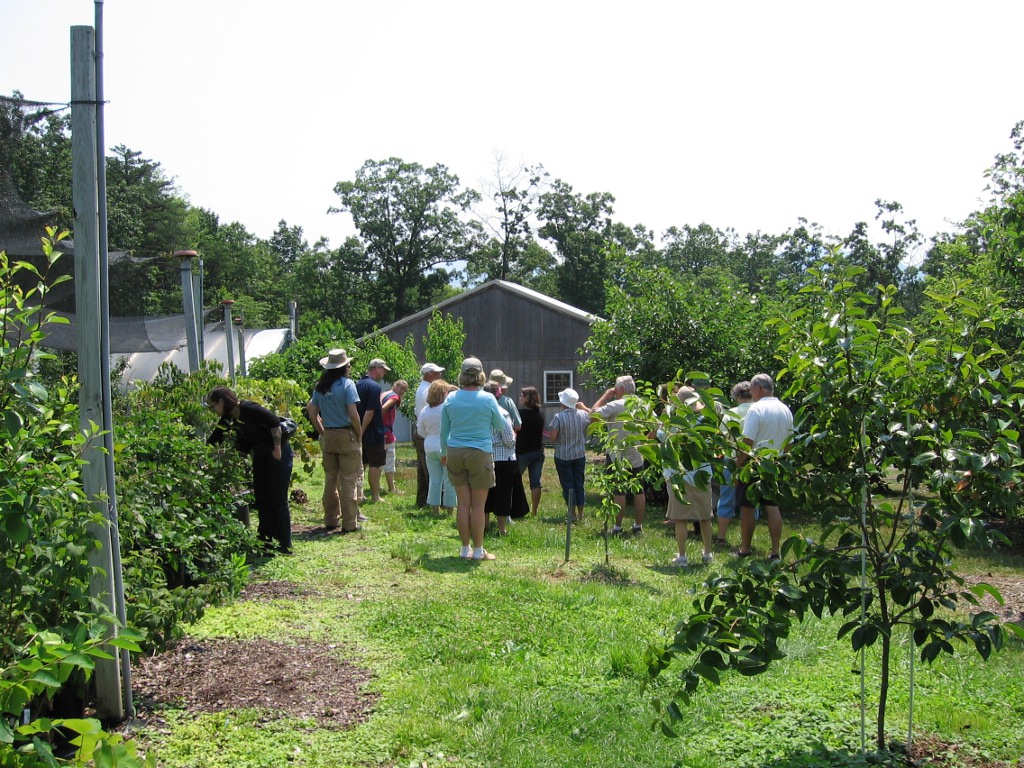Due to import restrictions we are unable to ship Blackberries to Europe...
| Triple Crown Blackberry - Rubus spp |
|---|
 Triple Crown is named for its three attributes; flavor, productivity and vigor. This very hardy variety offers two other attributes; disease resistance and very large berries. The thornless blackberry ripens for about one month from end of July thru August. Semi-erect, the canes can be trellised or pruned to be free standing in summer to an easy picking height of 42". Does well on East and West Coasts and to Homestead, Florida. Space 5' circle or 5' apart in prepared garden beds 5' wide. Zones 5-9.
Triple Crown is named for its three attributes; flavor, productivity and vigor. This very hardy variety offers two other attributes; disease resistance and very large berries. The thornless blackberry ripens for about one month from end of July thru August. Semi-erect, the canes can be trellised or pruned to be free standing in summer to an easy picking height of 42". Does well on East and West Coasts and to Homestead, Florida. Space 5' circle or 5' apart in prepared garden beds 5' wide. Zones 5-9.
View detailed information
|
| Kiowa Blackberry - Rubus spp |
 Kiowa is an extremely large berry and 10 can fill a half-pint container. The best quality and best firmness of all varieties. Long harvest season of 6 weeks. Heavy producer. 1996 University of Arkansas introduction. Thorny bush. Kiowa is a low chilling variety, probably as low as 200 hours. Native Space 5' circle or 5' apart in 5' wide beds. Zones 6-9. Plant Patent #9861
Kiowa is an extremely large berry and 10 can fill a half-pint container. The best quality and best firmness of all varieties. Long harvest season of 6 weeks. Heavy producer. 1996 University of Arkansas introduction. Thorny bush. Kiowa is a low chilling variety, probably as low as 200 hours. Native Space 5' circle or 5' apart in 5' wide beds. Zones 6-9. Plant Patent #9861
View detailed information Please contact our office to see about availability. 434.361.9134
|
| Arapaho Thornless Blackberry - Rubus spp |
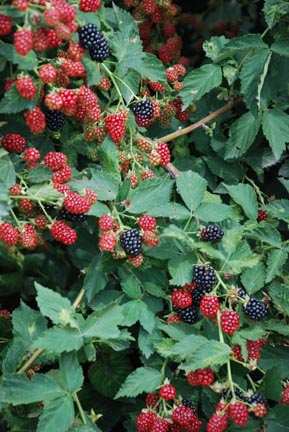 Arapaho is the earliest ripening thornless variety. Lots more to pick at once because it ripens its fruit in a 4 week period. Can be planted farther south. Arapaho needs only 400-500 chill hours.(hours with temperatures below 45 degrees F) Plant Patent # 8510. The outstanding characteristics of Arapaho are its thornless, erect, self supporting canes, good fruit quality, earliness of ripening and its ability to establish a full fruiting row quickly. Zone 6-8.
Arapaho is the earliest ripening thornless variety. Lots more to pick at once because it ripens its fruit in a 4 week period. Can be planted farther south. Arapaho needs only 400-500 chill hours.(hours with temperatures below 45 degrees F) Plant Patent # 8510. The outstanding characteristics of Arapaho are its thornless, erect, self supporting canes, good fruit quality, earliness of ripening and its ability to establish a full fruiting row quickly. Zone 6-8.
View detailed information Please contact our office to see about availability. 434.361.9134
|
| Apache Thorless Blackberry - Rubus spp |
 Apache, Plant Patent #11865 is an erect thornless blackberry similar to Arapaho with larger fruit and seed, ripening 15 days later than Arapaho. Resists orange rust. Fruits are sweet when ripe. Very productive. Tip new canes at 42" during growing season. The newest thornless blackberry introduction from University of Arkansas breeding program. Selected because of its great flavor, good yield and very large fruit. Six week ripening period. Space 5' apart in 5' wide rows. For one plant space plant in a 6' circle. Zone 6-8.
Apache, Plant Patent #11865 is an erect thornless blackberry similar to Arapaho with larger fruit and seed, ripening 15 days later than Arapaho. Resists orange rust. Fruits are sweet when ripe. Very productive. Tip new canes at 42" during growing season. The newest thornless blackberry introduction from University of Arkansas breeding program. Selected because of its great flavor, good yield and very large fruit. Six week ripening period. Space 5' apart in 5' wide rows. For one plant space plant in a 6' circle. Zone 6-8.
View detailed information Please contact our office to see about availability. 434.361.9134
|
| Chester Thornless Blackberry - Rubus Spp |
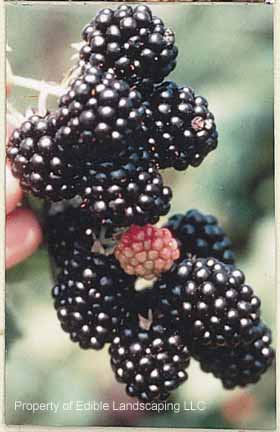 Chester is an early, fine tasting, semi erect thornless blackberry. I remember sampling Chester when it was a numbered seedling at the University of Maryland's Cherry Hill Research facility, and I enthusiastically promoted its flavor. Hardier than many varieties. Fruits are sweet and juicy, though as all blackberries they must be left on the plant until they come easily off the calyx. Zone 6-8. Space 5-6' apart in beds 5' wide.
Chester is an early, fine tasting, semi erect thornless blackberry. I remember sampling Chester when it was a numbered seedling at the University of Maryland's Cherry Hill Research facility, and I enthusiastically promoted its flavor. Hardier than many varieties. Fruits are sweet and juicy, though as all blackberries they must be left on the plant until they come easily off the calyx. Zone 6-8. Space 5-6' apart in beds 5' wide.
View detailed information Please contact our office to see about availability. 434.361.9134
|
| Osage Thornless Blackberry - Rubus species X |
 Osage thornless blackberry is the thirteenth release in a series of erect-growing, high-quality, productive, floricane-fruiting blackberry cultivars developed by the University of Arkansas Division of Agriculture. An enhanced effort in the improvement of flavor in blackberries has been underway in the Arkansas program for a number of years, and Osage was developed with the intention of advancing flavor to a higher level in a thornless blackberry cultivar. Osage ripens mid-early. Average weight usually 6-7 g; soluble solids (sweetness) 11%; mostly round shape. Zone 6 - 8.
Osage thornless blackberry is the thirteenth release in a series of erect-growing, high-quality, productive, floricane-fruiting blackberry cultivars developed by the University of Arkansas Division of Agriculture. An enhanced effort in the improvement of flavor in blackberries has been underway in the Arkansas program for a number of years, and Osage was developed with the intention of advancing flavor to a higher level in a thornless blackberry cultivar. Osage ripens mid-early. Average weight usually 6-7 g; soluble solids (sweetness) 11%; mostly round shape. Zone 6 - 8.
View detailed information Please contact our office to see about availability. 434.361.9134
|
| Prime Ark Freedom Thornless Blackberry - Rubus species X |
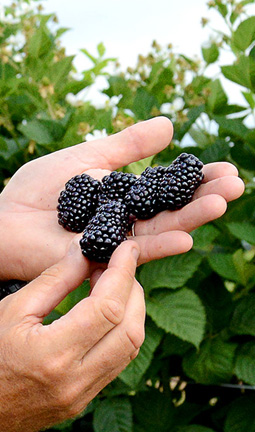 Prime Ark Freedom is the first thornless primocane fruiting blackberry. A blackberry usually grows one year and doesn't fruit until the following season. Freedom fruits this way very early in the season, but then fruits again in the fall where the climate is suitable. Freedom also has exceptional fruit size, good flavor and the plant grows upright and needs little or no staking. Zones 6-8 space 5'circle or 5' apart.
Prime Ark Freedom is the first thornless primocane fruiting blackberry. A blackberry usually grows one year and doesn't fruit until the following season. Freedom fruits this way very early in the season, but then fruits again in the fall where the climate is suitable. Freedom also has exceptional fruit size, good flavor and the plant grows upright and needs little or no staking. Zones 6-8 space 5'circle or 5' apart.
View detailed information Please contact our office to see about availability. 434.361.9134
|
| Prime Ark Traveler Thornless Blackberry - Rubus alegheniensis |
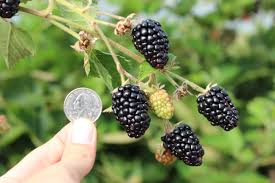 Prime Ark Traveler is the fifth release in a series of erect growing,quality,productive,primocane
Prime Ark Traveler is the fifth release in a series of erect growing,quality,productive,primocanefruiting blackberry cultivars developed by the University of Arkansas. This is the first thornless, primocane fruiting cultivar with shipping quality fruit recommended for the commercial market and local sales. It produces medium to large berries, good yields, and has excellent plant health. A good choice for a not so perishable ripe berry to hold in the fridge for future use. Space 5' apart. Zones 6-8 300 hours chilling View detailed information Please contact our office to see about availability. 434.361.9134
|
Due to import restrictions we are unable to ship Blueberries to CA,...
| Northland Blueberry - Vaccinum corymbosum |
|---|
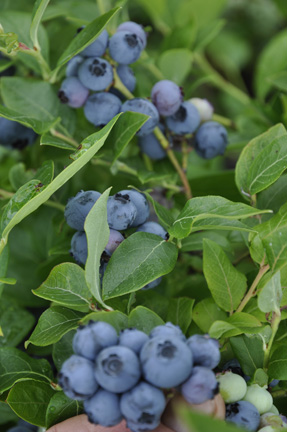 Northland is a northern type blueberry. It is a cross with a northern low bush variety. In the north its low stature makes it hardier than most because it get insulated by snow. 15-20 lbs. of fruit on a mature bush is not uncommon. Medium size berries are of high flavor similar to wild low bush . Height is 3-5' at maturity, space 5' circle. Selected in MN for its dark blue wild flavored berries and low stature. It's an attractive landscape plant with yellow orange fall color. Can be annually pruned because it produces many canes. Native and very hardy. Zones 3-7.
Northland is a northern type blueberry. It is a cross with a northern low bush variety. In the north its low stature makes it hardier than most because it get insulated by snow. 15-20 lbs. of fruit on a mature bush is not uncommon. Medium size berries are of high flavor similar to wild low bush . Height is 3-5' at maturity, space 5' circle. Selected in MN for its dark blue wild flavored berries and low stature. It's an attractive landscape plant with yellow orange fall color. Can be annually pruned because it produces many canes. Native and very hardy. Zones 3-7.
View detailed information Please contact our office to see about availability. 434.361.9134
|
| Yadkin Blueberry - Vaccinium ashei |
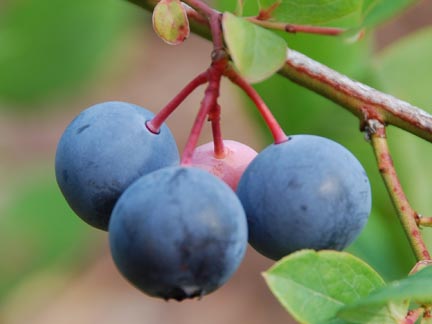 Excellent soil adaption; full, well shaped Southern type blueberry ripening late mid-season. High taste appeal. Native, with red fall leaf color. Space @ 5' circle. Zones 6-9.
Excellent soil adaption; full, well shaped Southern type blueberry ripening late mid-season. High taste appeal. Native, with red fall leaf color. Space @ 5' circle. Zones 6-9. View detailed information Please contact our office to see about availability. 434.361.9134
|
| Tifblue Blueberry - Vaccinum ashei |
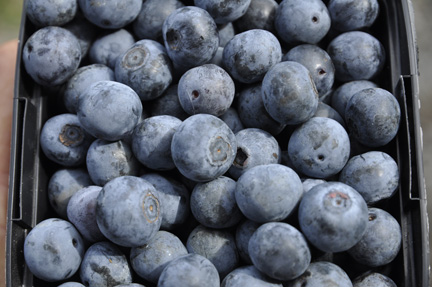 Tifblue is a well known standard for southern blueberries. It is most dependable and adaptable. Beautiful fall leaf color.Pansy blooms contrast well around the base of the plant in the fall. Berries that stay on the bush get sweeter and sweeter and can be picked into September at the nursery. Height 5'-6' in the North; 8'-10' in the South. Ripens in July in central VA. Space 6' circle in zones 6 & 7 and 8' circle in zone 8. Native Zones 6-9.
Tifblue is a well known standard for southern blueberries. It is most dependable and adaptable. Beautiful fall leaf color.Pansy blooms contrast well around the base of the plant in the fall. Berries that stay on the bush get sweeter and sweeter and can be picked into September at the nursery. Height 5'-6' in the North; 8'-10' in the South. Ripens in July in central VA. Space 6' circle in zones 6 & 7 and 8' circle in zone 8. Native Zones 6-9.
View detailed information Please contact our office to see about availability. 434.361.9134
|
| Powderblue Blueberry - Vaccinium ashei |
 Southern Type Blueberry - Late, large, powderblue fruit. Fine distinct taste. Height 5-6' in the North; 8-12' in the South.Space 6' circle in zone 6, and 8' circle in zone 8. Powderblue is adaptable to different soil types and long lived. Powderblue leaves are very ornamental. Ripens in late August in our area. Fruits can stay on the bush into the fall. Native Zones 6-9.
Southern Type Blueberry - Late, large, powderblue fruit. Fine distinct taste. Height 5-6' in the North; 8-12' in the South.Space 6' circle in zone 6, and 8' circle in zone 8. Powderblue is adaptable to different soil types and long lived. Powderblue leaves are very ornamental. Ripens in late August in our area. Fruits can stay on the bush into the fall. Native Zones 6-9.
View detailed information Please contact our office to see about availability. 434.361.9134
|
| Climax Southern Blueberry - Vaccinium ashei |
 Climax is a southern type blueberry with large berries ripening uniformly with a sweet flavor. Ripens about 1 month before Powderblue. Leaves have a blue hint and are very ornamental, turning red in the fall. Everyone should have a Climax in their backyard! Native Zones 7-9.
Climax is a southern type blueberry with large berries ripening uniformly with a sweet flavor. Ripens about 1 month before Powderblue. Leaves have a blue hint and are very ornamental, turning red in the fall. Everyone should have a Climax in their backyard! Native Zones 7-9.
View detailed information Please contact our office to see about availability. 434.361.9134
|
| Oneal Southern Highbush Blueberry - Vaccinium species x |
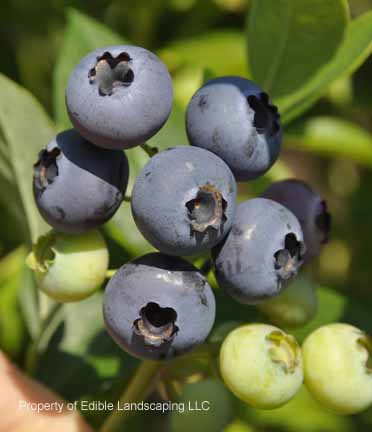 O'Neal's large dark blue fruit is considered the best tasting of the southern highbush varieties and flavor will not deteriorate under hot weather conditions. Fruit size is very large and attractive. Plant height around 6' and well proportioned, O'Neal plants have great ornamental value in the fall when their leaves turn. Widley grown in North Carolina and even South America. Space @ 5' circle. Introduced from NC. Berries sweeten up early. Fall color is orange and wine. Native,needs 500-600 chill hours(temperature time below 45 degrees F) Zones 5-9.
O'Neal's large dark blue fruit is considered the best tasting of the southern highbush varieties and flavor will not deteriorate under hot weather conditions. Fruit size is very large and attractive. Plant height around 6' and well proportioned, O'Neal plants have great ornamental value in the fall when their leaves turn. Widley grown in North Carolina and even South America. Space @ 5' circle. Introduced from NC. Berries sweeten up early. Fall color is orange and wine. Native,needs 500-600 chill hours(temperature time below 45 degrees F) Zones 5-9.
View detailed information Please contact our office to see about availability. 434.361.9134
|
| Sunshine Blue Dwarf Blueberry - Vaccinium ashei x corymbosum |
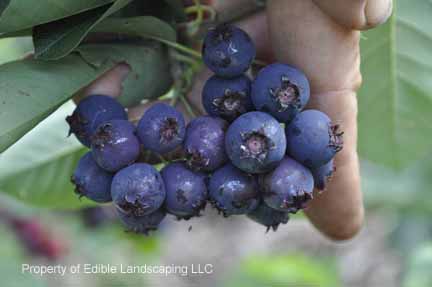 Sunshine Blue is a compact dwarf southern highbush blueberry. Adaptable to different soils and climates, from San Diego to Seattle, from Florida to Pennsylvania. Excellent ornamental value 3' tall. Our best plant for keeping in a large "wine barrel" type pot. Yields are 5 to 10 lbs. of fruit per bush and about 80 berries per cup. Excellent fruit and productive. Very low chill 150 hours, only needs a few days of temperatures below 45 degrees F to begin growing again. So, it's a good choice for indoor winter gardening or greenhouse. Fall color is red. Native Space 4' circle Zones 5-10.
Sunshine Blue is a compact dwarf southern highbush blueberry. Adaptable to different soils and climates, from San Diego to Seattle, from Florida to Pennsylvania. Excellent ornamental value 3' tall. Our best plant for keeping in a large "wine barrel" type pot. Yields are 5 to 10 lbs. of fruit per bush and about 80 berries per cup. Excellent fruit and productive. Very low chill 150 hours, only needs a few days of temperatures below 45 degrees F to begin growing again. So, it's a good choice for indoor winter gardening or greenhouse. Fall color is red. Native Space 4' circle Zones 5-10.
View detailed information
|
| Trentberry (huckleberry blueberry cross) - Vaccinium spp |
 Huckleberry Southern Type - Vigorous and adaptable, a heavy producer of large glossy black fruit about one half inch in diameter. Extremely ornamental when the berries start to ripen with red, green, and black berries ripening over a long season. Ripens with Powderblue. Leaves have good fall color. Height 6 feet. Native, selected by Glenn Melcher of Pineville, La. Space 6-8' circle Zone 6-10.
Huckleberry Southern Type - Vigorous and adaptable, a heavy producer of large glossy black fruit about one half inch in diameter. Extremely ornamental when the berries start to ripen with red, green, and black berries ripening over a long season. Ripens with Powderblue. Leaves have good fall color. Height 6 feet. Native, selected by Glenn Melcher of Pineville, La. Space 6-8' circle Zone 6-10.
View detailed information
|
| Legacy Blueberry - Vaccinium darrowi |
 Legacy is similar to a high quality highbush variety in flavor and yield. Because it's parented by Vaccinium darrowi and Florida 48, Legacy is very adapted to different soil types. Vigorous, upright growth Legacy grows 4' to 6' tall, with foliage that stays evergreen in mild North West winters like Oregon & Washington state. In colder winter areas Legacy leaves turn red in the fall and shed during winter. Legacy grows well in mid Atlantic states including New jersey and North Carolina and Georgia. Ripens early mid-season. Production is high, berries are sweet, light blue and medium large. Has rated highest in flavor trials, with superior flavor and sweetness. Good landscape plant, crimson fall color, heat and drought tolerant. Fall Saffron crocus with their blue bloom lend a pleasing accent to the blueberry bed in Zones 7-8. Introduced in 1993 from USDA, Beltsville, MD. Space 4' to 6' circle. Zone 5-8.
Legacy is similar to a high quality highbush variety in flavor and yield. Because it's parented by Vaccinium darrowi and Florida 48, Legacy is very adapted to different soil types. Vigorous, upright growth Legacy grows 4' to 6' tall, with foliage that stays evergreen in mild North West winters like Oregon & Washington state. In colder winter areas Legacy leaves turn red in the fall and shed during winter. Legacy grows well in mid Atlantic states including New jersey and North Carolina and Georgia. Ripens early mid-season. Production is high, berries are sweet, light blue and medium large. Has rated highest in flavor trials, with superior flavor and sweetness. Good landscape plant, crimson fall color, heat and drought tolerant. Fall Saffron crocus with their blue bloom lend a pleasing accent to the blueberry bed in Zones 7-8. Introduced in 1993 from USDA, Beltsville, MD. Space 4' to 6' circle. Zone 5-8.
View detailed information Please contact our office to see about availability. 434.361.9134
|
| Columbus Blueberry - Vaccinium ashei |
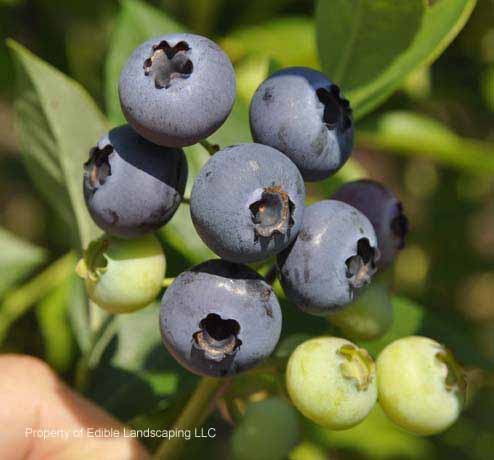 Columbus is a new southern type blueberry introduced in 2005 from NC State. A high yielding, superior flavored fruit, more sweeter than tangy and juicer than most, ripening a few days earlier than Powderblue, about 6 weeks later than Star. Fruit size is MONSTER. Berry quality judged by many as the best with excellent keeping qualities. Berries are resistant to rain related cracking. Leaves turn bright red in the fall. Height 6' to 7'. Space 6' circle. Zones 7a - 9b
Columbus is a new southern type blueberry introduced in 2005 from NC State. A high yielding, superior flavored fruit, more sweeter than tangy and juicer than most, ripening a few days earlier than Powderblue, about 6 weeks later than Star. Fruit size is MONSTER. Berry quality judged by many as the best with excellent keeping qualities. Berries are resistant to rain related cracking. Leaves turn bright red in the fall. Height 6' to 7'. Space 6' circle. Zones 7a - 9b
View detailed information
|
| Premier Blueberry - Vaccinium ashei |
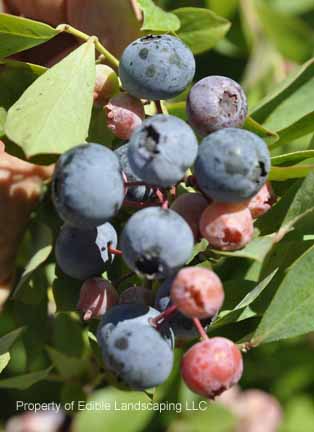 A very popular southern type blueberry with bright green foliage and very ornamental. Height 6' to 10'. Yields are 8 to 16lbs. per bush. Can fruit without a pollinator. Space 7' circle Zones 7 to 9
A very popular southern type blueberry with bright green foliage and very ornamental. Height 6' to 10'. Yields are 8 to 16lbs. per bush. Can fruit without a pollinator. Space 7' circle Zones 7 to 9
View detailed information
|
| Sharpblue Blueberry - Vaccinium corymbosum |
 We've grown Sharpblue at the nursery for many years. It's bush size is only about 4' and compact, so it fits into border plantings or planted close to the house. It ripens with our earlier berries and has fruited for many years at Edible. It is a proven variety in southern states being introduced from the University of Florida in 1976. Sharpblue has a six week harvest period at least, ripening about half its berries the first few weeks. Chill hours are only 150 hours. Berries are dark blue about dime size with excellent flavor and texture. Space about 4'-6' circle, depending on climate and location. Zone 7-10.
We've grown Sharpblue at the nursery for many years. It's bush size is only about 4' and compact, so it fits into border plantings or planted close to the house. It ripens with our earlier berries and has fruited for many years at Edible. It is a proven variety in southern states being introduced from the University of Florida in 1976. Sharpblue has a six week harvest period at least, ripening about half its berries the first few weeks. Chill hours are only 150 hours. Berries are dark blue about dime size with excellent flavor and texture. Space about 4'-6' circle, depending on climate and location. Zone 7-10.View detailed information Please contact our office to see about availability. 434.361.9134
|
| Reka Northern Highbush Blueberry - Vaccinium corymbosum L |
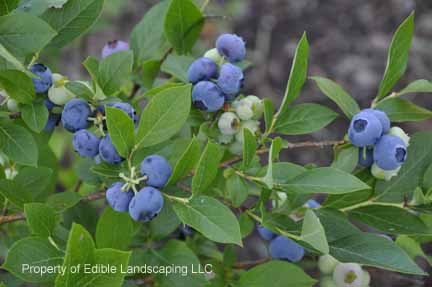 Reka is a very early, large, delicious highbush blueberry. Introduced from New Zealand it is adaptable to different soil types. Adapts much better than Duke blueberry that ripens at the same time. Leaves are burgundy red in the fall. 4' to 6' height, space 5' apart in rows or 5' circles. Zones 4-7
Reka is a very early, large, delicious highbush blueberry. Introduced from New Zealand it is adaptable to different soil types. Adapts much better than Duke blueberry that ripens at the same time. Leaves are burgundy red in the fall. 4' to 6' height, space 5' apart in rows or 5' circles. Zones 4-7
View detailed information
|
| Pink Lemonade Blueberry - Vaccinium ashei species X |
 Pink Lemonade is a pink fruiting variety with excellent fruit. Similar to southern type blueberry in shape and adaptability. Stunning ornamental, vigorous and productive and as nutritious as other blueberries, and crazy sweet. Space 6' circle Zone 6-8
Pink Lemonade is a pink fruiting variety with excellent fruit. Similar to southern type blueberry in shape and adaptability. Stunning ornamental, vigorous and productive and as nutritious as other blueberries, and crazy sweet. Space 6' circle Zone 6-8
View detailed information
|
| Vernon Blueberry - Vaccinium ashei Reade |
 Vernon blueberry is a new southern type variety that is hardy and adaptable. The firm berries are rated good to excellent flavor and large berry size. One of its best characteristics is a favorable blooming time avoiding late frosts. Vernon is self fertile and can benefit from another variety. Vernon has excellent plant vigor and a high and consistent yield. Ripens early to mid season. Introduced from the University of Georgia. Space 5' circle Zones 6-8
Vernon blueberry is a new southern type variety that is hardy and adaptable. The firm berries are rated good to excellent flavor and large berry size. One of its best characteristics is a favorable blooming time avoiding late frosts. Vernon is self fertile and can benefit from another variety. Vernon has excellent plant vigor and a high and consistent yield. Ripens early to mid season. Introduced from the University of Georgia. Space 5' circle Zones 6-8
View detailed information
|
| Ochlockonee Blueberry - Vaccinium ashei |
 Ochlockonee introduced from the University of Georgia, is the new leading variety for late season Rabbiteye production. We have picked fruit into September at the nursery. Planted with Powderblue for pollination, Ochlockonee has consistent yields of firm, flavorful berries, larger than Powderblue. Field observations indicate Ochlockonee is more resistant to bacterial canker than other Rabbiteyes. It is recommended where a late delicious fresh fruit is desired. Ochlockonee (ok-LAHK-uh-nee),named after the Ochlockonee River in south Georgia,is a late season rabbiteye blueberry that was released in 2002. Plants of Ochlockonee are vigorous and upright. They produce abundant fruiting stems annually with only moderate growth. Ochlockonee is very productive in yield,substantially exceeding Tifblue,a widely grown older standard variety. Berries of Ochlockonee ripen about one week after Tifblue, and are larger in size. Other important fruit characters are color, firmness, and flavor, similar to Tifblue and Powderblue. Plants of Ochlockonee generally flower late enough to escape spring freezes in south and middle Georgia. The estimated chill requirement of the variety is 650 to 700 hours. The variety can be planted alone and fruiting is enhanced with other rabbiteye blueberries for cross pollination such as Powderblue, Tifblue, and Vernon. Leaves have great red fall color. Zone 7 - 10.
Ochlockonee introduced from the University of Georgia, is the new leading variety for late season Rabbiteye production. We have picked fruit into September at the nursery. Planted with Powderblue for pollination, Ochlockonee has consistent yields of firm, flavorful berries, larger than Powderblue. Field observations indicate Ochlockonee is more resistant to bacterial canker than other Rabbiteyes. It is recommended where a late delicious fresh fruit is desired. Ochlockonee (ok-LAHK-uh-nee),named after the Ochlockonee River in south Georgia,is a late season rabbiteye blueberry that was released in 2002. Plants of Ochlockonee are vigorous and upright. They produce abundant fruiting stems annually with only moderate growth. Ochlockonee is very productive in yield,substantially exceeding Tifblue,a widely grown older standard variety. Berries of Ochlockonee ripen about one week after Tifblue, and are larger in size. Other important fruit characters are color, firmness, and flavor, similar to Tifblue and Powderblue. Plants of Ochlockonee generally flower late enough to escape spring freezes in south and middle Georgia. The estimated chill requirement of the variety is 650 to 700 hours. The variety can be planted alone and fruiting is enhanced with other rabbiteye blueberries for cross pollination such as Powderblue, Tifblue, and Vernon. Leaves have great red fall color. Zone 7 - 10.
View detailed information Sorry, we are currently out of this item, please check back!
|
| Arlen Blueberry - Vaccinium corymbosum x |
 Arlen originated from the University of North Carolina Agriculture Research Station. A highbush type cultivar at a height of 5-6 feet at maturity. Very upright, with good vigor, the plants are resistant to stem blight disease (Botryosphaeria dothidea). Ripening is 7 days later than Legacy,and is considered late ripening. Yields in Chattsworth, New Jersey in 2006, were 15 pounds per plant, and have been consistent in prior years. The berry size is medium to large and very attractive. The flavor has distinct aromas, high sugar, and small acidity, reminiscent of the true blueberry. The fruits also appear to have resistance to anthroacnose fruit rot, (Colletotrichum spp.). Fruits exhibit a long shelf life of storage.Leaf color in the fall is fiery red. Zones 5-8. Hardy and adapts well to California and Pacific Northwest. Space 5' circle
Arlen originated from the University of North Carolina Agriculture Research Station. A highbush type cultivar at a height of 5-6 feet at maturity. Very upright, with good vigor, the plants are resistant to stem blight disease (Botryosphaeria dothidea). Ripening is 7 days later than Legacy,and is considered late ripening. Yields in Chattsworth, New Jersey in 2006, were 15 pounds per plant, and have been consistent in prior years. The berry size is medium to large and very attractive. The flavor has distinct aromas, high sugar, and small acidity, reminiscent of the true blueberry. The fruits also appear to have resistance to anthroacnose fruit rot, (Colletotrichum spp.). Fruits exhibit a long shelf life of storage.Leaf color in the fall is fiery red. Zones 5-8. Hardy and adapts well to California and Pacific Northwest. Space 5' circleView detailed information
|
| Emerald Blueberry - Vacinnium sp. Hybrid |
 This blueberry resulting from a cross of a North Carolina and Florida berry is an adaptable 200 chill hour variety. It seems it is not widely known that it grows well in VA. Lucky us. Extra large, early, mild sweet berry that ripens just before Star, which is a good mate for Emerald. With Star it will produce more fruit. Plant Patient 12,165. Round, spreading bush, pretty in the landscape. Zones 7-9 Space 5' circle
This blueberry resulting from a cross of a North Carolina and Florida berry is an adaptable 200 chill hour variety. It seems it is not widely known that it grows well in VA. Lucky us. Extra large, early, mild sweet berry that ripens just before Star, which is a good mate for Emerald. With Star it will produce more fruit. Plant Patient 12,165. Round, spreading bush, pretty in the landscape. Zones 7-9 Space 5' circle
View detailed information
|
| Berried Treasure Native Box Huckleberry (aka Whortleberry) - Gaylussacia brachycera |
 Boxed huckleberry ( Gaylussacia brachycera ) is a low shrub with branches that rise to about 12" to 18" from underground, creeping stems, known as rhizomes. Its glossy, leathery leaves lack the resinous dots of other huckleberries, and it holds its leaves year-round while the others are deciduous. Its flowers, white or pinkish, are bell shaped. Fruits are similar to blueberries, but have fewer, larger seeds. Boxed huckleberry is on the Pennsylvania threatened plant species list. Zone 5 - 7.
Boxed huckleberry ( Gaylussacia brachycera ) is a low shrub with branches that rise to about 12" to 18" from underground, creeping stems, known as rhizomes. Its glossy, leathery leaves lack the resinous dots of other huckleberries, and it holds its leaves year-round while the others are deciduous. Its flowers, white or pinkish, are bell shaped. Fruits are similar to blueberries, but have fewer, larger seeds. Boxed huckleberry is on the Pennsylvania threatened plant species list. Zone 5 - 7.
View detailed information Sorry, we are currently out of this item, please check back!
|
| Draper Blueberry - Vaccinium corymbosum x |
 Draper has become a standout variety in mid and high chill climates. Draper has a compact habit(4' height), ripens early to mid-season, is highly productive as a young plant and has outstanding quality fruit. Draper has exceptionally firm berries and concentrates its ripening. It is extremely fast to hand-pick since berries are uniform ripening. After only a few years of being available, Draper fruit has become a leading choice for growers. The sweet berry ripens mid season. Space 4-5' circle Zones 5-8
Draper has become a standout variety in mid and high chill climates. Draper has a compact habit(4' height), ripens early to mid-season, is highly productive as a young plant and has outstanding quality fruit. Draper has exceptionally firm berries and concentrates its ripening. It is extremely fast to hand-pick since berries are uniform ripening. After only a few years of being available, Draper fruit has become a leading choice for growers. The sweet berry ripens mid season. Space 4-5' circle Zones 5-8
View detailed information Please contact our office to see about availability. 434.361.9134
|
| Blue Horizon Native Huckleberry - Vaccinium ovatum |
 Blue Horizon Huckleberry is a low shrub, spreading by creeping stems, known as rhizomes. Its glossy, leathery leaves lack the resinous dots of other huckleberries, and it holds its leaves year-round while the others are deciduous. Its flowers, white or pinkish, are bell shaped. Fruits are similar to blueberries.
Blue Horizon Huckleberry is a low shrub, spreading by creeping stems, known as rhizomes. Its glossy, leathery leaves lack the resinous dots of other huckleberries, and it holds its leaves year-round while the others are deciduous. Its flowers, white or pinkish, are bell shaped. Fruits are similar to blueberries.
View detailed information
|
| Ben Lear Cranberry - Vaccinium macracarpon |
|---|
 Ben Lear is a wild clone from WI. Early ripening, Large to medium bright red fruit. Very productive.Native. Space 1' circle. Clay soils should have 80% moist peat worked into top 4" of soil and mulched 1-2" with aged mulch for all cranberry varieties. Zones 3-7.
Ben Lear is a wild clone from WI. Early ripening, Large to medium bright red fruit. Very productive.Native. Space 1' circle. Clay soils should have 80% moist peat worked into top 4" of soil and mulched 1-2" with aged mulch for all cranberry varieties. Zones 3-7.
View detailed information
|
| Stevens Cranberry - Vaccinium macrocarpon |
 Stevens cranberry is a very popular variety being planted commercially in the northwest and the northeastern US. Large fruit. Native. space 1' circle Zones 3-7.
Stevens cranberry is a very popular variety being planted commercially in the northwest and the northeastern US. Large fruit. Native. space 1' circle Zones 3-7.
View detailed information Sorry, we are currently out of this item, please check back!
|
| Native Elderberry - Sambuscus canadensis |
|---|
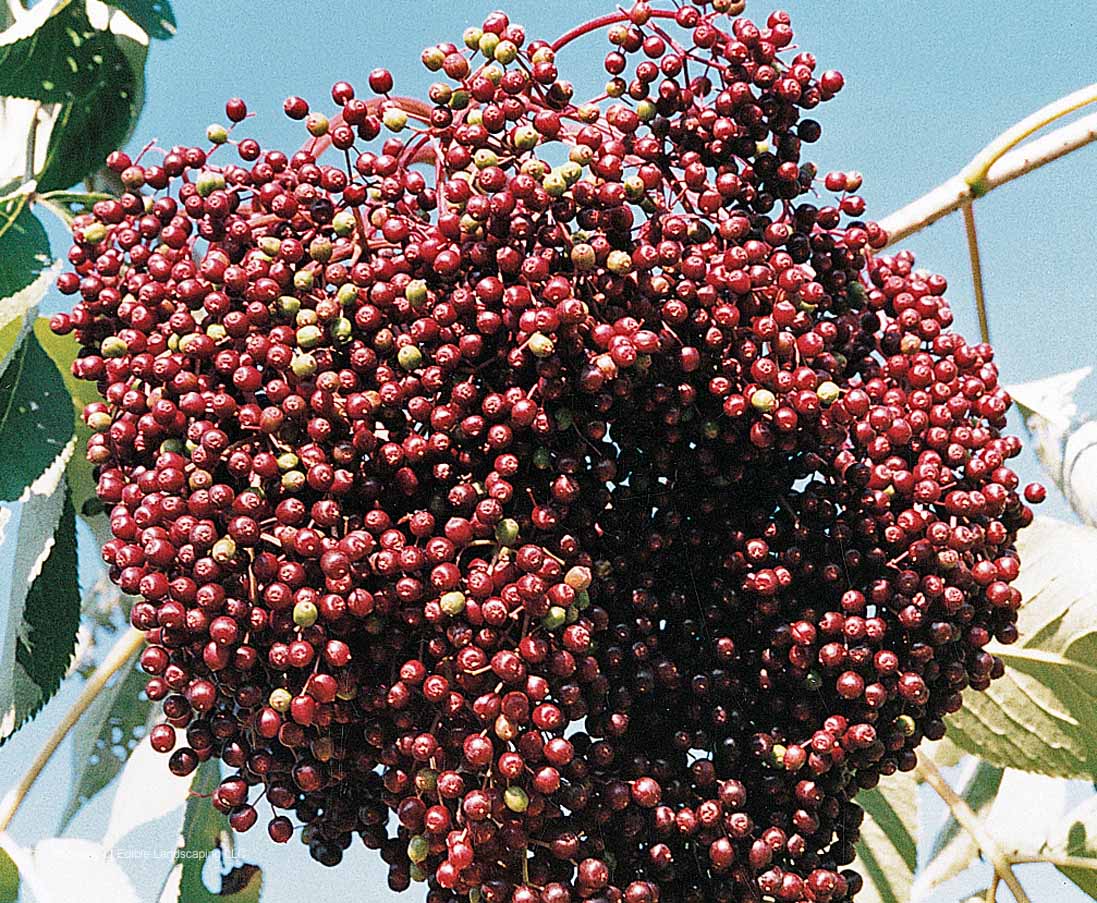 Similar in all respects to Adams elderberry, and perhaps a seedling of Adams. This vigorous seedling grows at our nursery and is showy and productive with large fruit clusters ripening for a 4-6 period in summer. Space 10' circle Zone 3-9
Similar in all respects to Adams elderberry, and perhaps a seedling of Adams. This vigorous seedling grows at our nursery and is showy and productive with large fruit clusters ripening for a 4-6 period in summer. Space 10' circle Zone 3-9
View detailed information
|
| Invicta Gooseberry - Ribes grossularia |
|---|
 Invicta is the best of the green fruit gooseberry varieties for fresh eating. The berries are the size of small plums and have a very pleasant flavor. A very sweet gooseberry, ripening late spring or early summer. Resistant to mildew and frost. Susceptible to leaf spot, so plant in an area with good air drainage. In humid areas can loose leaves in August but grows well the following spring. A newer variety introduced from Europe. Space @ 4' circles. Zones 4-7.
Invicta is the best of the green fruit gooseberry varieties for fresh eating. The berries are the size of small plums and have a very pleasant flavor. A very sweet gooseberry, ripening late spring or early summer. Resistant to mildew and frost. Susceptible to leaf spot, so plant in an area with good air drainage. In humid areas can loose leaves in August but grows well the following spring. A newer variety introduced from Europe. Space @ 4' circles. Zones 4-7.
View detailed information
|
| Glenndale Gooseberry - Ribes hirtellum x grossularia |
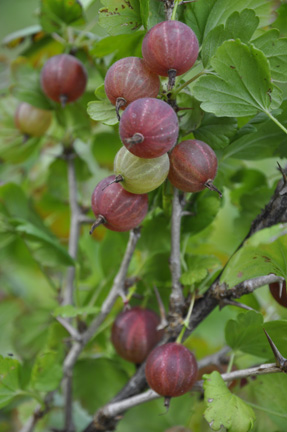 This gooseberry stands hot summers better than most gooseberries. Glenndale is most disease resistant and immune to mildew. Derived of European and Native American parents with great vigor and productive fruiting. Purple-red fruit, fine flavor and thorny, ripening early. Height 5-6' and spread to 5'. Zone 4-7.
This gooseberry stands hot summers better than most gooseberries. Glenndale is most disease resistant and immune to mildew. Derived of European and Native American parents with great vigor and productive fruiting. Purple-red fruit, fine flavor and thorny, ripening early. Height 5-6' and spread to 5'. Zone 4-7.
View detailed information
|
| Black Velvet Gooseberry - Ribes grossularia |
 The deep purple fruits are the size of seedless grapes. They are very vigorous in growth. Flavor is very good to excellent when they ripen on the bush. Black Velvet has won awards for its superb qualities and disease and mildew resistance. Space 5' circle. Zones 4-7.
The deep purple fruits are the size of seedless grapes. They are very vigorous in growth. Flavor is very good to excellent when they ripen on the bush. Black Velvet has won awards for its superb qualities and disease and mildew resistance. Space 5' circle. Zones 4-7.
View detailed information
|
| Jahns Prairie Gooseberry - Riber oxyacanthoides L. |
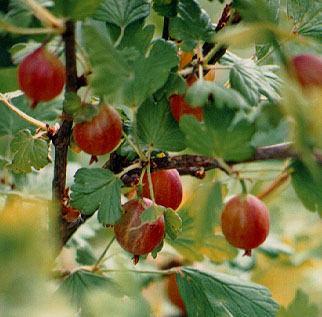 Jahn's Prairie is disease resistant and produces high quality, dark red, dessert gooseberries. This plant was selected by Dr. Otto Jahn from a native population of the species growing in Alberta, Canada. The green fruit turns red-pink upon ripening. The fresh fruit quality is equivalent to European gooseberries. The plant, which grows to 5 feet, has an upright growth habit with some sprawling branches. The leaf shape is similar to European Hawthorne. Jahn's Prairie gooseberry resists powdery mildew, is free of leaf spot and Botrytis (grey mold) on its fruit. No White Pine Blister Rust has been observed on the plant or insect damage from aphids or saw-flies. Space 5' circles Zone 3-7
Jahn's Prairie is disease resistant and produces high quality, dark red, dessert gooseberries. This plant was selected by Dr. Otto Jahn from a native population of the species growing in Alberta, Canada. The green fruit turns red-pink upon ripening. The fresh fruit quality is equivalent to European gooseberries. The plant, which grows to 5 feet, has an upright growth habit with some sprawling branches. The leaf shape is similar to European Hawthorne. Jahn's Prairie gooseberry resists powdery mildew, is free of leaf spot and Botrytis (grey mold) on its fruit. No White Pine Blister Rust has been observed on the plant or insect damage from aphids or saw-flies. Space 5' circles Zone 3-7
View detailed information
|
| Hinnomaki Red Gooseberry - Ribes uva-crispa 'Hinnomaki Red' |
|
Hinnomaki is a Finnish gooseberry. Hinnomaki's delicious large red berries have a tart skin and juicy, sweet flesh, said to be the sweetest of the gooseberries. Foliage is grape leaf shaped, dark green in the summer and red in the fall, and is resistant to powdery mildew. Hinnomaki is highly ornamental as well as delicious! Zone 3-7
View detailed information
|
| Jeanne Gooseberry - Ribes uva-crispa L |
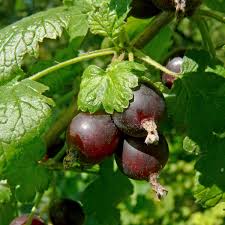 Jeanne is a late-ripening, dark red, dessert gooseberry with an unknown European pedigree. Observed for 24 years at the USDA National Germplasm Repository, Corvallis, Oregon. Its origin prior to Corvallis is undocumented. Jeanne was named in honor of the late Ms. Cheryl Jeanne Gunning, who worked in the tissue culture laboratory of the NCGR from 1981 to 1985. Jeanne's buds break late and full bloom occurs a week later than most cultivars. About one to two weeks after blooms of Invicta. The fruit ripens from mid to late July, about one week later than the fruit of Invicta, and is ripe for about one week. The fruit ripens to a deep red. The fruit weighed about 5.0 g/berry (7 year average), tended to be smaller than those of Invicta, but large for a red fruit. The yield from Jeanne is higher than from many other gooseberry varieties. The fruit taste is full and sweet. The plant tends to be somewhat spreading, growing to 5' high and 5' wide, and has single, nodal thorns. The leaves and fruits of Jeanne are highly resistant to powdery mildew. The leaves are also highly resistant to white pine blister rust. Damage from aphids or defoliation from sawflies is less severe on Jeanne than in other European gooseberries. Black leaf spot is visible on some leaves in summer, but does not appear to cause plant damage. We recommend this cultivar for home plantings or commercial gooseberry production in the Pacific Northwestern United States and in other temperate climate zones. We expect that this cultivar will be good for organic production because of its pest resistance and very good fruit quality. It could extend the production season of red gooseberries.
Jeanne is a late-ripening, dark red, dessert gooseberry with an unknown European pedigree. Observed for 24 years at the USDA National Germplasm Repository, Corvallis, Oregon. Its origin prior to Corvallis is undocumented. Jeanne was named in honor of the late Ms. Cheryl Jeanne Gunning, who worked in the tissue culture laboratory of the NCGR from 1981 to 1985. Jeanne's buds break late and full bloom occurs a week later than most cultivars. About one to two weeks after blooms of Invicta. The fruit ripens from mid to late July, about one week later than the fruit of Invicta, and is ripe for about one week. The fruit ripens to a deep red. The fruit weighed about 5.0 g/berry (7 year average), tended to be smaller than those of Invicta, but large for a red fruit. The yield from Jeanne is higher than from many other gooseberry varieties. The fruit taste is full and sweet. The plant tends to be somewhat spreading, growing to 5' high and 5' wide, and has single, nodal thorns. The leaves and fruits of Jeanne are highly resistant to powdery mildew. The leaves are also highly resistant to white pine blister rust. Damage from aphids or defoliation from sawflies is less severe on Jeanne than in other European gooseberries. Black leaf spot is visible on some leaves in summer, but does not appear to cause plant damage. We recommend this cultivar for home plantings or commercial gooseberry production in the Pacific Northwestern United States and in other temperate climate zones. We expect that this cultivar will be good for organic production because of its pest resistance and very good fruit quality. It could extend the production season of red gooseberries.
View detailed information Sorry, we are currently out of this item, please check back!
|
| Josta Berry Black - Ribes grossularia x nigrum |
|---|
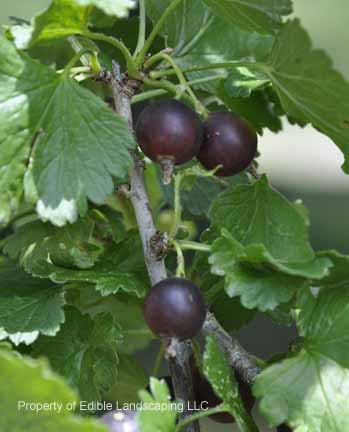 The black fruiting Josta is a new unique hybrid from Europe. A gooseberry - black currant cross. Vigorous and healthy, Josta shows off the best traits of each parent. Fruits later in life than most Ribes usually the third or forth year. No thorns, no pungent aroma, 1/2" fruit good for freezing. Space 5' apart. Rust resistant with little or no pruning required. The upright bush is pretty with large dark green leaves. Height 4'-7'. 3 and 5 and 7 gallon size usually fruiting in the container. Zones 3-8.
The black fruiting Josta is a new unique hybrid from Europe. A gooseberry - black currant cross. Vigorous and healthy, Josta shows off the best traits of each parent. Fruits later in life than most Ribes usually the third or forth year. No thorns, no pungent aroma, 1/2" fruit good for freezing. Space 5' apart. Rust resistant with little or no pruning required. The upright bush is pretty with large dark green leaves. Height 4'-7'. 3 and 5 and 7 gallon size usually fruiting in the container. Zones 3-8.
View detailed information Please contact our office to see about availability. 434.361.9134
|
| Koralle Lingonberry - Vaccinium vitis-ideaea |
|---|
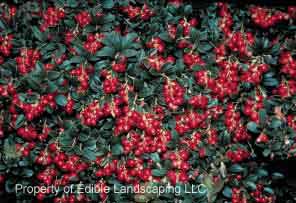 Koralle lingonberry was released in 1969 from Holland as an ornamental ground cover, only to become a leading commercial variety for its fruit. This highly praised European plant is ornamental in flower, leaf, and fruit. Grow them as you do blueberries. Their planting bed must be well prepared with peat and at least one year old wood mulch. Lingonberries are very particular about this. They may be set as individual specimens, in rows, or planted together to form a solid ground cover from 8" to 12" tall. Bright red berries set against dense dark leaves. Berries can be picked into the late fall and taste very good. The light red fruits can stay on the plant for several weeks without deterioration. Zones 2-8. In hot summer areas plant in some shade. Two harvest periods are possible in one season. Space 1' circles
Koralle lingonberry was released in 1969 from Holland as an ornamental ground cover, only to become a leading commercial variety for its fruit. This highly praised European plant is ornamental in flower, leaf, and fruit. Grow them as you do blueberries. Their planting bed must be well prepared with peat and at least one year old wood mulch. Lingonberries are very particular about this. They may be set as individual specimens, in rows, or planted together to form a solid ground cover from 8" to 12" tall. Bright red berries set against dense dark leaves. Berries can be picked into the late fall and taste very good. The light red fruits can stay on the plant for several weeks without deterioration. Zones 2-8. In hot summer areas plant in some shade. Two harvest periods are possible in one season. Space 1' circles
View detailed information Please contact our office to see about availability. 434.361.9134
|
Due to import restrictions we are unable to ship Raspberries to Europe...
| Heritage Red Fall Raspberry - Rubus idaeus |
|---|
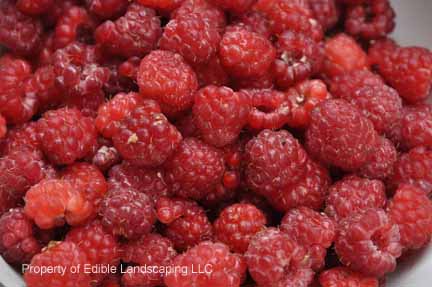 Heritage is the most popular everbearing variety with excellent red fruit. Can be cultivated for spring and fall crops especially in the north. Needs no staking, if mowed to the ground early each spring. Heritage will bear a large crop from new growth from August to late fall in VA. Space 3' apart in 5' wide beds of good garden soil. Zones 3-9.
Heritage is the most popular everbearing variety with excellent red fruit. Can be cultivated for spring and fall crops especially in the north. Needs no staking, if mowed to the ground early each spring. Heritage will bear a large crop from new growth from August to late fall in VA. Space 3' apart in 5' wide beds of good garden soil. Zones 3-9.
View detailed information Please contact our office to see about availability. 434.361.9134
|
| Caroline Everbearing Raspberry - Rubus species(ideaus) |
 Caroline is a large, conic, well-flavored, red raspberry. More disease resistant and with larger, earlier fruits than most everbearers. Sweeter fruits than most red raspberries. Ripens August til frost at the nursery, but responds to warmer temperatures and ripens earlier farther south. Several plants are usually planted 3' apart in rows 5' wide. One plant, space in the middle of a 5' circle of well prepared garden soil. Canes average 3' to 6' tall. Zones 5-9. (Plant Patent #10412)
Caroline is a large, conic, well-flavored, red raspberry. More disease resistant and with larger, earlier fruits than most everbearers. Sweeter fruits than most red raspberries. Ripens August til frost at the nursery, but responds to warmer temperatures and ripens earlier farther south. Several plants are usually planted 3' apart in rows 5' wide. One plant, space in the middle of a 5' circle of well prepared garden soil. Canes average 3' to 6' tall. Zones 5-9. (Plant Patent #10412)
View detailed information Sorry, we are currently out of this item, please check back!
|
| Jewel Black Raspberry - Rubus occidentalis |
|
View detailed information Please contact our office to see about availability. 434.361.9134
|
| Wineberry Raspberry - Rubus phoenicolasius |
 Originally from Japan, Wineberries have naturalized here in the East. A summertime treat fruiting after the spring red raspberries and before the fall ones. Very acclimated. Will fruit in the shade. High flavor, excellent fresh. Zones 6-8. Space 6' circle. Height 5' and arching. Produces on two-year wood.
Originally from Japan, Wineberries have naturalized here in the East. A summertime treat fruiting after the spring red raspberries and before the fall ones. Very acclimated. Will fruit in the shade. High flavor, excellent fresh. Zones 6-8. Space 6' circle. Height 5' and arching. Produces on two-year wood.
View detailed information Sorry, we are currently out of this item, please check back!
|
| Double Gold Raspberry - Rubus ideaus |
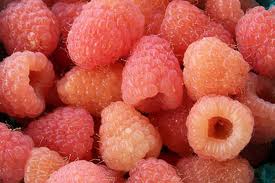 Double Gold Raspberry is a flavorful raspberry, vigorous, and disease resistant. Double Gold produces a deeply blushed, golden champagne-colored fruit with a distinctive conical shape. The "double" in its name is for its two harvests per season. The first year of planting, the initial crop is produced in the fall on the tips of current year's canes, and a second crop is produced farther down the same canes the following summer. In taste tests, Double Gold has been a favorite. Fruit is too delicate for long distance shipping, therefore a good choice for home gardeners. Double Gold is resistant to Phytophthora root rot as well as most of the common leaf diseases. This new variety should become very popular because of its flavor, disease resistance and productivity. Zone 5-8 Space 5' circle or 3' apart in 5' wide beds.
Double Gold Raspberry is a flavorful raspberry, vigorous, and disease resistant. Double Gold produces a deeply blushed, golden champagne-colored fruit with a distinctive conical shape. The "double" in its name is for its two harvests per season. The first year of planting, the initial crop is produced in the fall on the tips of current year's canes, and a second crop is produced farther down the same canes the following summer. In taste tests, Double Gold has been a favorite. Fruit is too delicate for long distance shipping, therefore a good choice for home gardeners. Double Gold is resistant to Phytophthora root rot as well as most of the common leaf diseases. This new variety should become very popular because of its flavor, disease resistance and productivity. Zone 5-8 Space 5' circle or 3' apart in 5' wide beds.
View detailed information Sorry, we are currently out of this item, please check back!
|
| Glencoe Purple Thornless Raspberry - Rubus species X |
 Glencoe was developed by the Scottish Crop Research Institute. A cross of native black raspberry and red raspberry. Flavor is reported to be excellent and plant can be bushy and ideal for containers or the home garden. One plant will produce a multi-stemmed clump, so it can be a space saver and not spread as red and yellow raspberries do. Tip prune in the summer at 30 inches to keep as a bush. Remove old canes after they've fruited. Resistant to Verticillium Wilt. Zones 4-8 Space 2-3' circles.
Glencoe was developed by the Scottish Crop Research Institute. A cross of native black raspberry and red raspberry. Flavor is reported to be excellent and plant can be bushy and ideal for containers or the home garden. One plant will produce a multi-stemmed clump, so it can be a space saver and not spread as red and yellow raspberries do. Tip prune in the summer at 30 inches to keep as a bush. Remove old canes after they've fruited. Resistant to Verticillium Wilt. Zones 4-8 Space 2-3' circles.
View detailed information Sorry, we are currently out of this item, please check back!
|
| Ohio Treasure Black Raspberry - Rubus occidentalis |
 The first black raspberry that gives two crops a season. Ohio Treasure's berries have a pleasant flavor with a good balance of sweetness and freshness, ripening a spring and fall crop. The fruit quality is very good on spring and fall crops. The plants can also be mowed to the ground each spring for a summer crop that lasts till frost. Zone 3 - 8.
The first black raspberry that gives two crops a season. Ohio Treasure's berries have a pleasant flavor with a good balance of sweetness and freshness, ripening a spring and fall crop. The fruit quality is very good on spring and fall crops. The plants can also be mowed to the ground each spring for a summer crop that lasts till frost. Zone 3 - 8.
View detailed information
|
| Crimson Night Raspberry - Rubus occidentalis 'Crimson Night' |
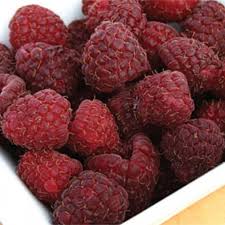 Crimson Night raspberry is a great flavored fruit and a welcomed surprise to all that have tried it. Fruits are large and dark red color bursting with raspberry pazzazz. Crimson Night is a new spring and fall bearing variety from Cornell and is very ornamental plant with dark purple canes.Zones 4-8 Space 3' apart in 5' wide beds.
Crimson Night raspberry is a great flavored fruit and a welcomed surprise to all that have tried it. Fruits are large and dark red color bursting with raspberry pazzazz. Crimson Night is a new spring and fall bearing variety from Cornell and is very ornamental plant with dark purple canes.Zones 4-8 Space 3' apart in 5' wide beds.
View detailed information Sorry, we are currently out of this item, please check back!
|
Due to import restrictions we are unable to ship Strawberries to Europe...
| Tristar Everbearing Strawberry - Fragaria annassa |
|---|
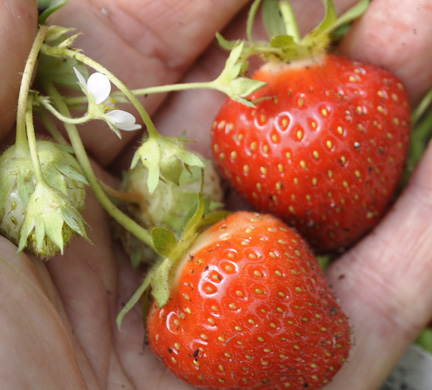 Tristar is one of the best flavored continuous bearing strawberries from the eastern U.S. Disease resistant and productive. Introduced by USDA Beltsville and the University of Maryland in 1981, Tristar is still a very popular strawberry. The plant spreads by runners and makes a fine row. Zones 5-7.
Tristar is one of the best flavored continuous bearing strawberries from the eastern U.S. Disease resistant and productive. Introduced by USDA Beltsville and the University of Maryland in 1981, Tristar is still a very popular strawberry. The plant spreads by runners and makes a fine row. Zones 5-7.
View detailed information Sorry, we are currently out of this item, please check back!
|
| Yellow Wonder Alpine Strawberry - Fragaria vesca |
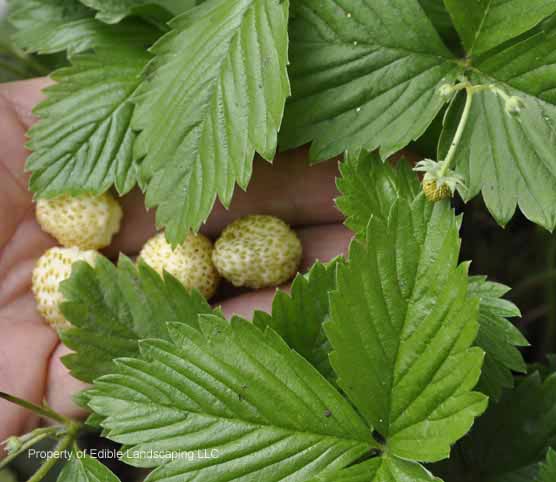 Yellow Wonder Alpine strawberries do not produce runners, therefore they are ideal for edgings or containers, or narrow rows in the vegetable garden. Conical fruits 1/2" to 1" long are not noticed by the birds because of the fruits color. Yellow Wonder fruit is highly aromatic with delicious flavor and the plant is long lived in perennial spots around the home. The plants ripen their fruits in the spring and fall since flower initiation of the crown of the plant happens when night time temperatures fall below 50 degrees F. Plants are everbearing the farther north they are grown. Native to Europe, we grow the vigorous plants from seed. Space 1' circles or 1' apart in rows Zones 3-7.
Yellow Wonder Alpine strawberries do not produce runners, therefore they are ideal for edgings or containers, or narrow rows in the vegetable garden. Conical fruits 1/2" to 1" long are not noticed by the birds because of the fruits color. Yellow Wonder fruit is highly aromatic with delicious flavor and the plant is long lived in perennial spots around the home. The plants ripen their fruits in the spring and fall since flower initiation of the crown of the plant happens when night time temperatures fall below 50 degrees F. Plants are everbearing the farther north they are grown. Native to Europe, we grow the vigorous plants from seed. Space 1' circles or 1' apart in rows Zones 3-7.View detailed information Please contact our office to see about availability. 434.361.9134
|
| Sweet Charlie Strawberry - Fragaria annassa |
 Sweet Charlie was the first patented variety to come out of University of Florida. Large conic fruit winning the taste test of the 1994 North Carolina Strawberry Grower's Meeting. Dark green compact growth with fruit that lives up to its name. Zones 7-9.
Sweet Charlie was the first patented variety to come out of University of Florida. Large conic fruit winning the taste test of the 1994 North Carolina Strawberry Grower's Meeting. Dark green compact growth with fruit that lives up to its name. Zones 7-9.
View detailed information
|
| Earliglow Strawberry - Fragaria annassa |
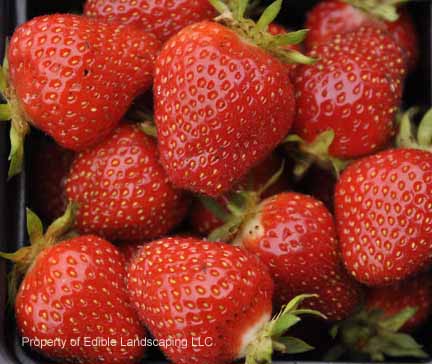 Introduced years ago, Earliglow still retains the high strawberry flavor of the heirloom varieties. Good sized berries and the earliest. Deep red color fruit and plants are disease resistant. Very dependable and healthy plants that make lots of runners. Zones 4-8.
Introduced years ago, Earliglow still retains the high strawberry flavor of the heirloom varieties. Good sized berries and the earliest. Deep red color fruit and plants are disease resistant. Very dependable and healthy plants that make lots of runners. Zones 4-8.
View detailed information
|
| Virginia Native Strawberry - Fragaria virginiana |
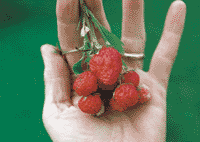 The native Fragaria virginiana or Virginia native strawberry is a spring bearing, soft, highly flavored ground cover. Fruits are delicate with sweet aroma. Plants spread by runner plants and are perennial. Space 1' circles Zones 5-8.
The native Fragaria virginiana or Virginia native strawberry is a spring bearing, soft, highly flavored ground cover. Fruits are delicate with sweet aroma. Plants spread by runner plants and are perennial. Space 1' circles Zones 5-8.
View detailed information
|
| Seascape Strawberry - Fragaria x ananassa |
 Seascape is a variety from the University of California. Large, firm berries with outstanding flavor. A day neutral* variety producing high yields, large fruit size, symmetry, attractive appearance, and general flexibility in planting requirements. Seascape yields ripe fruits from spring into fall. Usually one berry per plant will be a "king" berry. Very large and perfect for fondue. It is a cross between Selva and Douglas. Space 1' to 18" apart in rows 1' to 3' wide. Zone 5-9.
Seascape is a variety from the University of California. Large, firm berries with outstanding flavor. A day neutral* variety producing high yields, large fruit size, symmetry, attractive appearance, and general flexibility in planting requirements. Seascape yields ripe fruits from spring into fall. Usually one berry per plant will be a "king" berry. Very large and perfect for fondue. It is a cross between Selva and Douglas. Space 1' to 18" apart in rows 1' to 3' wide. Zone 5-9.* A day neutral strawberry will produce flowers and fruit even when temperatures at night are above 60 degrees. Originally, ever bearers produced spring and fall but not summer. Plant Patent 07614 View detailed information
|
| White Fruiting Christina Native Strawberry - Fragaria virginiana |
 Christina is a native spring bearing white strawberry. Plants run freely and should naturalize in dappled shade rock gardens and walled gardens especially near the kitchen. Fruits are soft and sweet. More bird resistant than red strawberries. For a patriotic spring harvest, plant a Goumi as a center piece with 2 Hascaps on each side with a ground cover of Christinas for a red, white, and blue harvest. Space 1' circles, Zone 5-7 maybe Zone 8.
Christina is a native spring bearing white strawberry. Plants run freely and should naturalize in dappled shade rock gardens and walled gardens especially near the kitchen. Fruits are soft and sweet. More bird resistant than red strawberries. For a patriotic spring harvest, plant a Goumi as a center piece with 2 Hascaps on each side with a ground cover of Christinas for a red, white, and blue harvest. Space 1' circles, Zone 5-7 maybe Zone 8.
View detailed information
|
| Alexandra Alpine Red Strawberry - Fragaria vesca |
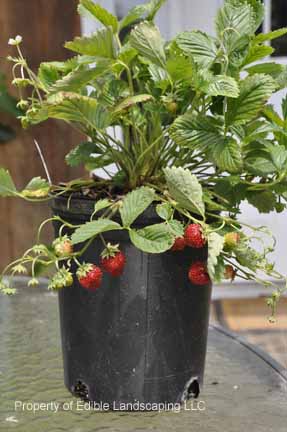 Alexandra is an alpine strawberry with deep red fruit. An everbearing plant that sets fruit buds when temperatures at night are below 50 degrees F. Alexandra produces no runners but grows in a clump like manner. Height @ 6" to 10" tall. Excellent as a ground cover or in rock gardens or borders. The species is native to the Scandinavian forests of Europe.Fruits are soft, flavorful, and gourmet. Zones 3-7. Space 1' circle. Pictured is a 3/4 gallon size.
Alexandra is an alpine strawberry with deep red fruit. An everbearing plant that sets fruit buds when temperatures at night are below 50 degrees F. Alexandra produces no runners but grows in a clump like manner. Height @ 6" to 10" tall. Excellent as a ground cover or in rock gardens or borders. The species is native to the Scandinavian forests of Europe.Fruits are soft, flavorful, and gourmet. Zones 3-7. Space 1' circle. Pictured is a 3/4 gallon size.
View detailed information
|
| Fairfax Strawberry - Fragaria annassa |
 Introduced by George Darrow in 1923, Fairfax soon became a very popular variety because of its flavor. One of the top fresh tasting strawberries ever. Zones 4-8 Space 18 inches apart in 3' wide beds.
Introduced by George Darrow in 1923, Fairfax soon became a very popular variety because of its flavor. One of the top fresh tasting strawberries ever. Zones 4-8 Space 18 inches apart in 3' wide beds.
View detailed information Please contact our office to see about availability. 434.361.9134
|
| Chandler Everbearing Strawberry - Fragaria annanas sps |
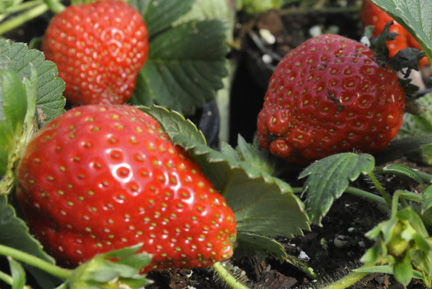 This is the standard cultivar for the U-pick producers because it is well liked by consumers for its good flavor, size and attractive red color. Chandler is cold hardy and does not generally require winter protection (straw or row covers) for most growing areas in zones 7 or 8. However, winter temperatures below 10 degrees Fahrenheit will cause extensive flower and crown injury in this variety. For this reason, row covers are strongly recommended for areas where there is a potential for periods of extreme cold in winter. Chandler has been a dependable producer at the nursery. Chandler has a large spring crop followed by a lesser summer crop. A border of native violets, Johnny jump ups or pansies go well with the bloom of strawberries. Zones 6-8
This is the standard cultivar for the U-pick producers because it is well liked by consumers for its good flavor, size and attractive red color. Chandler is cold hardy and does not generally require winter protection (straw or row covers) for most growing areas in zones 7 or 8. However, winter temperatures below 10 degrees Fahrenheit will cause extensive flower and crown injury in this variety. For this reason, row covers are strongly recommended for areas where there is a potential for periods of extreme cold in winter. Chandler has been a dependable producer at the nursery. Chandler has a large spring crop followed by a lesser summer crop. A border of native violets, Johnny jump ups or pansies go well with the bloom of strawberries. Zones 6-8
View detailed information
|
| Cherry Berry Wintergreen - Gaultheria procumbens |
|---|
 Cherry Berries offers the most exceptionally large red berries you will find on a wintergreen. Bears fruit fall through spring. Its evergreen, glossy green foliage turns merlot-colored in the cool of winter. Use as a ground cover or as a cascading plant over hardscape features. Prefers part shade and acidic, humidic, woods-like, well-drained soil. Low, spreading moderate grower reaches 8-10 inches tall and 3 feet wide in optimal conditions. Introduced by Briggs Nursery. Selected by Gurjit Sidhu, Sidhu & Sons Nursery. Zones 3-8.
Cherry Berries offers the most exceptionally large red berries you will find on a wintergreen. Bears fruit fall through spring. Its evergreen, glossy green foliage turns merlot-colored in the cool of winter. Use as a ground cover or as a cascading plant over hardscape features. Prefers part shade and acidic, humidic, woods-like, well-drained soil. Low, spreading moderate grower reaches 8-10 inches tall and 3 feet wide in optimal conditions. Introduced by Briggs Nursery. Selected by Gurjit Sidhu, Sidhu & Sons Nursery. Zones 3-8.
View detailed information Sorry, we are currently out of this item, please check back!
|
| Berry Cascade Wintergreen - Gaultheria Procumbens |
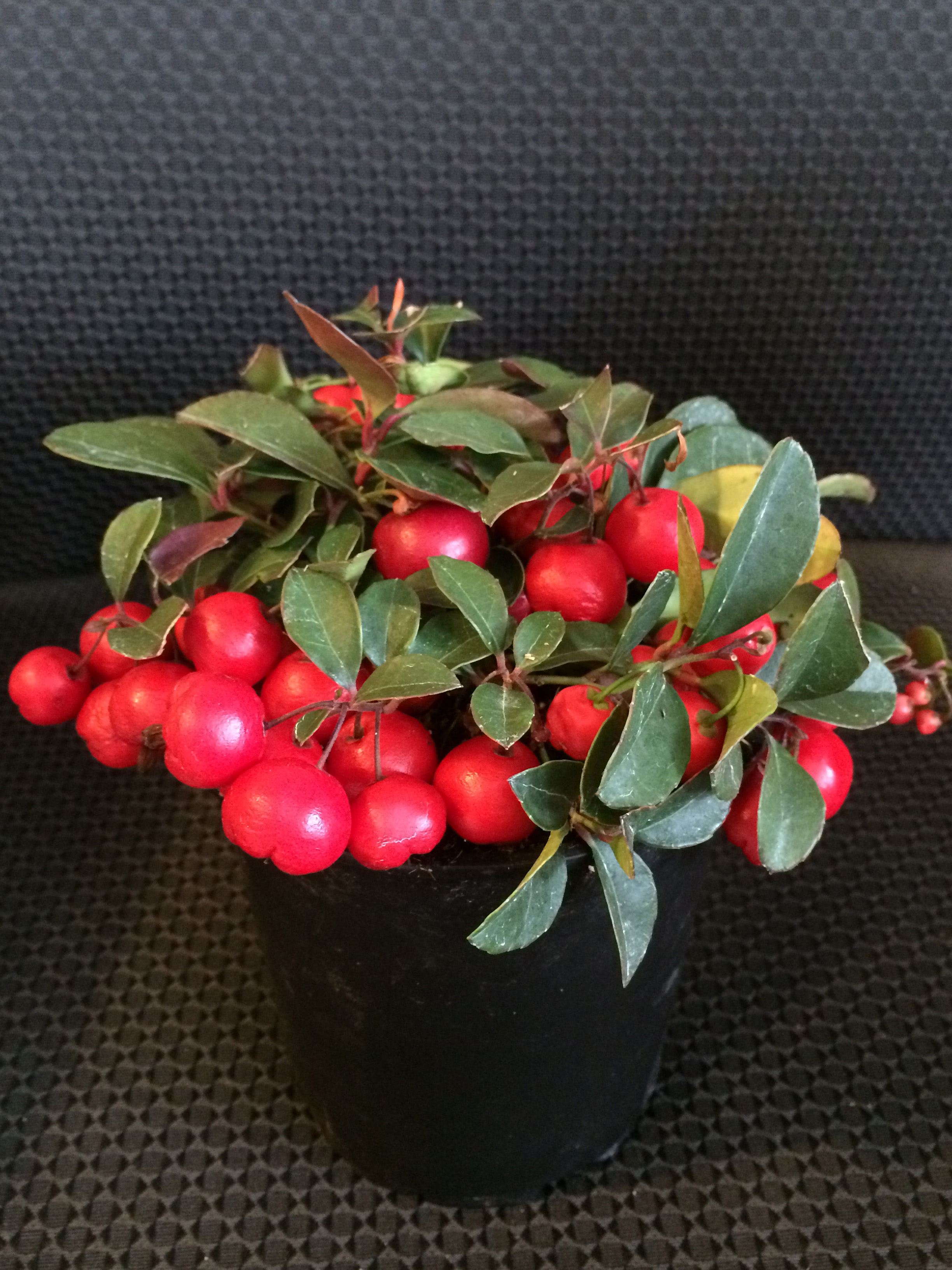 The plentiful berries of Berry Cascade grow the entire length of the stem, forming a charming, cascade effect. Delicate, bell-like white flowers in Summer, followed by loads of brilliant berries fall through spring. Orange-red new growth in Spring holds its color for months. Burgundy color blankets the foliage in the cool of Winter. Excellent in mixed containers(especially for the Holidays!), but great as a hardscape groundcover. Prefers partial shade and blueberry type mulchy soil mix of bark and peat, well drained. Pollinator & wildlife friendly.
The plentiful berries of Berry Cascade grow the entire length of the stem, forming a charming, cascade effect. Delicate, bell-like white flowers in Summer, followed by loads of brilliant berries fall through spring. Orange-red new growth in Spring holds its color for months. Burgundy color blankets the foliage in the cool of Winter. Excellent in mixed containers(especially for the Holidays!), but great as a hardscape groundcover. Prefers partial shade and blueberry type mulchy soil mix of bark and peat, well drained. Pollinator & wildlife friendly.
View detailed information Sorry, we are currently out of this item, please check back!
|
| For The Love of Pawpaws |
|---|
|
For the Love of Paw Paws by Michael Judd A Mini Manual for Growing and Caring for Paw Paws–From Seed to Table Pages: 140 pages Book Art: Full-color photographs throughout Size: 8 x 9.25 inch Publisher: Ecologia Pub. Date: August 29, 2019 ISBN: 9780578488745 View detailed information Please contact our office to see about availability. 434.361.9134
|
| Gift Certificate |
|---|
 Gift certificates are now available online! If you would like to have them mailed to the recipient please be sure to include that information with your order. Gift certificates are mailed 1st class. A catalog is sent with certificate. Please make a note in the comments field if you wish a different amount. Also for some reason the site has started showing $15 ship cost for the certificate. There is no ship cost to send a gift certificate. Gift certificates are good for 1 year.
Gift certificates are now available online! If you would like to have them mailed to the recipient please be sure to include that information with your order. Gift certificates are mailed 1st class. A catalog is sent with certificate. Please make a note in the comments field if you wish a different amount. Also for some reason the site has started showing $15 ship cost for the certificate. There is no ship cost to send a gift certificate. Gift certificates are good for 1 year.
View detailed information
|
| Surround WP Organic Spray |
|---|
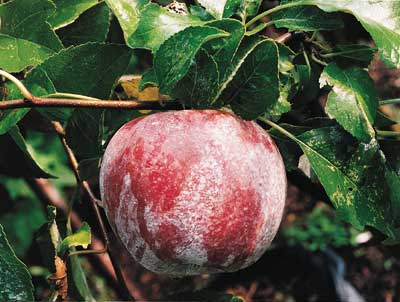 Peaches, plums, apples, cherries, apricots, pears and nectarines usually need at least two sprays of Surround after the flower petals fall off the tree and two weeks later. These timely sprays will keep worms and/or larvae such as plum curculio, oriental fruit moths, and codling moths from your fruit. Surround protects with a cover of clay that prevents insects from laying eggs on your fruit. This spray is a major celebration for gardeners who wish to grow organically delicious, tree ripened fruit in the Roseacious family. It works on Japanese Beetles, too. Talk about a safe spray! It's actually edible! OMRI listed crop protectant. (The Organic Materials Review Institute (OMRI) is a national nonprofit organization that determines which input products are allowed for use in organic production and processing. OMRI Listed or Approved products may be used on operations that are certified organic under the USDA National Organic Program. ) The Pest Management Regulatory Agency (PMRA) recently announced the approval of a minor use label expansion for Surround WP Crop Protectant (kaolin) for reduction in damage from leafhoppers on dry beans, potatoes, carrots, strawberries, raspberries and leafy vegetables (crop group 4, including celery, lettuce, parsley and spinach) in Canada.
Peaches, plums, apples, cherries, apricots, pears and nectarines usually need at least two sprays of Surround after the flower petals fall off the tree and two weeks later. These timely sprays will keep worms and/or larvae such as plum curculio, oriental fruit moths, and codling moths from your fruit. Surround protects with a cover of clay that prevents insects from laying eggs on your fruit. This spray is a major celebration for gardeners who wish to grow organically delicious, tree ripened fruit in the Roseacious family. It works on Japanese Beetles, too. Talk about a safe spray! It's actually edible! OMRI listed crop protectant. (The Organic Materials Review Institute (OMRI) is a national nonprofit organization that determines which input products are allowed for use in organic production and processing. OMRI Listed or Approved products may be used on operations that are certified organic under the USDA National Organic Program. ) The Pest Management Regulatory Agency (PMRA) recently announced the approval of a minor use label expansion for Surround WP Crop Protectant (kaolin) for reduction in damage from leafhoppers on dry beans, potatoes, carrots, strawberries, raspberries and leafy vegetables (crop group 4, including celery, lettuce, parsley and spinach) in Canada.
View detailed information Sorry, we are currently out of this item, please check back!
|
| Planning A Home Orchard Video |
 Planning a Home Orchard with Michael McConkey and Alexis Zeigler
Planning a Home Orchard with Michael McConkey and Alexis ZeiglerIn this 5 hour video tutorial, learn how to grow delicious fruits and nuts without chemicals in your own home orchard. Since 1979, Michael McConkey has researched and promoted chemical-free orcharding at Edible Landscaping, Alexis Zeigler teaches orcharding and propagation classes at Living Energy Farm. The video will be shipped first class mail on a flash drive. Actual ship cost on this is $1.00 it will show in the cart as the minimum of $15. We will adjust this. You will NOT be charged $15 to mail a flash drive. View detailed information
|
| Prickly Pear Hardy Cactus aka Nopal - Opuntia tuna |
|---|
 A large padded prickly pear native cactus with yellow, similar to rose, spring flowers. Fruits ripen Oct-Nov in Zone 7 and can be harvested well into the winter. Plant spreads to make a clump. Medium sized red fruit 3" long. Remove small thorns from skin of fruit before handling or eating. Handle with barbeque tongs when planting. De-thorned pads are also used as a vegetable. For cactus "string beans", cut pads in long strips and grill or saute. Fruit pulp is an excellent addition to fruit salads, lending its intense red color as well as flavor. A less care four season ornamental. Space 6' circle Zones 7-9 Zone 6 plant out of the winter prevailing wind
A large padded prickly pear native cactus with yellow, similar to rose, spring flowers. Fruits ripen Oct-Nov in Zone 7 and can be harvested well into the winter. Plant spreads to make a clump. Medium sized red fruit 3" long. Remove small thorns from skin of fruit before handling or eating. Handle with barbeque tongs when planting. De-thorned pads are also used as a vegetable. For cactus "string beans", cut pads in long strips and grill or saute. Fruit pulp is an excellent addition to fruit salads, lending its intense red color as well as flavor. A less care four season ornamental. Space 6' circle Zones 7-9 Zone 6 plant out of the winter prevailing wind
View detailed information
|
| Golden Lemon Thyme - T. citriodorus aureus varaiegatue |
|---|
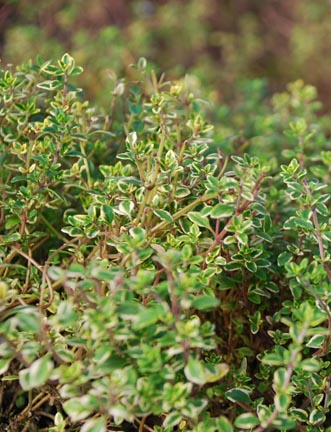 Golden Lemon Thyme is pungently lemon scented. Golden and variegated when in bright light. Great in a hanging basket and beautiful with rock walkways. Excellent garnish for sandwiches and salads. Goog bee plant. Space 1' circle Zones 4-10.
Golden Lemon Thyme is pungently lemon scented. Golden and variegated when in bright light. Great in a hanging basket and beautiful with rock walkways. Excellent garnish for sandwiches and salads. Goog bee plant. Space 1' circle Zones 4-10.
View detailed information Please contact our office to see about availability. 434.361.9134
|
| Garlic Chives - Allium tuberosum |
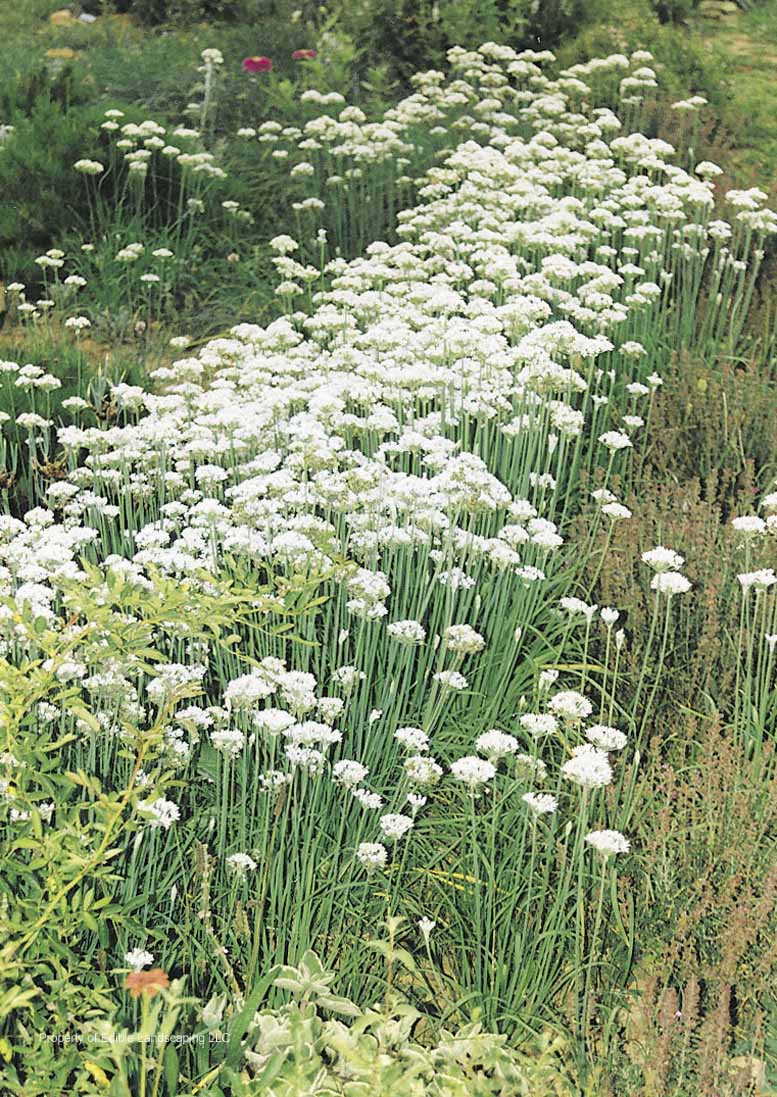 Garlic chives are an attractive perennial with edible foliage and edible flowers in August. Garlic chives are among the most versatile of all edible flowers, and can be used for flavoring in fresh salads or cooking. They have a clumping habit and spread by dropping their seeds. The seedlings appearing the following spring. They work well in perennial beds. All parts are edible and can be harvested throughout the growing season. Space individual plants 1' circles. Zones 4-8.
Garlic chives are an attractive perennial with edible foliage and edible flowers in August. Garlic chives are among the most versatile of all edible flowers, and can be used for flavoring in fresh salads or cooking. They have a clumping habit and spread by dropping their seeds. The seedlings appearing the following spring. They work well in perennial beds. All parts are edible and can be harvested throughout the growing season. Space individual plants 1' circles. Zones 4-8.
View detailed information Please contact our office to see about availability. 434.361.9134
|
| Chocolate Mint - Mentha spicata var piperita |
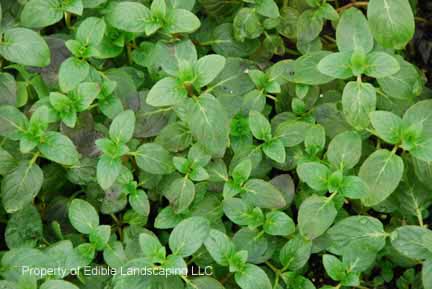 Dark green leaves. Height 12"-18". Scent is reminiscent of chocolate peppermint patties. Very good for fruit desserts and tea. Space 1' - 2' circle Zones 4-10.
Dark green leaves. Height 12"-18". Scent is reminiscent of chocolate peppermint patties. Very good for fruit desserts and tea. Space 1' - 2' circle Zones 4-10.
View detailed information
|
| Provence Lavender - Lavandula x intermedia |
 An adaptable lavender to the Northeast. Hardy, Zones 5-9. Zones 5-7 locate plants protected from the wind. Lavender's are pretty. They are border plants, accent plants, and look good with bushes and small trees. A one foot spacing will bring plants together for a low hedge appearance.Good bee plant.
An adaptable lavender to the Northeast. Hardy, Zones 5-9. Zones 5-7 locate plants protected from the wind. Lavender's are pretty. They are border plants, accent plants, and look good with bushes and small trees. A one foot spacing will bring plants together for a low hedge appearance.Good bee plant.
View detailed information Sorry, we are currently out of this item, please check back!
|
| Arp Rosemary - Rosemary officialnalis |
 Arp rosemary is winter hardy through Zone 6. The USDA introduction is a hardier rosemary than others and handsome with a bushy spruce-like appearance. Space 3'-4' circle. In zone 6 Arp should be planted sheltered from winter winds. A sand mulch or planted near or next to large rocks in full sun helps rosemary through the coldest times in winter. Harvest rosemary year round. Especially good in French breads and potatoes dishes. Zones 6-8.
Arp rosemary is winter hardy through Zone 6. The USDA introduction is a hardier rosemary than others and handsome with a bushy spruce-like appearance. Space 3'-4' circle. In zone 6 Arp should be planted sheltered from winter winds. A sand mulch or planted near or next to large rocks in full sun helps rosemary through the coldest times in winter. Harvest rosemary year round. Especially good in French breads and potatoes dishes. Zones 6-8.
View detailed information Please contact our office to see about availability. 434.361.9134
|
| Franeaux Hardy Rosemary - Rosemary officialnalis |
 Darker green and more compact than Arp. This variety is very ornamental, up to 4', making a fine specimen in the garden or grown as a standard. Space 4' circle. It has survived 0 degrees with some winter injury in a protected area of the nursery after 5 years of no injury. Zone 7-8
Darker green and more compact than Arp. This variety is very ornamental, up to 4', making a fine specimen in the garden or grown as a standard. Space 4' circle. It has survived 0 degrees with some winter injury in a protected area of the nursery after 5 years of no injury. Zone 7-8
View detailed information
|
| Sweet Bay Laurel - Laural nobilis |
 The traditional bay leaf so essential to European cuisine. Slow growing bush with aromatic leaves; a good shrub for warm areas. Good for pots. Space outside 8' circle. Zones 7b - 8.
The traditional bay leaf so essential to European cuisine. Slow growing bush with aromatic leaves; a good shrub for warm areas. Good for pots. Space outside 8' circle. Zones 7b - 8.
View detailed information
|
| Lemongrass - Cymbopogon citratus |
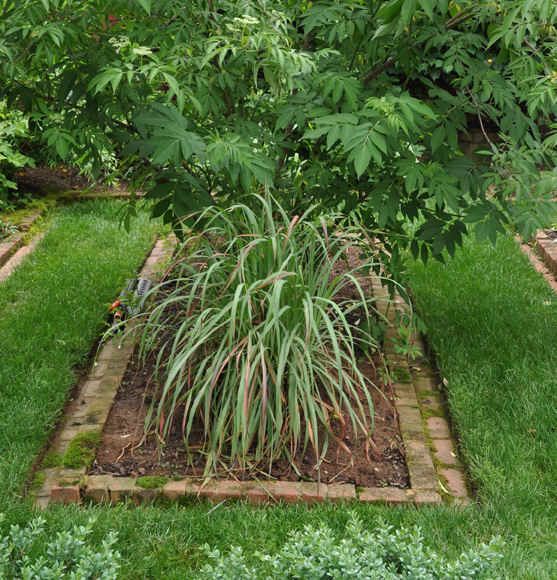 Lemongrass is our instant tea plant at the nursery; just a few blades in a cup of hot water. Try sweetening with honey. A tropical ornamental grass. Will grow well anywhere indoors. Used in many Thai recipes and is the source for citral, the essential oil responsible for citronella's lemony scent. Thai women crinkle up a handful and put in in their bath water to prevent wrinkles! An ornamental clumping grass space a 4' circle. Zones 9-10 and can be grown as a outside annual in the north. We offer the West Indian strain with the wider leaf. We've noticed we can dig an outside clump in December after a few frosts, with no cold damage.
Lemongrass is our instant tea plant at the nursery; just a few blades in a cup of hot water. Try sweetening with honey. A tropical ornamental grass. Will grow well anywhere indoors. Used in many Thai recipes and is the source for citral, the essential oil responsible for citronella's lemony scent. Thai women crinkle up a handful and put in in their bath water to prevent wrinkles! An ornamental clumping grass space a 4' circle. Zones 9-10 and can be grown as a outside annual in the north. We offer the West Indian strain with the wider leaf. We've noticed we can dig an outside clump in December after a few frosts, with no cold damage.
View detailed information
|
| Horseradish - Armoracia rusticana |
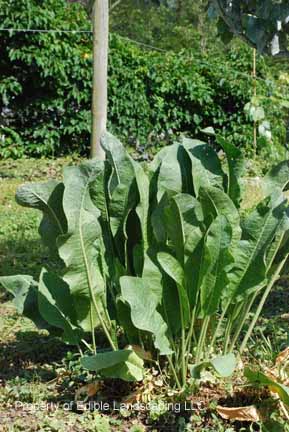 Horseradish is a perennial growing to 30 inches tall and putting down long, thick, white roots which are grated to make a fiery sauce. Roots mature in 150 days. Roots are harvested throughout the winter in zone 7. Space 2' circles Zones 3-7.
Horseradish is a perennial growing to 30 inches tall and putting down long, thick, white roots which are grated to make a fiery sauce. Roots mature in 150 days. Roots are harvested throughout the winter in zone 7. Space 2' circles Zones 3-7.
View detailed information
|
| Italian Flat Leaf Parsley - Petroselinum crispum |
 Biennial herb to 1', commonly grown as an annual. Grows in Zones 1 - 10. Hardy over winters well. Space 1' circle
Biennial herb to 1', commonly grown as an annual. Grows in Zones 1 - 10. Hardy over winters well. Space 1' circle
View detailed information
|
| Spearmint - Mentha spicata |
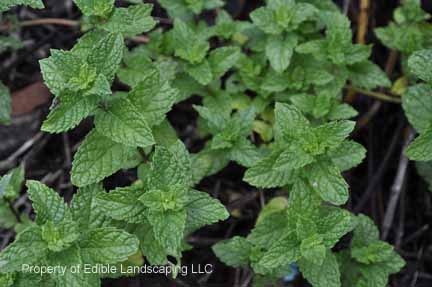 A very usable perennial in the garden or in plantings near the kitchen. Fresh leaves blended, strained, sweeten, and iced. Is there a better drink on a hot summer day? As all mints the plant must be kept in bounds. The bloom attracts many butterfly. Spearmint provides relief from hormonal acne. Space 5' circle or smaller. Zone 4-10
A very usable perennial in the garden or in plantings near the kitchen. Fresh leaves blended, strained, sweeten, and iced. Is there a better drink on a hot summer day? As all mints the plant must be kept in bounds. The bloom attracts many butterfly. Spearmint provides relief from hormonal acne. Space 5' circle or smaller. Zone 4-10
View detailed information
|
| Franklinia Tea Tree - Franklinia alatamaha |
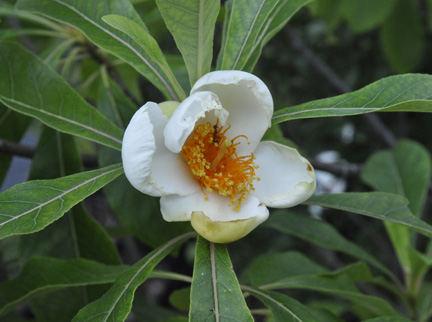 Franklinia has great fall color. The glossy leaves turn vivid orange to red in the fall. Flowers are summer blooming till frost and are white, resembling tea camellia. Blooms are present while tree is turning its attractive fall color. Use in the landscape as a specimen native tree. Zones 6 - 9, doing best in 6 - 7. Moist, well drained soil and full sun to partial shade are its location requirements.
Franklinia has great fall color. The glossy leaves turn vivid orange to red in the fall. Flowers are summer blooming till frost and are white, resembling tea camellia. Blooms are present while tree is turning its attractive fall color. Use in the landscape as a specimen native tree. Zones 6 - 9, doing best in 6 - 7. Moist, well drained soil and full sun to partial shade are its location requirements. Use the leaves fresh or dried. An ideal tea for children since it contains no caffeine. It is also a healthy alternative to decaffeinated tea. Space 10' circles. View detailed information Sorry, we are currently out of this item, please check back!
|
| Red Veined Sorrel - Rumex sanguineus |
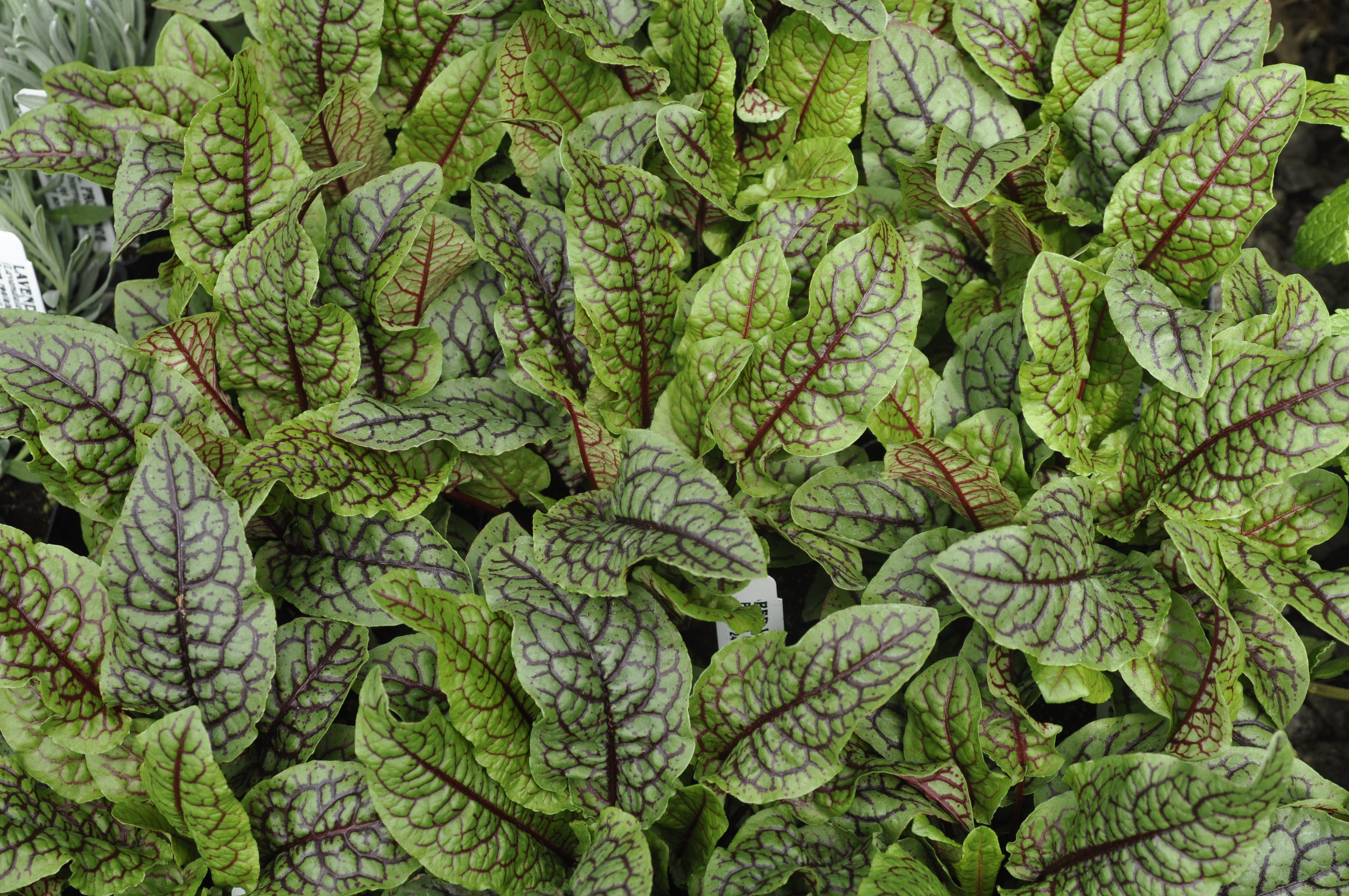 Red Veined Sorrel is a pretty salad mix plant, full of nutrition. Hardy and easy to grow. Good plant to overwinter in a cold frame with other greens and excellent in a flower bed or as an accent in a vegetable garden. Young leaves are best. Space 1' circle. Zones 5-8
Red Veined Sorrel is a pretty salad mix plant, full of nutrition. Hardy and easy to grow. Good plant to overwinter in a cold frame with other greens and excellent in a flower bed or as an accent in a vegetable garden. Young leaves are best. Space 1' circle. Zones 5-8
View detailed information
|
| Ginger - Zingiber officinale |
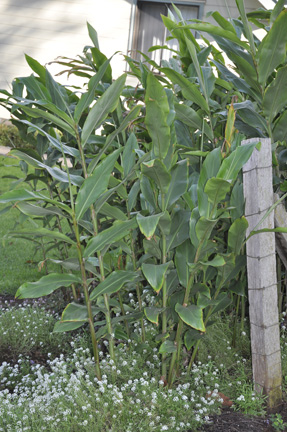 Perennial spreading habit with spicy tubers, harvested annually. Space 2' circles, eventually spreading outwards. Zone 8-10 In Zone 7 and colder zones can be grown as an annual or grown in pots. Ginger grows where the lowest temperatures of the year are between 40 and 0 degrees Fahrenheit.
Perennial spreading habit with spicy tubers, harvested annually. Space 2' circles, eventually spreading outwards. Zone 8-10 In Zone 7 and colder zones can be grown as an annual or grown in pots. Ginger grows where the lowest temperatures of the year are between 40 and 0 degrees Fahrenheit.
View detailed information
|
| Greek Oregano - Origanum vulgare hirtum |
 This hardy strain of Oregano was brought to us by Doug Siedel of Emmaus, Pa. The delicate flavored herb is a perennial and can over winter in Zone 6. Use the plant most of the year as a fresh kitchen herb. Top twenty flower for honey bees. Space 1-2 foot circle. Zone 6-9
This hardy strain of Oregano was brought to us by Doug Siedel of Emmaus, Pa. The delicate flavored herb is a perennial and can over winter in Zone 6. Use the plant most of the year as a fresh kitchen herb. Top twenty flower for honey bees. Space 1-2 foot circle. Zone 6-9
View detailed information
|
| Native Mountain Mint - Pycnanthemum muticum |
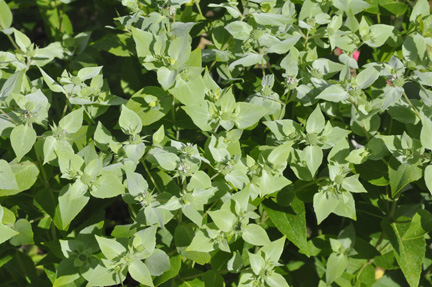 Mountain Mint is an aromatic perennial native to the Eastern United States from IL to FL and west to TX. Good for tea and medicinal uses. This 1-3' clumper blooms for a long period in summer when the bees need it the most. Also good for butterfly gardens. They are pretty when grouped or massed. A decorative addition to yard or garden with its red undertoned leaves. Also called Short Toothed Mountain Mint. Zone 4 - 8.
Mountain Mint is an aromatic perennial native to the Eastern United States from IL to FL and west to TX. Good for tea and medicinal uses. This 1-3' clumper blooms for a long period in summer when the bees need it the most. Also good for butterfly gardens. They are pretty when grouped or massed. A decorative addition to yard or garden with its red undertoned leaves. Also called Short Toothed Mountain Mint. Zone 4 - 8.
View detailed information Sorry, we are currently out of this item, please check back!
|
| Cascade Hops - Humilus lupinus |
|---|
 Hops were used by the Greeks as a salad plant. Today young hops shoots are still eaten by some. The pine cone like scales or bracts of the hops contain lupulin, a substance consisting of resins and essential oil, which gives beer, ale and other malt beverages their characteristic bitter flavor. One-half to one and a quarter pounds of hops are used for a 31-gallon barrel of beer. Hops are long-lived perennials grown like pole beans on 10' tall poles, spaced 4-8' apart. At harvest, the vines are let down, the green hops are picked and dried. Can be grown on a fence or wall. Hops above ground growth dies back in winter. In spring this perennial grows from the ground and quickly establishes itself by late spring. Cascade is a successful and well established aroma hop developed by Oregon State University in 1956 from Fuggle and Serebrianker (a Russian variety). Gives a citrus/grapefruit aroma to a pale ale.Zones 3-8.
Hops were used by the Greeks as a salad plant. Today young hops shoots are still eaten by some. The pine cone like scales or bracts of the hops contain lupulin, a substance consisting of resins and essential oil, which gives beer, ale and other malt beverages their characteristic bitter flavor. One-half to one and a quarter pounds of hops are used for a 31-gallon barrel of beer. Hops are long-lived perennials grown like pole beans on 10' tall poles, spaced 4-8' apart. At harvest, the vines are let down, the green hops are picked and dried. Can be grown on a fence or wall. Hops above ground growth dies back in winter. In spring this perennial grows from the ground and quickly establishes itself by late spring. Cascade is a successful and well established aroma hop developed by Oregon State University in 1956 from Fuggle and Serebrianker (a Russian variety). Gives a citrus/grapefruit aroma to a pale ale.Zones 3-8.
View detailed information
|
| Centennial Hops - Humilus lupinus |
|
Centennial Hops is similar to Cascade and is actually referred to as Super Cascade. It was bred at the USDA hop breeding facility in Processer, Washington. Centennial is used in the brewing of bitter Ales and Pale Ales.
View detailed information
|
| Tea Camellia - Camellia sinensis |
|---|
 The profuse flowering, dense, round evergreen Camellia sinensis, whose leaves are used for green and black and white tea is an excellent ornamental.Leaves are glossy dark green and fall flowers are white with yellow centers. The bush is compact and round 6'tall and 5' wide. Tea is tender to strong winter winds and can defoliate from being too cold. Tea is as hardy or hardier than most camellia. In zone 7 plants do well protected on the east side of a building. Generally, tea enjoys dappled shade. The bush is not susceptible to insect damage or disease. Leaves are harvested throughout the growing season, picked when they are small. Space 6' circle Zones 6b-8
The profuse flowering, dense, round evergreen Camellia sinensis, whose leaves are used for green and black and white tea is an excellent ornamental.Leaves are glossy dark green and fall flowers are white with yellow centers. The bush is compact and round 6'tall and 5' wide. Tea is tender to strong winter winds and can defoliate from being too cold. Tea is as hardy or hardier than most camellia. In zone 7 plants do well protected on the east side of a building. Generally, tea enjoys dappled shade. The bush is not susceptible to insect damage or disease. Leaves are harvested throughout the growing season, picked when they are small. Space 6' circle Zones 6b-8
View detailed information
|
| Russian Comfrey - Symphytum x uplandicum |
 Russian comfrey is a hybrid of S. officinalis x S. asperum. Sterile. White, purple or blue flowers with the same uses as common comfrey. Space 4' circles. Non-spreading habit. Zones 3-9
Russian comfrey is a hybrid of S. officinalis x S. asperum. Sterile. White, purple or blue flowers with the same uses as common comfrey. Space 4' circles. Non-spreading habit. Zones 3-9
View detailed information
|
| Scarlet Beebalm - Monarda didyma L |
 Scarlet beebalm is aromatic herb a member of the mint family. It is also known by the common names bergamot, Oswego tea, and crimson beebalm. The common name beebalm refers to the use of a resin derived from the plant that may be used for healing and soothing in particularly of bee stings. The common name Oswego tea refers to the Oswego native Americans living near the present day city of Oswego in upstate New York who taught early settlers how to make a herbal tea from the plants leaves. The common name bergamont is derived from its fragrance that is similar to the fragrance of the bergamont orange. The genus name Monarda is in recognition of Nicolas Monardes, a Spanish physician, who authored an early herbal that introduced Europe to many of the plants from North America.
Scarlet beebalm is aromatic herb a member of the mint family. It is also known by the common names bergamot, Oswego tea, and crimson beebalm. The common name beebalm refers to the use of a resin derived from the plant that may be used for healing and soothing in particularly of bee stings. The common name Oswego tea refers to the Oswego native Americans living near the present day city of Oswego in upstate New York who taught early settlers how to make a herbal tea from the plants leaves. The common name bergamont is derived from its fragrance that is similar to the fragrance of the bergamont orange. The genus name Monarda is in recognition of Nicolas Monardes, a Spanish physician, who authored an early herbal that introduced Europe to many of the plants from North America.
View detailed information Sorry, we are currently out of this item, please check back!
|
| Shiitake Mushroom Spawn - Lentinula edodes |
|---|
 Shiitake Plug Spawn: translates to nice smelling mushroom. Cultivated for centuries, it is known for excellent flavor and medicinal qualities. This wide-range strain Cismont, produces abundant crops on oak and other hardwood logs in central Virginia. One pack seeds @ 3-4 logs, @ 100 plugs. The spawn run is usually 10-12 months. Zone 3-8
Shiitake Plug Spawn: translates to nice smelling mushroom. Cultivated for centuries, it is known for excellent flavor and medicinal qualities. This wide-range strain Cismont, produces abundant crops on oak and other hardwood logs in central Virginia. One pack seeds @ 3-4 logs, @ 100 plugs. The spawn run is usually 10-12 months. Zone 3-8
View detailed information
|
| Lions Mane Mushroom Spawn - Hericium erinaceus |
 Lions Mane Plug Spawn: This native to our forests fruits in the summer on hardwood logs. Oaks, maples and even Ailanthus logs will support growth of this excellent gourmet mushroom. Many say it has the texture and flavor of crab, lobster, or scallops. The spawn run is approximately 12-15 months. One pack does 3-4 logs @ 100 plugs. Zone 5b - 10b
Lions Mane Plug Spawn: This native to our forests fruits in the summer on hardwood logs. Oaks, maples and even Ailanthus logs will support growth of this excellent gourmet mushroom. Many say it has the texture and flavor of crab, lobster, or scallops. The spawn run is approximately 12-15 months. One pack does 3-4 logs @ 100 plugs. Zone 5b - 10b
View detailed information
|
| Reishi Mushroom Spawn - Ganoderma lucidum |
 Reishi (Ganoderma lucidum) Plug Spawn: Highly regarded in Traditional Chinese Medicine as the miraculous zhi, this woody medicinal mushroom is used as a health tonic and dietary supplement. Make teas and tinctures with this strain of the red reishi. Grows well on oaks and maple. One pack contains enough spawn to do 3-4 logs, @ 100 plugs. Spawn run is about 15 months. Zone 5-8
Reishi (Ganoderma lucidum) Plug Spawn: Highly regarded in Traditional Chinese Medicine as the miraculous zhi, this woody medicinal mushroom is used as a health tonic and dietary supplement. Make teas and tinctures with this strain of the red reishi. Grows well on oaks and maple. One pack contains enough spawn to do 3-4 logs, @ 100 plugs. Spawn run is about 15 months. Zone 5-8
View detailed information
|
| Oyster Mushroom Spawn - Pieurotus ostreatus |
 Oyster Mushroom (Pleurotus ostreatus) Plug Spawn: Pleurotus is cultivated worldwide and is known as easy to grow and delicious to eat. An excellent choice for adding seasonal gourmet mushrooms to your edible landscape. This locally collected wild oyster strain produces large mushrooms on tulip poplar, Ailanthus, and other hardwood logs. One pack seeds @ 3-4 logs, @ 100 plugs. Usually fruits in 4-6 months. Zone 3-8
Oyster Mushroom (Pleurotus ostreatus) Plug Spawn: Pleurotus is cultivated worldwide and is known as easy to grow and delicious to eat. An excellent choice for adding seasonal gourmet mushrooms to your edible landscape. This locally collected wild oyster strain produces large mushrooms on tulip poplar, Ailanthus, and other hardwood logs. One pack seeds @ 3-4 logs, @ 100 plugs. Usually fruits in 4-6 months. Zone 3-8
View detailed information
|
Due to import restrictions we are unable to ship Almonds to CA,Europe,Canada...
| Halls Hardy Almond - Prunus amygdalus Communis x a persia |
|---|
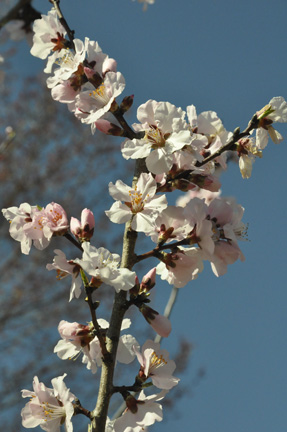 A fine ornamental with large showy pink blossoms. Hall's is a cross of almond and peach. The nuts are not paper shell and are similar to a peach seed.The hard green flesh around the nut splits and the seed drops like almonds do. Hall's is very adaptable especially to East coast conditions. Generally almonds grow well in California and some parts of Texas, but are not usually adapted to the eastern states. The nuts are very tasty with a hint of bitter almond flavor. The trees look like a peach tree and can be pruned to an open vase pruning to keep the tree easy to pick. Space 12' circle; height 8' with annual pruning. Zone 5-8
A fine ornamental with large showy pink blossoms. Hall's is a cross of almond and peach. The nuts are not paper shell and are similar to a peach seed.The hard green flesh around the nut splits and the seed drops like almonds do. Hall's is very adaptable especially to East coast conditions. Generally almonds grow well in California and some parts of Texas, but are not usually adapted to the eastern states. The nuts are very tasty with a hint of bitter almond flavor. The trees look like a peach tree and can be pruned to an open vase pruning to keep the tree easy to pick. Space 12' circle; height 8' with annual pruning. Zone 5-8
View detailed information
|
Due to import restrictions we are unable to ship Chestnut to CA, Europe...
| Chinese Chestnut - Castanea mollissima |
|---|
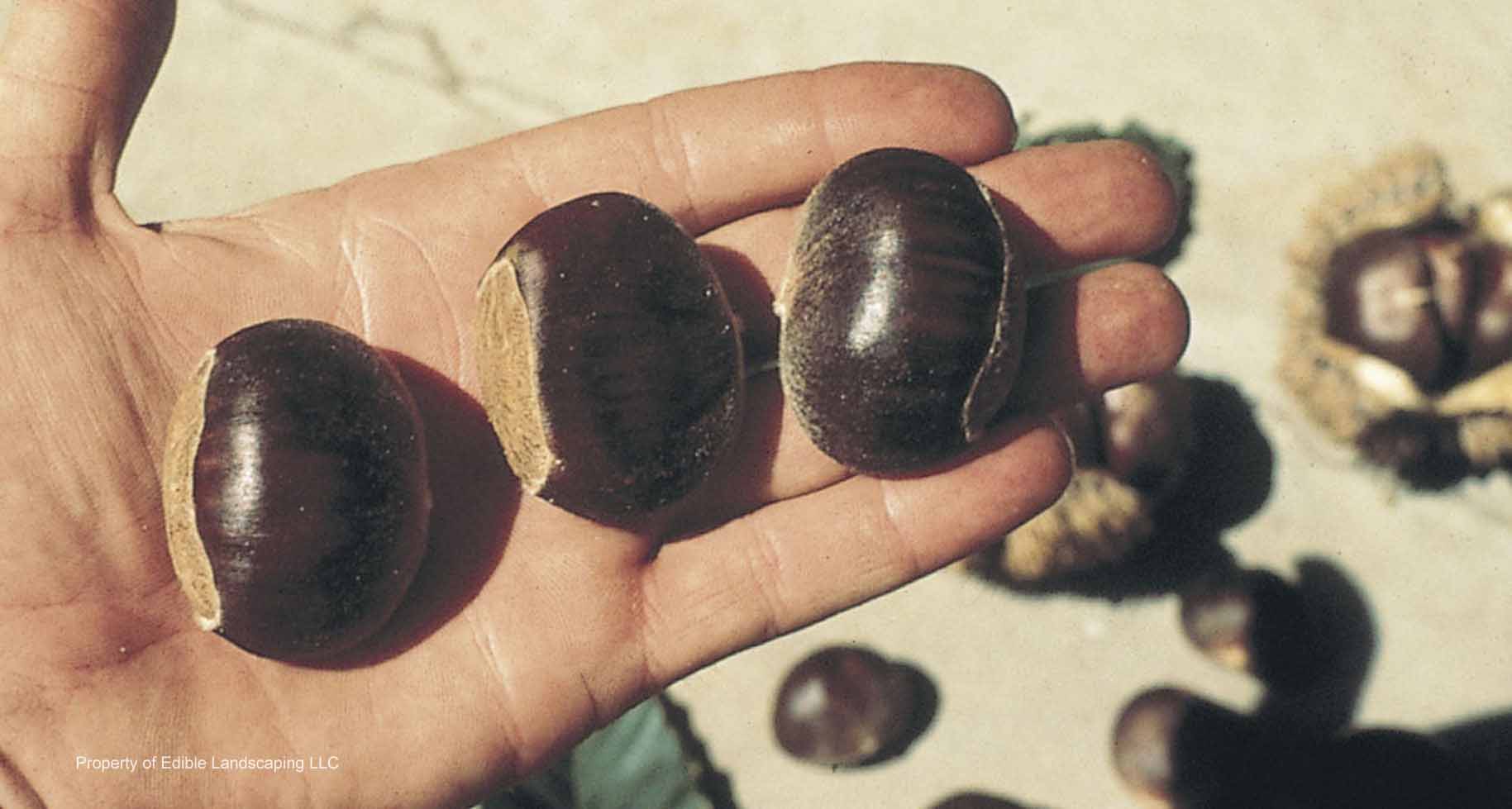 Chinese Chestnuts are good nuts to grow in the U.S. because of their resistance to blight. The tree grows tall and spreading. Two plants should be planted to ensure production of nuts. Space 30'-50' circle Zones 5 - 8.
Chinese Chestnuts are good nuts to grow in the U.S. because of their resistance to blight. The tree grows tall and spreading. Two plants should be planted to ensure production of nuts. Space 30'-50' circle Zones 5 - 8.
View detailed information Sorry, we are currently out of this item, please check back!
|
| Layeroka Chestnut - C. mollissima X C. sativa |
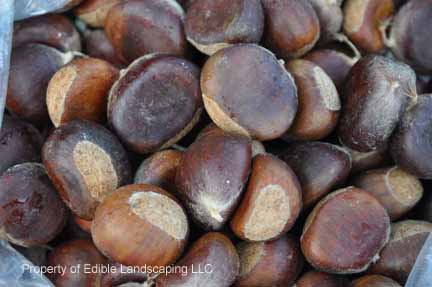 Layeroka is a blight resistant Chinese and European chestnut hybrid. The tree produces an abundance of large sweet chestnuts. Can become a large, tall tree, over 50 feet. Two of these seedlings are needed for pollination. Zone 4-8
Layeroka is a blight resistant Chinese and European chestnut hybrid. The tree produces an abundance of large sweet chestnuts. Can become a large, tall tree, over 50 feet. Two of these seedlings are needed for pollination. Zone 4-8
View detailed information Please contact our office to see about availability. 434.361.9134
|
| Yellowhorn Nut Tree - Xanthocerus sorbifolia |
|---|
 Yellowhorn is a very hardy deciduous tree that produces a fall nut, the leaves and beautiful spring flowers are also edible. The white flowers bloom in the spring before the tree leafs out, then in the fall an abundance of nuts can be harvested. Yellowhorn is self-fertile. Yellowhorn is native to China and Korea. Zone 4-8
Yellowhorn is a very hardy deciduous tree that produces a fall nut, the leaves and beautiful spring flowers are also edible. The white flowers bloom in the spring before the tree leafs out, then in the fall an abundance of nuts can be harvested. Yellowhorn is self-fertile. Yellowhorn is native to China and Korea. Zone 4-8
View detailed information
|
Due to import restrictions we are unable to ship Filberts aka Hazelnut to CA,...
| Native American Filbert - Corylus americana |
|---|
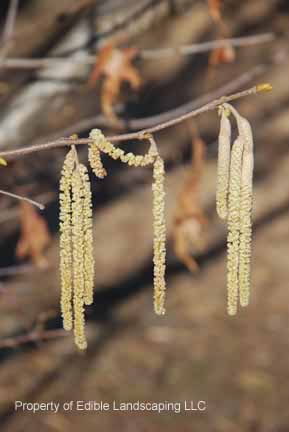 American filberts are pretty hedge bushes 6-8 feet tall. Native to the eastern U.S. Two plants are needed to set fruit. Very showy catkins in spring. Sweet small nuts ripen in August. Space 6' circle. Zones 5-8.
American filberts are pretty hedge bushes 6-8 feet tall. Native to the eastern U.S. Two plants are needed to set fruit. Very showy catkins in spring. Sweet small nuts ripen in August. Space 6' circle. Zones 5-8.
View detailed information Please contact our office to see about availability. 434.361.9134
|
| Jefferson Filbert - Corylus avellana |
 Jefferson is the new filbert that is replacing Barcelona as the leading variety. Barcelona was the most popular filbert grown in the US, but is not resistant to Eastern Filbert Blight(EFB), Jefferson is resistant to EFB, and provides high yields of attractive nuts on an easily managed upright shrub. Pollinated by the late pollen shedding Eta 20%, Felix 20% and Theta 60%, which are also resistant to EFB, gives all three varieties excellent nut set. flowers to late for other pollination. Introduced by Oregon State University. Plants are on their own roots. Space 8-10' circle. 15' height. Zone 5-8
Jefferson is the new filbert that is replacing Barcelona as the leading variety. Barcelona was the most popular filbert grown in the US, but is not resistant to Eastern Filbert Blight(EFB), Jefferson is resistant to EFB, and provides high yields of attractive nuts on an easily managed upright shrub. Pollinated by the late pollen shedding Eta 20%, Felix 20% and Theta 60%, which are also resistant to EFB, gives all three varieties excellent nut set. flowers to late for other pollination. Introduced by Oregon State University. Plants are on their own roots. Space 8-10' circle. 15' height. Zone 5-8
View detailed information Please contact our office to see about availability. 434.361.9134
|
| Eta Filbert - Corylus hyb |
 Over the last century, many advances were made for filbert nut improvement for quality nuts for the eastern US. Eta is a 2009 introduction that is immune to Eastern Filbert Blight and is a late pollen shedding cultivar that pollinates Theta and Jefferson. Plants are on their own roots. Zone 5-8
Over the last century, many advances were made for filbert nut improvement for quality nuts for the eastern US. Eta is a 2009 introduction that is immune to Eastern Filbert Blight and is a late pollen shedding cultivar that pollinates Theta and Jefferson. Plants are on their own roots. Zone 5-8
View detailed information Please contact our office to see about availability. 434.361.9134
|
| Theta Filbert Nut - Corylus avellana |
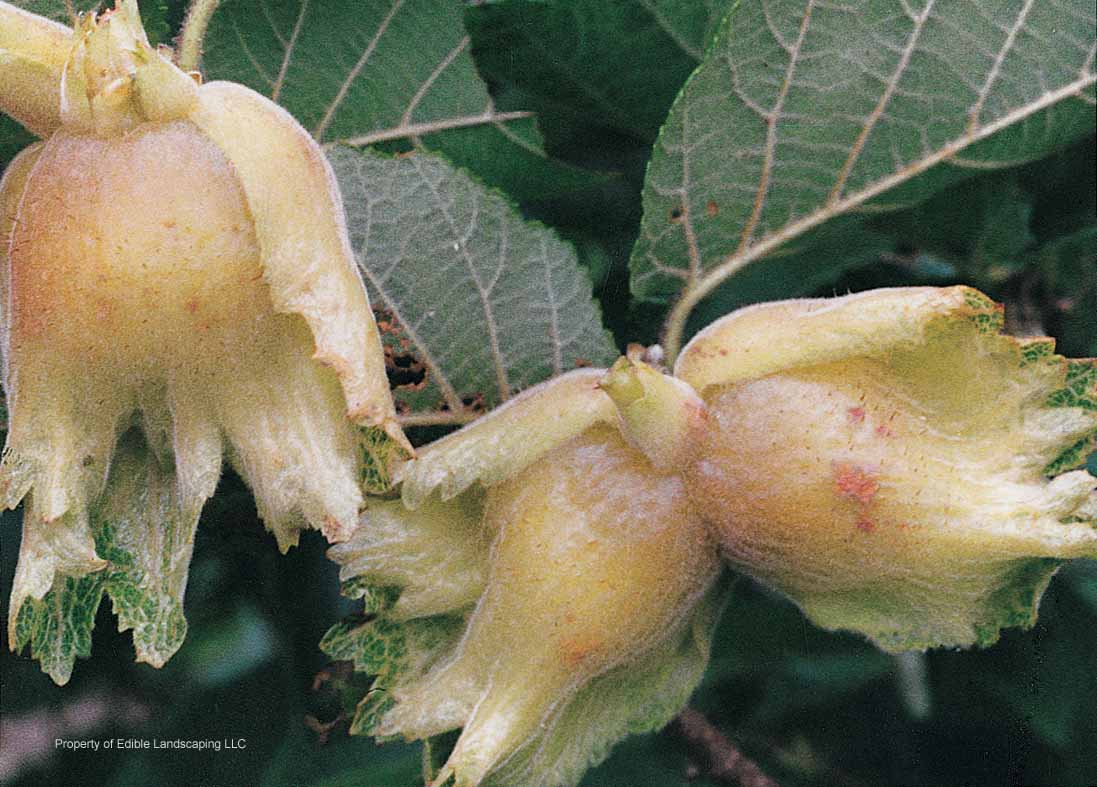 The hazelnut breeding program at Oregon State University directed by Shawn Mehlenbacher uses the genetic diversity in the genus Corylus to create new cultivars with resistance to eastern filbert blight. Theta is a 2009 release that is immune to the blight. Theta pollinates Jefferson and Eta with sizable nuts of its own. Plants are on their own roots. Zone 5-8
The hazelnut breeding program at Oregon State University directed by Shawn Mehlenbacher uses the genetic diversity in the genus Corylus to create new cultivars with resistance to eastern filbert blight. Theta is a 2009 release that is immune to the blight. Theta pollinates Jefferson and Eta with sizable nuts of its own. Plants are on their own roots. Zone 5-8
View detailed information Please contact our office to see about availability. 434.361.9134
|
| Yamhill Filbert - Corylus avellana |
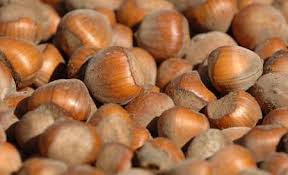 A compact, somewhat spreading tree. For instance, in its 10th leaf, height is about 9.2' and canopy about 11'. Tree is productive, nuts medium size, Kernal texture, flavor and appearance are very good. Yamhill is completely resistant to Eastern Filbert Blight for a long lived tree. Pollinators include York, Dorris, Wepster and Jefferson, Gamma and Epsilon. Pedigree includes Sicilian, Spanish and Turkish grandparents. Space 10' circle. Zone 5-8.
A compact, somewhat spreading tree. For instance, in its 10th leaf, height is about 9.2' and canopy about 11'. Tree is productive, nuts medium size, Kernal texture, flavor and appearance are very good. Yamhill is completely resistant to Eastern Filbert Blight for a long lived tree. Pollinators include York, Dorris, Wepster and Jefferson, Gamma and Epsilon. Pedigree includes Sicilian, Spanish and Turkish grandparents. Space 10' circle. Zone 5-8.
View detailed information Please contact our office to see about availability. 434.361.9134
|
| York Filbert - Corylus avellana |
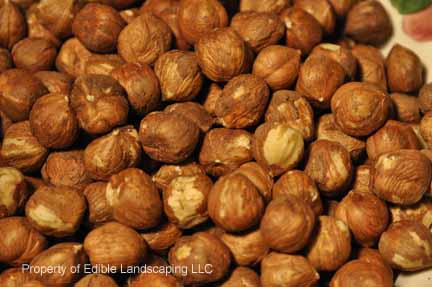 York is widely compatible with other newer varieties of eastern filbert blight resistant filberts. An excellent pollinator for McDonald, Wepster, Yamhill, Dorris and Sacajawea and early receptivity of Jefferson. It should be useful for decades to come. To get good coverage throughout the bloom of Jefferson use York for early receptivity. Space 10' circles Zones 4-8
York is widely compatible with other newer varieties of eastern filbert blight resistant filberts. An excellent pollinator for McDonald, Wepster, Yamhill, Dorris and Sacajawea and early receptivity of Jefferson. It should be useful for decades to come. To get good coverage throughout the bloom of Jefferson use York for early receptivity. Space 10' circles Zones 4-8
View detailed information Please contact our office to see about availability. 434.361.9134
|
| Winkler American Filbert - Corylus americana |
 Winkler Native American Filbert is a hard to find self fertile bush. It produces larger nuts and is more productive than most native seedlings. Originally from Iowa, introduced in 1918. The bush 6' tall and wide is not susceptible to blight. Ease of care and dependable bearing makes this plant a highly sought after variety. Its small size and good looks make it popular with home owners. Space 8' circle. Zone 4-7
Winkler Native American Filbert is a hard to find self fertile bush. It produces larger nuts and is more productive than most native seedlings. Originally from Iowa, introduced in 1918. The bush 6' tall and wide is not susceptible to blight. Ease of care and dependable bearing makes this plant a highly sought after variety. Its small size and good looks make it popular with home owners. Space 8' circle. Zone 4-7
View detailed information Please contact our office to see about availability. 434.361.9134
|
| McDonald Filbert - Corylus avellana |
 McDonald is a new filbert variety. It has high resistance to Eastern Filbert Blight. An important consideration for areas of the US where filberts grow.The tree's mature size is grower friendly, easy to manage and harvest. Excellent kernel quality with high yields. Occasional pruning is beneficial to allow sun into the canopy. Pollinate with Wepster and York. Also compatible with Yamhill and Sacajawea. Zones 4-8 Space 10-12'
McDonald is a new filbert variety. It has high resistance to Eastern Filbert Blight. An important consideration for areas of the US where filberts grow.The tree's mature size is grower friendly, easy to manage and harvest. Excellent kernel quality with high yields. Occasional pruning is beneficial to allow sun into the canopy. Pollinate with Wepster and York. Also compatible with Yamhill and Sacajawea. Zones 4-8 Space 10-12'
View detailed information Please contact our office to see about availability. 434.361.9134
|
| Wepster Filbert - Corylus avellana |
.jpg) Wepster is a new filbert developed by Oregon State University. It is high yeilding and blight resistant. The diameter of the kernel is 11-13 millimeters, the perfect size for chocolate industries. 15' at maturity the tree is resistant to eastern filbert blight. Wepster is also immune to big bud mites, which feed on the flower buds and cause them to die. In a 5 year trial Wepster averaged 57 pounds of nuts (including shells) per year. Wepster is pollinated by York and McDonald. Zones 4-8 Space 12' circles or as close as 6 feet for hedge.
Wepster is a new filbert developed by Oregon State University. It is high yeilding and blight resistant. The diameter of the kernel is 11-13 millimeters, the perfect size for chocolate industries. 15' at maturity the tree is resistant to eastern filbert blight. Wepster is also immune to big bud mites, which feed on the flower buds and cause them to die. In a 5 year trial Wepster averaged 57 pounds of nuts (including shells) per year. Wepster is pollinated by York and McDonald. Zones 4-8 Space 12' circles or as close as 6 feet for hedge.
View detailed information Please contact our office to see about availability. 434.361.9134
|
| Dorris Filbert - Corylus avellana |
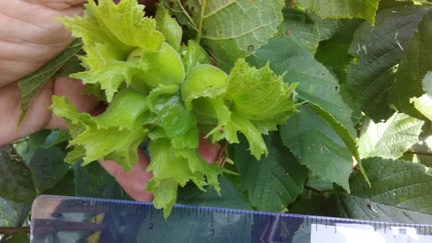 Dorris is a new hazelnut cultivar for the blanched kernel and in-shell markets. It was released by the Oregon Agricultural Experiment Station in Feb. 2011. It combines high resistance to eastern filbert blight (EFB) caused by the fungus Anisogramma anomala and bud mites (primarily Phytoptus avellanae Nal.) with high nut yield, medium nut size, attractive nuts and kernels, and excellent kernel flavor. Compared with the standard Barcelona, Dorris has smaller trees, similar yields per tree, higher nut yield efficiency, and similar nut maturity. Most of the pellicle is removed from Dorris kernels by dry heat, giving an attractive white kernel. Also, kernel texture and flavor are excellent, making them suitable for many end uses, although they are larger than ideal for the kernel market. Large nuts of Dorris are also suited to the in-shell market. York and Felix are suggested pollinators. Also compatible with Yamhill and McDonald. Zones 4-8 Space 12'circles.
Dorris is a new hazelnut cultivar for the blanched kernel and in-shell markets. It was released by the Oregon Agricultural Experiment Station in Feb. 2011. It combines high resistance to eastern filbert blight (EFB) caused by the fungus Anisogramma anomala and bud mites (primarily Phytoptus avellanae Nal.) with high nut yield, medium nut size, attractive nuts and kernels, and excellent kernel flavor. Compared with the standard Barcelona, Dorris has smaller trees, similar yields per tree, higher nut yield efficiency, and similar nut maturity. Most of the pellicle is removed from Dorris kernels by dry heat, giving an attractive white kernel. Also, kernel texture and flavor are excellent, making them suitable for many end uses, although they are larger than ideal for the kernel market. Large nuts of Dorris are also suited to the in-shell market. York and Felix are suggested pollinators. Also compatible with Yamhill and McDonald. Zones 4-8 Space 12'circles.
View detailed information
|
| Felix Filbert - Corylus avellana |
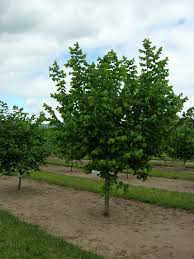 Felix Filbert named after a French tree importer who introduced popular hazelnut varieties in the 1800s to Oregon, can serve as a pollenizer for Jefferson, a recently introduced EFB-resistant standard variety. York's earlier pollenshed leaves off where Theta takes over to give total pollenation to Jefferson for the second-half of the winter pollination season. Felix can be used during the first half. With that combination you get good coverage throughout the bloom. York is also Filbert Blight resistant. Zones 4-8 Space 10-12'circle
Felix Filbert named after a French tree importer who introduced popular hazelnut varieties in the 1800s to Oregon, can serve as a pollenizer for Jefferson, a recently introduced EFB-resistant standard variety. York's earlier pollenshed leaves off where Theta takes over to give total pollenation to Jefferson for the second-half of the winter pollination season. Felix can be used during the first half. With that combination you get good coverage throughout the bloom. York is also Filbert Blight resistant. Zones 4-8 Space 10-12'circle
View detailed information
|
| Precocious American Filbert - Corylus americana x avellana |
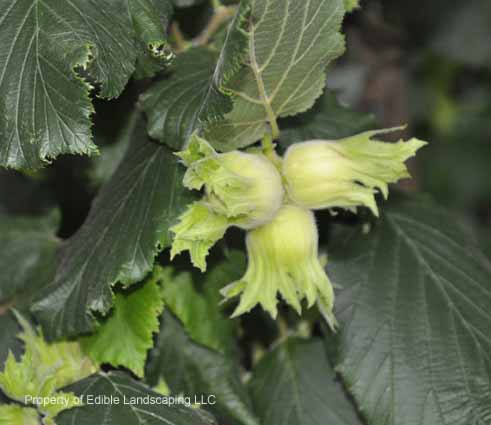 "Precocious" American Filbert is a Eastern Filbert Blight resistant filbert/hazelnut. This is an American filbert hybrid that will start producing nuts 3 to 4 years from seedling. Two Precocious American Filberts will pollinate each other or plant with another American Filbert for pollination. Zone 3-8
"Precocious" American Filbert is a Eastern Filbert Blight resistant filbert/hazelnut. This is an American filbert hybrid that will start producing nuts 3 to 4 years from seedling. Two Precocious American Filberts will pollinate each other or plant with another American Filbert for pollination. Zone 3-8
View detailed information
|
Due to import restrictions we are unable to ship Pecans to CA,...
| Colby Pecan - Carya illinoiensis |
|---|
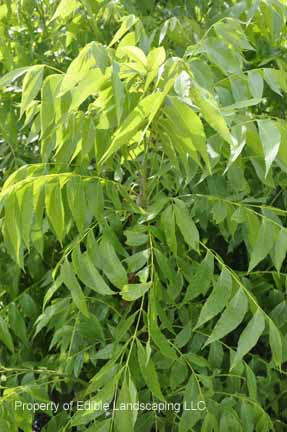 Medium size, long oval nut, Matures in 160 day growing season. Tree is vigorous and productive; resistant to leaf fungi; retains its foliage late into the fall; a heavy pollen producer. Originated in Fayette County, IL. Pollinates with Major or Peruque. Zones 6-8. Native Space 20' to 30' circle, height 20'-30'.
Medium size, long oval nut, Matures in 160 day growing season. Tree is vigorous and productive; resistant to leaf fungi; retains its foliage late into the fall; a heavy pollen producer. Originated in Fayette County, IL. Pollinates with Major or Peruque. Zones 6-8. Native Space 20' to 30' circle, height 20'-30'.
View detailed information Please contact our office to see about availability. 434.361.9134
|
| Kanza Pecan - Carya illinoisenses |
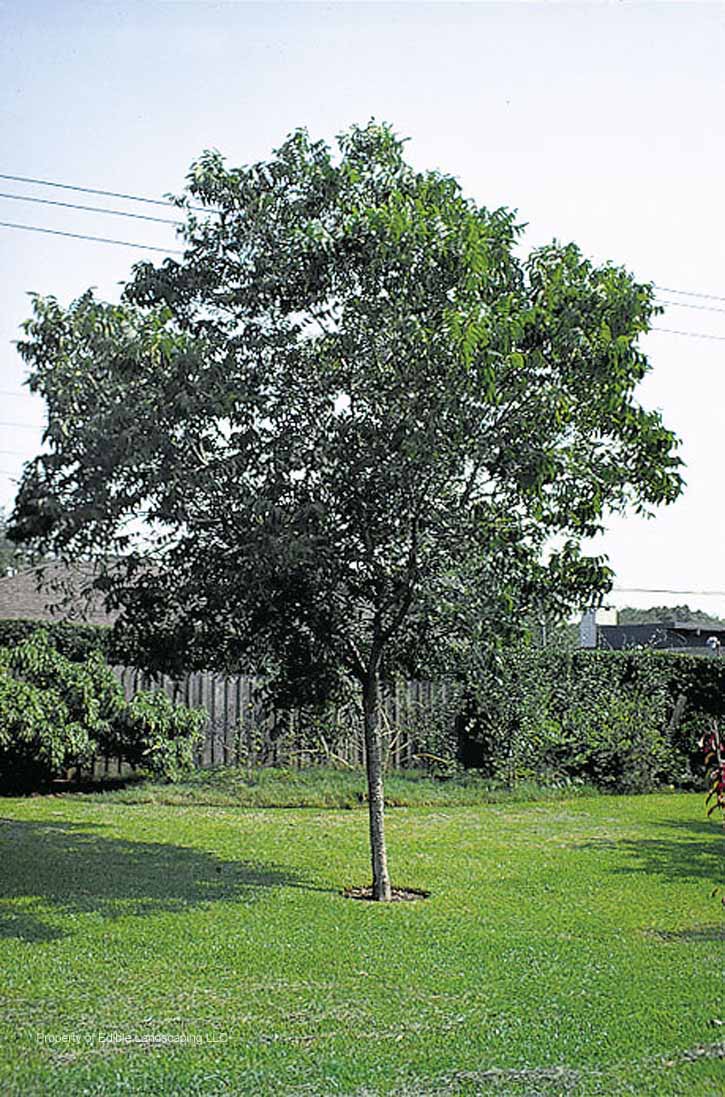 An early maturing large nut averaging 69lbs of nuts per tree. Introduced from Texas. Space 25' circle. We have Kanza grafted on a hardy 160 day nut maturing rootstock. The rootstock goes dormant sooner than if Kanza was grafted on a southern rootstock, making it hardy in zone 7 and 6. Locally Kanza is a favorite. The trees stay lush green throughout the summer and the nuts show no signs of pecan scab. Will start producing in 3 to 4 years. Pollinates with Major or Peruque. Zones 6-8
An early maturing large nut averaging 69lbs of nuts per tree. Introduced from Texas. Space 25' circle. We have Kanza grafted on a hardy 160 day nut maturing rootstock. The rootstock goes dormant sooner than if Kanza was grafted on a southern rootstock, making it hardy in zone 7 and 6. Locally Kanza is a favorite. The trees stay lush green throughout the summer and the nuts show no signs of pecan scab. Will start producing in 3 to 4 years. Pollinates with Major or Peruque. Zones 6-8
View detailed information
|
| Hardy Pecan Seedling - Carya illinoinensis |
 Hardy strain of pecan good for planting zones 6 and 7. Mostly planted for wildlife.Full size tree up to sixty feet. Forty foot spacing.
Hardy strain of pecan good for planting zones 6 and 7. Mostly planted for wildlife.Full size tree up to sixty feet. Forty foot spacing.
View detailed information
|
| Peruque Pecan - Carya illinoinensis |
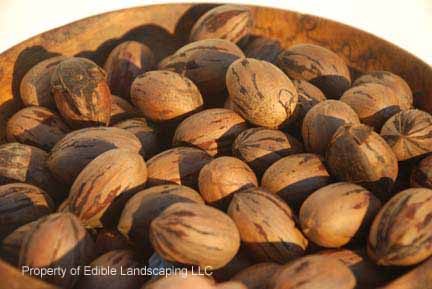 The Peruque pecan is an early season producer derived from a selection of native seedlings near the Mississippi River. Average production is 81 nuts per pound, with 59% kernel. Peruque kernels are golden, with tight dorsal groves. Prefers moist soils. Medium sized, thin shelled nuts with a 160 day ripening season. Recommended for USDA hardiness zones 6-8 and warmer parts of zone 5. Partly self fruitful. Pollinators include Lakota, Oswego, Kanza and Colby.
The Peruque pecan is an early season producer derived from a selection of native seedlings near the Mississippi River. Average production is 81 nuts per pound, with 59% kernel. Peruque kernels are golden, with tight dorsal groves. Prefers moist soils. Medium sized, thin shelled nuts with a 160 day ripening season. Recommended for USDA hardiness zones 6-8 and warmer parts of zone 5. Partly self fruitful. Pollinators include Lakota, Oswego, Kanza and Colby.
View detailed information Please contact our office to see about availability. 434.361.9134
|
| Lakota Pecan - Carya illinoisenses |
|
'Lakota' is an early maturing nut with excellent flavor, averaging 58lbs of nuts per tree. Introduced from USDA. 'Lakota' is a vigorous growing upright tree, strong and wind resistant. Pollinates with Major or Peruque. Space 25' circle. 'Lakota' is very resistant to scab disease. Zones 6-8
View detailed information Please contact our office to see about availability. 434.361.9134
|
| Oswego Pecan - Carya illinoisenses |
|
Oswego is a seedling of the great old variety Green River selected by Dr. William Ried at KSU. Oswego was chosen for its excellent disease resistance and heavy annual production. Needs Peruque or Major for pollination. Zone 6-8
View detailed information
|
| Major Pecan - Carya illinoisenses |
|
Major is a heavy annual bearing pecan tree. Nuts are medium-sized, thin shelled, easy to crack and is one of the best flavored pecans available. Pollinated by Lakota, Oswego, Kanza, and Colby. Zones 6-8
View detailed information Sorry, we are currently out of this item, please check back!
|
Due to import restrictions we are unable to ship Pines to CA...
| Italian Stone Pine - Pinus pinea |
|---|
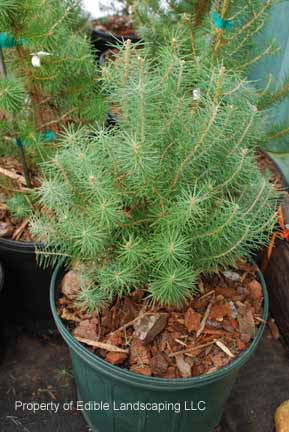 Italian Stone Pine has decorative pine cones and can give an abundant crop of pignolia nuts. The plants are sold as miniature Christmas trees and are ornamental outside. One of the few pines that grow well in alkaline soil. Two trees needed for pollination. Space 20' circle. Zones 7-8.
Italian Stone Pine has decorative pine cones and can give an abundant crop of pignolia nuts. The plants are sold as miniature Christmas trees and are ornamental outside. One of the few pines that grow well in alkaline soil. Two trees needed for pollination. Space 20' circle. Zones 7-8.
View detailed information Sorry, we are currently out of this item, please check back!
|
| Korean Stone Pine - Pinus korensis |
 Korean Stone Pine is a five needle ornamental hardy pine with pine nuts similar to the ones found in the grocery stores. Slow growing medium size tree. Extremely hardy and tolerant of clay soils. Resistant to white pine blister rust. Korean Stone Pine is hardier than Italian Stone Pine. The blue pyramidal form of the tree is a show piece for the yard. Cones contain many pine nuts. Zone 4-7
Korean Stone Pine is a five needle ornamental hardy pine with pine nuts similar to the ones found in the grocery stores. Slow growing medium size tree. Extremely hardy and tolerant of clay soils. Resistant to white pine blister rust. Korean Stone Pine is hardier than Italian Stone Pine. The blue pyramidal form of the tree is a show piece for the yard. Cones contain many pine nuts. Zone 4-7
View detailed information Sorry, we are currently out of this item, please check back!
|
| Heartnut aka Japanese Walnut - Juglans ailantifolia |
|---|
 An easy-to-grow, spreading, attractive tree with large sweet nuts that halve easily. Abundant foliage, bears early and is hardy. A sweeter, easier-cracking nut than black walnut. A good shade tree with a spreading habit that's prettier in the landscape than black walnut. Susceptible to Walnut Bunch Disease in the deep south. We have grown Heartnuts for 15 years and have not noticed the disease. For the areas of Zone 8 the disease could be more of a problem. Self fruitful 20' to 35' recommended spacing. Zones 5-8.
An easy-to-grow, spreading, attractive tree with large sweet nuts that halve easily. Abundant foliage, bears early and is hardy. A sweeter, easier-cracking nut than black walnut. A good shade tree with a spreading habit that's prettier in the landscape than black walnut. Susceptible to Walnut Bunch Disease in the deep south. We have grown Heartnuts for 15 years and have not noticed the disease. For the areas of Zone 8 the disease could be more of a problem. Self fruitful 20' to 35' recommended spacing. Zones 5-8.
View detailed information Please contact our office to see about availability. 434.361.9134
|
| Native Black Walnut - Juglans nigra |
 One of the best Native Trees. A most important tree in any landscape. For nutrition, timber, beauty, medicine and shade, Black Walnuts are defined with the fabric of nature and living things.Zones 4-9 Space 20-40'
One of the best Native Trees. A most important tree in any landscape. For nutrition, timber, beauty, medicine and shade, Black Walnuts are defined with the fabric of nature and living things.Zones 4-9 Space 20-40'
View detailed information Please contact our office to see about availability. 434.361.9134
|
Due to import restrictions we are unable to ship Cherries, Bush to CA,Europe...
| Nanking White Cherry Bush - Prunus tomentosa |
|---|
 The sweetest of all the Nankings. A bush type cherry, very hardy with above average size fruit for the Nanking. Best in full sun as a foundation plant or as a fruitful hedge. Can also be grown in a container. Not always self fertile, to insure fruit set plant two. This is the best Nanking strain for eating fresh. We have three different stock plants of Nanking White cherries ie; #1, #2, and #3. If ordering more than one white fruiting Nanking, to insure cross pollination, choose any red Nanking or a different numbered white Nanking. For landscape effect Japanese plums bloom later but overlap with Nanking cherry. Height 4' - 8'. Space 6' circle. Zones 3-7.
The sweetest of all the Nankings. A bush type cherry, very hardy with above average size fruit for the Nanking. Best in full sun as a foundation plant or as a fruitful hedge. Can also be grown in a container. Not always self fertile, to insure fruit set plant two. This is the best Nanking strain for eating fresh. We have three different stock plants of Nanking White cherries ie; #1, #2, and #3. If ordering more than one white fruiting Nanking, to insure cross pollination, choose any red Nanking or a different numbered white Nanking. For landscape effect Japanese plums bloom later but overlap with Nanking cherry. Height 4' - 8'. Space 6' circle. Zones 3-7.
View detailed information
|
| Nanking Red Bush Cherry - Prunus tomentosa |
 Same bush type characteristics of Nanking White. Ripe fruits are juicy, sub-acid to sweet, eaten raw or preserved. At the Edible Park in downtown Asheville NC, kids love them fresh from the bush. Not always self fertile, to insure fruit set, plant 2. Space 6 feet. For landscape effect Japanese plums blooms overlap Nanking cherry. Zones 3-7.
Same bush type characteristics of Nanking White. Ripe fruits are juicy, sub-acid to sweet, eaten raw or preserved. At the Edible Park in downtown Asheville NC, kids love them fresh from the bush. Not always self fertile, to insure fruit set, plant 2. Space 6 feet. For landscape effect Japanese plums blooms overlap Nanking cherry. Zones 3-7.
View detailed information
|
| Consort Black Currant - Ribes ussuriense |
|---|
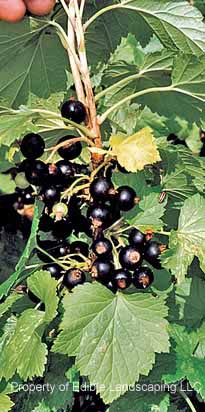 Consort is a productive rust resistant European black currant. It was bred and selected in Canada for immunity to White Pine Blister Rust.Clusters of medium size fruit mature in June on this small, compact bush 4-5' tall and wide. Consort likes rich sweet soil, but is widely adaptable and can thrive with neglect especially in the northeast US. Europeans love its assertive flavor and aroma and it is a benefit nutritionally for anyone that includes them in their diet, being high in vitamin C and omega fatty acids. Consort will grow and fruit in full shade and usually holds its leaves better in late summer in the shade in the warmer climate zones of its adaptability. It does not have showy flowers like American Black Currants nor is it the grape derived small raisin called currants in the health food stores. But they are cassis, commercially sold in soda, juice, wine, liquor or concentrate. Space 5' circle. Zones 4-7.
Consort is a productive rust resistant European black currant. It was bred and selected in Canada for immunity to White Pine Blister Rust.Clusters of medium size fruit mature in June on this small, compact bush 4-5' tall and wide. Consort likes rich sweet soil, but is widely adaptable and can thrive with neglect especially in the northeast US. Europeans love its assertive flavor and aroma and it is a benefit nutritionally for anyone that includes them in their diet, being high in vitamin C and omega fatty acids. Consort will grow and fruit in full shade and usually holds its leaves better in late summer in the shade in the warmer climate zones of its adaptability. It does not have showy flowers like American Black Currants nor is it the grape derived small raisin called currants in the health food stores. But they are cassis, commercially sold in soda, juice, wine, liquor or concentrate. Space 5' circle. Zones 4-7.
View detailed information
|
| Crandall American Black - Ribes odoratum |
 In the spring Crandall is a massive array of yellow trumpet shaped flowers. A most striking ornamental found in the best gardens in Europe. Swallowtail butterflies flock to the blooms. Also called Clove Currant and Missouri Currant. The unique taste of the shiny black fruit is pleasant. Height 4-5' Native, space 5' circle. Zones 4-7.
In the spring Crandall is a massive array of yellow trumpet shaped flowers. A most striking ornamental found in the best gardens in Europe. Swallowtail butterflies flock to the blooms. Also called Clove Currant and Missouri Currant. The unique taste of the shiny black fruit is pleasant. Height 4-5' Native, space 5' circle. Zones 4-7.
View detailed information Please contact our office to see about availability. 434.361.9134
|
| Cherry Red Currant - Ribes sativum |
 Cherry Red currant's fruit clusters are short and loose. The berries are very large, bright dark red, acidic and good. Plants are vigorous, upright and productive. Cherry Red resists mildew, a real plus in humid areas. A small bush in the landscape, Cherry Red is good in shade against buildings and with borders including strawberries or low growing herbs or flowers. Mixing with Josta or white and black currants 5' apart is fine since they are similar in size and habit. Space 5' circle Height 4-5' Zones 3-7.
Cherry Red currant's fruit clusters are short and loose. The berries are very large, bright dark red, acidic and good. Plants are vigorous, upright and productive. Cherry Red resists mildew, a real plus in humid areas. A small bush in the landscape, Cherry Red is good in shade against buildings and with borders including strawberries or low growing herbs or flowers. Mixing with Josta or white and black currants 5' apart is fine since they are similar in size and habit. Space 5' circle Height 4-5' Zones 3-7.
View detailed information Please contact our office to see about availability. 434.361.9134
|
| Primus White Currant - Ribes rubrum |
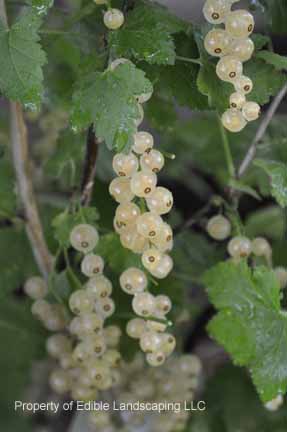 Primus is a compact bush bearing long fruit clusters. Highly productive, up to 20 pounds of fruit per bush. As most currants it is self fertile. Fruit color is whiter than other white currants. Released from Slovakia in 1977 from a cross of Heinemann's Rote Spatlese X Red Lake. Zones 3-7 Space 5' circle Height 4-5'
Primus is a compact bush bearing long fruit clusters. Highly productive, up to 20 pounds of fruit per bush. As most currants it is self fertile. Fruit color is whiter than other white currants. Released from Slovakia in 1977 from a cross of Heinemann's Rote Spatlese X Red Lake. Zones 3-7 Space 5' circle Height 4-5'
View detailed information
|
| Red Lake Currant - Ribes Rubrum |
 Red Lake is a extremely ornamental mounding shrub 3'-5' tall and 3'-5' wide, with large clusters of flavorful bright red berries. Red Lake makes an excellent hedge! Red Lake is very cold hardy, mid afternoon shade is recommended for warmer summer climates. Plant in well drained fertile soil, dig in organic mulch for clay soils. Self fertile. Zone 3-7.
Red Lake is a extremely ornamental mounding shrub 3'-5' tall and 3'-5' wide, with large clusters of flavorful bright red berries. Red Lake makes an excellent hedge! Red Lake is very cold hardy, mid afternoon shade is recommended for warmer summer climates. Plant in well drained fertile soil, dig in organic mulch for clay soils. Self fertile. Zone 3-7.
View detailed information Sorry, we are currently out of this item, please check back!
|
| Cornelian Cherry Dogwood - Cornus mas |
|---|
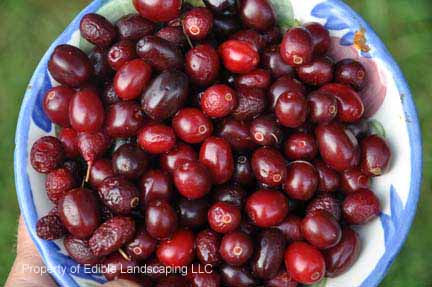 Cornelian Cherry has similar leaves and the same red fall color as the popular dogwood. It is a large, round bush up to 20' tall. Fruit is about 3/4" x 1/2" and plentiful on the tree, ripening in August. A few days after picking, fruits become soft and have a great, fresh taste, reminiscent of canned cranberry sauce. The yellow blossoms on naked gray branches rival witch hazel in beauty. Blooming in the late winter or very early in the springtime with daffodil. Needs a mate for fruit. Space 20 feet Zones 4-7.
Cornelian Cherry has similar leaves and the same red fall color as the popular dogwood. It is a large, round bush up to 20' tall. Fruit is about 3/4" x 1/2" and plentiful on the tree, ripening in August. A few days after picking, fruits become soft and have a great, fresh taste, reminiscent of canned cranberry sauce. The yellow blossoms on naked gray branches rival witch hazel in beauty. Blooming in the late winter or very early in the springtime with daffodil. Needs a mate for fruit. Space 20 feet Zones 4-7.
View detailed information
|
| Pioneer Cornelian Cherry - Cornus mas |
 Pioneer is a large fruiting Ukrainian variety call Lukyanovskii in Urkraine. A great easy care ornamental bush, producing pear shaped fruit in August. Height 10'-12' Space 10'15' circle Zone 3-8
Pioneer is a large fruiting Ukrainian variety call Lukyanovskii in Urkraine. A great easy care ornamental bush, producing pear shaped fruit in August. Height 10'-12' Space 10'15' circle Zone 3-8
View detailed information Please contact our office to see about availability. 434.361.9134
|
| Red Star Cornelian Cherry - Cornus mas |
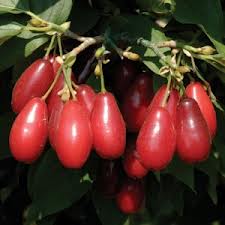 Red Star Cornelian Cherry was selected for its large tasty fruits. Called Vidubetskii in Ukraine, it is a fine pollinator for Pioneer. Height 10-12' Space 10-15' Zone 3-8
Red Star Cornelian Cherry was selected for its large tasty fruits. Called Vidubetskii in Ukraine, it is a fine pollinator for Pioneer. Height 10-12' Space 10-15' Zone 3-8
View detailed information
|
| Black Aronia - Aronia melanocarpa |
|---|
 Black Aronia is a small shrub about 6', with blueberry size black fruit that can be made into a healthy drink if sweetened.Blooms white flowers in spring followed by black fruits with vivid red leaves in the fall. Tolerates wet sites, sun or shade. Self fertile, not subject to any diseases or insect problems. Space 6' circle. Zones 3 - 8.
Black Aronia is a small shrub about 6', with blueberry size black fruit that can be made into a healthy drink if sweetened.Blooms white flowers in spring followed by black fruits with vivid red leaves in the fall. Tolerates wet sites, sun or shade. Self fertile, not subject to any diseases or insect problems. Space 6' circle. Zones 3 - 8.
View detailed information Please contact our office to see about availability. 434.361.9134
|
Due to import restrictions we are unable to ship Elaeagnus to CA...
| Sweet Scarlet Goumi - Eleagnus multiflora |
|---|
 Sweet Scarlet Goumi is an attractive small shrub with olive shaped leaves and silvery under tones. The wood of the plant is a rich red brown, and the flowers are dainty and white. The fruits are clustered and dense with a deep red color. Fruits can be eaten fresh with other fruit or green salads, and juiced or made into jellies and jams. Their ease of care and dependable cropping make this plant a valued part of your collection. Not bothered by bugs or disease it can be a center piece in the yard. It is also a nitrogen fixing plant.Space 6' circle Zones 4-8
Sweet Scarlet Goumi is an attractive small shrub with olive shaped leaves and silvery under tones. The wood of the plant is a rich red brown, and the flowers are dainty and white. The fruits are clustered and dense with a deep red color. Fruits can be eaten fresh with other fruit or green salads, and juiced or made into jellies and jams. Their ease of care and dependable cropping make this plant a valued part of your collection. Not bothered by bugs or disease it can be a center piece in the yard. It is also a nitrogen fixing plant.Space 6' circle Zones 4-8
View detailed information Please contact our office to see about availability. 434.361.9134
|
| Adams Elderberry - Sambucus canadensis |
|---|
 Adams is a native elderberry. Very juicy, purple berries, excellent for elixirs,pies, syrups,wine, etc. Late ripening and a heavy producer. Zones 3-9. Pollinates with other native elderberries. Very large flower heads. Height 6' to 12'. Space 10' circle Zone 3-9
Adams is a native elderberry. Very juicy, purple berries, excellent for elixirs,pies, syrups,wine, etc. Late ripening and a heavy producer. Zones 3-9. Pollinates with other native elderberries. Very large flower heads. Height 6' to 12'. Space 10' circle Zone 3-9
View detailed information Please contact our office to see about availability. 434.361.9134
|
| Johns Elderberry - Sambucus canadensis |
 Johns produces more fruits and earlier than other varieties. Very large clusters of medium size berries. Especially good for jelly and elderberry elixir. Larger plant than Adams. Zones 3-9. Pollinate with Adams. Very large flower heads. Height 6' to 12'. Space 8' to 10' circle.
Johns produces more fruits and earlier than other varieties. Very large clusters of medium size berries. Especially good for jelly and elderberry elixir. Larger plant than Adams. Zones 3-9. Pollinate with Adams. Very large flower heads. Height 6' to 12'. Space 8' to 10' circle.
View detailed information Please contact our office to see about availability. 434.361.9134
|
| Nova Elderberry - Sambucus canadensis |
 Nova was selected and introduced from Vineland Fruit Station, Ontario, Canada. Fruit clusters are above average and plant will set fruit planted alone. Does best in colder zones. Zones 3- 6. Smaller bush than Adams. Space 6' circle
Nova was selected and introduced from Vineland Fruit Station, Ontario, Canada. Fruit clusters are above average and plant will set fruit planted alone. Does best in colder zones. Zones 3- 6. Smaller bush than Adams. Space 6' circle
View detailed information
|
| Cut Leaf Elderberry - Sambucus nigra laciniata |
 A most beautiful form of European elderberry. A 6-8' shrub with deep cut lobed leaves followed by large heads of creamy white flowers and shiny berries. Pollinate with Black Lace, though we think it's self fertile. Space 6' to 8' circle Zones 3-9.
A most beautiful form of European elderberry. A 6-8' shrub with deep cut lobed leaves followed by large heads of creamy white flowers and shiny berries. Pollinate with Black Lace, though we think it's self fertile. Space 6' to 8' circle Zones 3-9.
View detailed information
|
| Black Lace Elderberry - Sambucus nigra |
 Dark purple-black leaves and pink flower clusters. Foliage stays dark throughout the growing season. Very ornamental.Resists leaf diseases. A European elderberry that fruits best with another European sort like Cut Leaf. Height 8'. Space 6' to 8' circle Zone 4-9.
Dark purple-black leaves and pink flower clusters. Foliage stays dark throughout the growing season. Very ornamental.Resists leaf diseases. A European elderberry that fruits best with another European sort like Cut Leaf. Height 8'. Space 6' to 8' circle Zone 4-9.
View detailed information Sorry, we are currently out of this item, please check back!
|
| Bob Gordon Elderberry - Sambucus canadensis |
|
View detailed information Please contact our office to see about availability. 434.361.9134
|
Due to import restrictions we are unable to ship Figs to Europe...
| Hardy Chicago Fig - Ficus carica |
|---|
 A brown fig, rich and sweet. Good for potted culture, although it is our most dependable outdoor fig. Hardy Chicago ripens its figs from August until fall frost and will have some fruit in July. Has produced as many as 100 pints of figs in one season. Does extremely well in NC and we send this one to enthusiasts up north, because of its early fruiting tendency. Success will vary with every location, so be sure to give it the warmest, most protected place. It's our best fig and came to our attention in the 1970's when cuttings for propagation came from Fred Borne, a North American Fruit Explorer member. Cuttings were supplied to him from a man from Chicago with a "U" shaped house, from a bush he had protected for some years. Without protection the mature bushes top would die back from winter cold, but sprouted from the roots and ripened some figs at the end of the season. Most fig varieties do not share this trait. Usually, a fig's above ground growth must survive the winter in order to fruit the following season. Leaves are the 5-lobed type and the plant has a bush form in the east. Space 8' to 10' circle in Zone 7. Zones 6-8.
A brown fig, rich and sweet. Good for potted culture, although it is our most dependable outdoor fig. Hardy Chicago ripens its figs from August until fall frost and will have some fruit in July. Has produced as many as 100 pints of figs in one season. Does extremely well in NC and we send this one to enthusiasts up north, because of its early fruiting tendency. Success will vary with every location, so be sure to give it the warmest, most protected place. It's our best fig and came to our attention in the 1970's when cuttings for propagation came from Fred Borne, a North American Fruit Explorer member. Cuttings were supplied to him from a man from Chicago with a "U" shaped house, from a bush he had protected for some years. Without protection the mature bushes top would die back from winter cold, but sprouted from the roots and ripened some figs at the end of the season. Most fig varieties do not share this trait. Usually, a fig's above ground growth must survive the winter in order to fruit the following season. Leaves are the 5-lobed type and the plant has a bush form in the east. Space 8' to 10' circle in Zone 7. Zones 6-8.
View detailed information
|
| Celeste Fig - Ficus carica |
 Celeste is also known in the South as the "Sugar Fig". A Southern tradition, long-lived and hardy, Celeste's reputation comes from many generations of people that have grown this fig. The "eye" at the bottom of the fruit is small, keeping insects out. Fruits main crop early on last years wood. Good for pots. Space 10' circle in Zone 7 and 12' circle in the South. Zones 6-9.
Celeste is also known in the South as the "Sugar Fig". A Southern tradition, long-lived and hardy, Celeste's reputation comes from many generations of people that have grown this fig. The "eye" at the bottom of the fruit is small, keeping insects out. Fruits main crop early on last years wood. Good for pots. Space 10' circle in Zone 7 and 12' circle in the South. Zones 6-9.
View detailed information
|
| Brown Turkey Fig - Ficus carica |
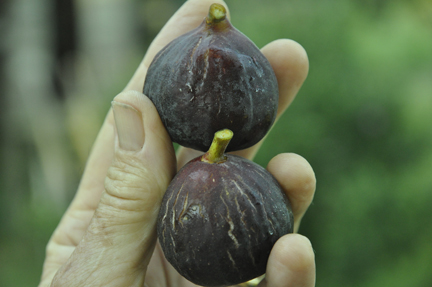 Brown Turkey fig does well in large pots and fruits well in Northern areas such as Long Island, NY. Very good against walls in Northern areas. Brown fruit with amber flesh. Space 8' to 10' circle Zones 6-9.
Brown Turkey fig does well in large pots and fruits well in Northern areas such as Long Island, NY. Very good against walls in Northern areas. Brown fruit with amber flesh. Space 8' to 10' circle Zones 6-9.
View detailed information
|
| LSU Purple Fig - Ficus carica |
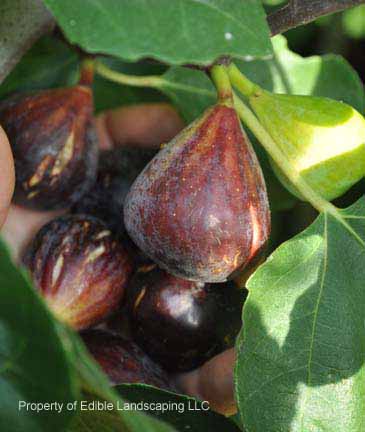 LSU Purple fig is a very reliable, prolific producer of early to late delicious figs. One of the best figs to come along for some time. Excellent for containers, producing early figs as soon as growth starts. Very acclimated to the fluctuating weather of the South, does great in Virginia Beach. Zones 7-9. Has fruited well at our nursery (zone 7). A customer from Hamilton Square, NJ (zone 6) is fruiting LSU Purple successfully outside. More nematode resistant than most figs in Florida. Best to pick a few days after fruit turns black, wrinkles and elongates. Space 10' to 12' circle
LSU Purple fig is a very reliable, prolific producer of early to late delicious figs. One of the best figs to come along for some time. Excellent for containers, producing early figs as soon as growth starts. Very acclimated to the fluctuating weather of the South, does great in Virginia Beach. Zones 7-9. Has fruited well at our nursery (zone 7). A customer from Hamilton Square, NJ (zone 6) is fruiting LSU Purple successfully outside. More nematode resistant than most figs in Florida. Best to pick a few days after fruit turns black, wrinkles and elongates. Space 10' to 12' circle
View detailed information
|
| Conadria Fig - Ficus carica |
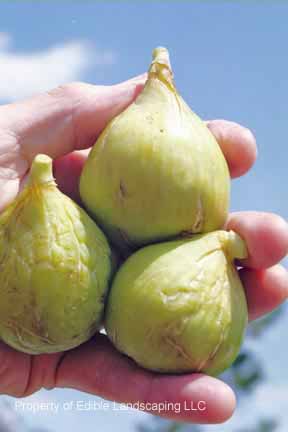 Conadria is our largest yellow fig with high sugar content. Some can set snugly in a tea cup. Can be used for dried figs and fresh fruit. Introduced in 1955 by Ira Condit USDA Riverside, CA. Fruit resists spoilage in rainy weather and has a small eye so it rates good for insect resistance. Produces 2 crops. The 1st crop, breba crop is good, the second crop, very good. In zone 7 produces only one crop. Can be grown in a 10 gallon pot and planted in the ground, in the pot, after winter storage (temps no lower than 30 degrees F) where it will root through the pot and produce large excellent figs in summer, as experience by a hobbyist in Smyrna, Delaware. Plant is vigorous, precocious, widely planted in the San Joaquin Valley, CA. Zone 5-7 pots. Space 10' circle in Virginia and 15' circle Zone 8 & 9. Conadria has also been called Galbun mistakenly. Zone 7-9
Conadria is our largest yellow fig with high sugar content. Some can set snugly in a tea cup. Can be used for dried figs and fresh fruit. Introduced in 1955 by Ira Condit USDA Riverside, CA. Fruit resists spoilage in rainy weather and has a small eye so it rates good for insect resistance. Produces 2 crops. The 1st crop, breba crop is good, the second crop, very good. In zone 7 produces only one crop. Can be grown in a 10 gallon pot and planted in the ground, in the pot, after winter storage (temps no lower than 30 degrees F) where it will root through the pot and produce large excellent figs in summer, as experience by a hobbyist in Smyrna, Delaware. Plant is vigorous, precocious, widely planted in the San Joaquin Valley, CA. Zone 5-7 pots. Space 10' circle in Virginia and 15' circle Zone 8 & 9. Conadria has also been called Galbun mistakenly. Zone 7-9
View detailed information
|
| Violet de Bordeaux Fig - Ficus carica |
 Also known as Negronne, Violet de Bordeaux is a purplish-black fruit with rich strawberry pulp. Considered by many the finest tasting fig. Popular in the Northwest and West. Needs protection in cold winter areas. Good for home planting as tree is dwarf. Similar fruit to Black Mission, but hardier and a smaller size tree than Mission. Fruit ripens later than Hardy Chicago, Marseilles and Celeste. Closed eye. Space 8' circle. Zones 7b-9.
Also known as Negronne, Violet de Bordeaux is a purplish-black fruit with rich strawberry pulp. Considered by many the finest tasting fig. Popular in the Northwest and West. Needs protection in cold winter areas. Good for home planting as tree is dwarf. Similar fruit to Black Mission, but hardier and a smaller size tree than Mission. Fruit ripens later than Hardy Chicago, Marseilles and Celeste. Closed eye. Space 8' circle. Zones 7b-9.
View detailed information Please contact our office to see about availability. 434.361.9134
|
| Petite Negri - Ficus carica |
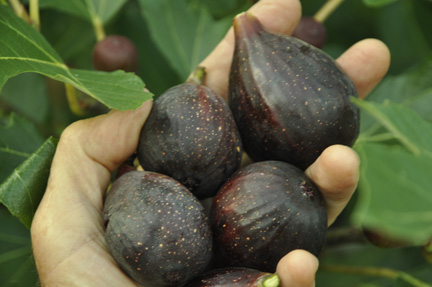 Petite Negri is a large black fig with excellent flavor. One of the best producers for pot culture. The dwarf plant is very productive. Similar to Black Mission and Violet de Bordeaux fig and produces an early and late crop when potted. Outside culture is for zones 7-9. Produces one crop outside at our nursery. Space 8' circle.
Petite Negri is a large black fig with excellent flavor. One of the best producers for pot culture. The dwarf plant is very productive. Similar to Black Mission and Violet de Bordeaux fig and produces an early and late crop when potted. Outside culture is for zones 7-9. Produces one crop outside at our nursery. Space 8' circle.
View detailed information Please contact our office to see about availability. 434.361.9134
|
| Texas BA-1 Fig - Ficus carica |
 Sweetest of our collection. Hardy in 7 if protected from the wind.Space 10' circle. Ripens 2 weeks later than Hardy Chicago. Zone 7-8
Sweetest of our collection. Hardy in 7 if protected from the wind.Space 10' circle. Ripens 2 weeks later than Hardy Chicago. Zone 7-8
View detailed information Please contact our office to see about availability. 434.361.9134
|
| Osborne Fig - Ficus carica |
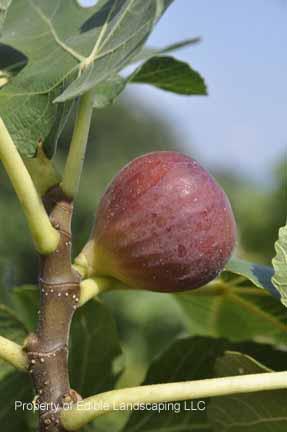 This fig has fruited for us at the nursery about one week after the St. Anthony Marseilles. It differs from most of our varieties with its reddish skin color and amber flesh. I enjoy this fig fresh in summer and fresh frozen in the winter. Space 8' circle. Zone 7-9.
This fig has fruited for us at the nursery about one week after the St. Anthony Marseilles. It differs from most of our varieties with its reddish skin color and amber flesh. I enjoy this fig fresh in summer and fresh frozen in the winter. Space 8' circle. Zone 7-9.
View detailed information
|
| Lattarulla Fig - Ficus carica |
 At our nursery Lattarulla ripens its yellow figs earlier then all others, usually starting in June or July. Because of fluctuating winter weather, these buds can become damaged and not fruit as much as in milder regions such as the Pacific Northwest. The fall crops are inferior fruit because they need pollination from a fig wasp that only lives in Europe in fig producing countries or parts of California. King fig seems to be the same as Lattarulla. Also called Danny's Delight, this fig has ripened its fruit near Lake Michigan outside. Figs are large, pale green to yellow, sweet and delicious. Fruits are well worth the effort since they are the first to ripen, usually in mid-June at our nursery. Success will vary in zones 6-8. Space 10' circles
At our nursery Lattarulla ripens its yellow figs earlier then all others, usually starting in June or July. Because of fluctuating winter weather, these buds can become damaged and not fruit as much as in milder regions such as the Pacific Northwest. The fall crops are inferior fruit because they need pollination from a fig wasp that only lives in Europe in fig producing countries or parts of California. King fig seems to be the same as Lattarulla. Also called Danny's Delight, this fig has ripened its fruit near Lake Michigan outside. Figs are large, pale green to yellow, sweet and delicious. Fruits are well worth the effort since they are the first to ripen, usually in mid-June at our nursery. Success will vary in zones 6-8. Space 10' circles
View detailed information
|
| Verte (Green Ischia) - Ficus carica |
 Verte ripens about the same time as LSU Purple, so best to grow in zone 7 - 8. In a long season fruits will dry on the tree around October. Very sweet and good for drying. Since they ripen with their outside color green, they will fool the birds. The dark red flesh is in total contrast to the green skin. Strawberry is used to describe the inside color of the fruit. Also called Green Ischia. In our area plants are bush like and of small stature like Violet de Bordeaux.Fruit flavor is excellent. Space about 8' - 10' circle in Zone 6 - 7 and space 12'-15' circle in Zone 8.
Verte ripens about the same time as LSU Purple, so best to grow in zone 7 - 8. In a long season fruits will dry on the tree around October. Very sweet and good for drying. Since they ripen with their outside color green, they will fool the birds. The dark red flesh is in total contrast to the green skin. Strawberry is used to describe the inside color of the fruit. Also called Green Ischia. In our area plants are bush like and of small stature like Violet de Bordeaux.Fruit flavor is excellent. Space about 8' - 10' circle in Zone 6 - 7 and space 12'-15' circle in Zone 8.Verte ripens on second year wood. Winter protection is cooler areas is a must if you want fruit that year. View detailed information
|
| Kadota Fig - Ficus carica |
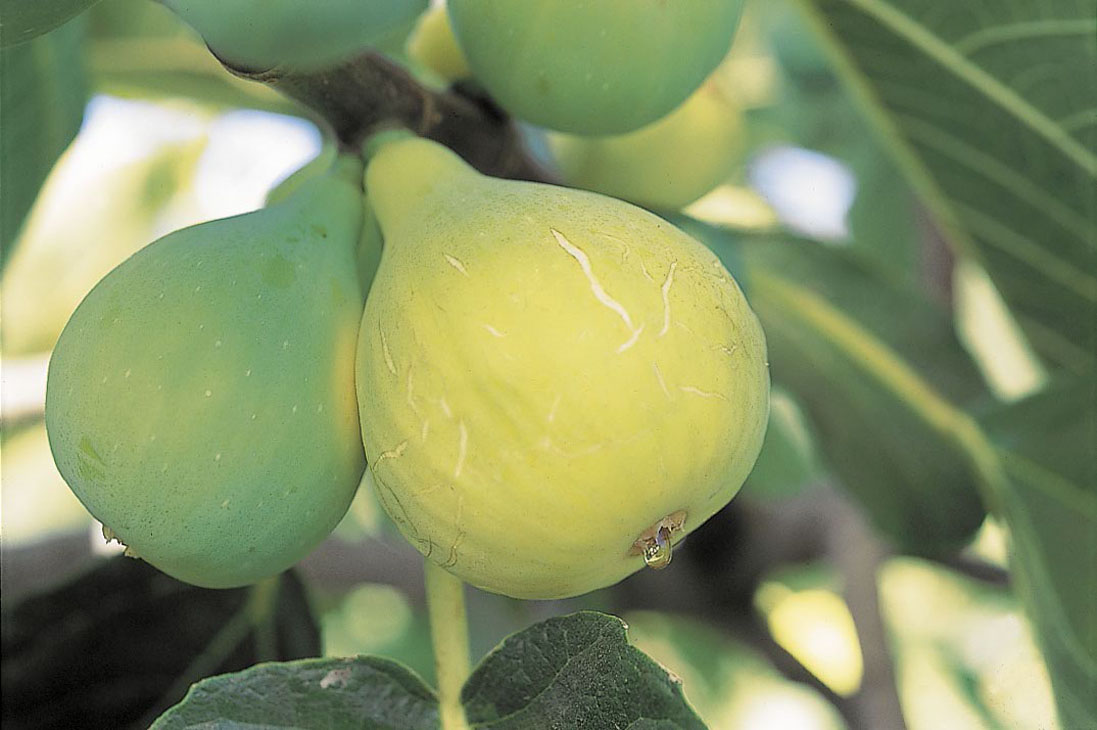 In zone 7, Kadota is an open bush, ripening most of its figs on last years growth. The fruits are yellow, medium to large size and delicious, ripening best with full sun and hot temperatures. Also known as Peter's Honey fig. Kadota is a popular fig because as a canned product it can be purchased in super markets in the US. Kadota is excellent fresh and very sweet. It sometimes ripens a few early figs that are extremely large. Space 10' circle
In zone 7, Kadota is an open bush, ripening most of its figs on last years growth. The fruits are yellow, medium to large size and delicious, ripening best with full sun and hot temperatures. Also known as Peter's Honey fig. Kadota is a popular fig because as a canned product it can be purchased in super markets in the US. Kadota is excellent fresh and very sweet. It sometimes ripens a few early figs that are extremely large. Space 10' circle
View detailed information Please contact our office to see about availability. 434.361.9134
|
| Panache Fig - Ficus carica |
 Extremely flavorful fig similar in taste and interior color to Verte, but its surface is striped yellow and green. Zone 8 - 10. Zone 7 with protection.
Extremely flavorful fig similar in taste and interior color to Verte, but its surface is striped yellow and green. Zone 8 - 10. Zone 7 with protection.
View detailed information
|
| Marseilles Fig - Ficus carica |
 Large yellow figs ripen the end of July on previous seasons growth. Very productive and early ripening. Produces an early main crop of short neck delicately sweet fruit. The plant slows it's growth into the fall and "hardens off" well. There is usually no young wood die back the following spring. Usually starts ripening a few weeks before Hardy Chicago and ends its production before Hardy Chicago does. Space 8'-10' circle, Zone 6 - 9. Also called Oregon Prolific and St. Anthony Fig.
Large yellow figs ripen the end of July on previous seasons growth. Very productive and early ripening. Produces an early main crop of short neck delicately sweet fruit. The plant slows it's growth into the fall and "hardens off" well. There is usually no young wood die back the following spring. Usually starts ripening a few weeks before Hardy Chicago and ends its production before Hardy Chicago does. Space 8'-10' circle, Zone 6 - 9. Also called Oregon Prolific and St. Anthony Fig.
View detailed information
|
| O'Rourke Fig - Ficus carica |
 O'Rourke flesh is golden with red near center of the fruit when soft ripe. Ripens before Celeste. Fruit hangs down when fully ripe. O'Rourke is more resistant to defoliation caused by fig leaf rust. Ripens its fruits early and continues late into the fall. A new variety from LSU with Celeste in its parentage. Zones 6-9 Space 10' circle
O'Rourke flesh is golden with red near center of the fruit when soft ripe. Ripens before Celeste. Fruit hangs down when fully ripe. O'Rourke is more resistant to defoliation caused by fig leaf rust. Ripens its fruits early and continues late into the fall. A new variety from LSU with Celeste in its parentage. Zones 6-9 Space 10' circle
View detailed information
|
| Olympian Fig - Ficus carica |
 Olympian fig won the Retailers Choice Award at the 2014 FarWest Show. Olympian is a cold hardy fig and absolutely delicious. This fig produces very sweet fruits with thin purple skin with a red to violet flesh. Discovered by retired biologist Denny McGaughy, he named it after the city where he found it in a sheltered location. Denny worked with Malli Aradhy, a geneticist with the U.S. Department of Agriculture's National Clonal Germplasm Repository to conduct DNA test to find out if it was a known cultivar. It did not match any of the 200+ figs in the repository. It appears Denny has found a unique heirloom variety that produces well in cool & coastal climates. Zone 7-9 May work in Zone 6 with warmer micro climate. Space 10' circle
Olympian fig won the Retailers Choice Award at the 2014 FarWest Show. Olympian is a cold hardy fig and absolutely delicious. This fig produces very sweet fruits with thin purple skin with a red to violet flesh. Discovered by retired biologist Denny McGaughy, he named it after the city where he found it in a sheltered location. Denny worked with Malli Aradhy, a geneticist with the U.S. Department of Agriculture's National Clonal Germplasm Repository to conduct DNA test to find out if it was a known cultivar. It did not match any of the 200+ figs in the repository. It appears Denny has found a unique heirloom variety that produces well in cool & coastal climates. Zone 7-9 May work in Zone 6 with warmer micro climate. Space 10' circle
View detailed information
|
| GE Neri Fig - Ficus carica |
|
GE Neri can be tennis ball size. An Italian fig regarded as very sweet.We are getting to know this variety and will add more about it as we grow it. Probably Zones 8-9 Space 10' circle
View detailed information
|
Due to import restrictions we are unable to ship Flowers to PR,...
| Purple Pavement Rose Hip Rose - Rosa rugusa |
|---|
 Purple Pavement Rose is also known as Rotsmere in Germany. It is a carefree dwarf rose. Healthy repeat blooms start a week later than Foxy Pavement and is very fragrant. Height 3' and same width. Purple Pavement will spread to a 6' circle. The very hardy shrub has huge red hips in late summer and fall. Leaves do not get leaf spot. Zones 3-8
Purple Pavement Rose is also known as Rotsmere in Germany. It is a carefree dwarf rose. Healthy repeat blooms start a week later than Foxy Pavement and is very fragrant. Height 3' and same width. Purple Pavement will spread to a 6' circle. The very hardy shrub has huge red hips in late summer and fall. Leaves do not get leaf spot. Zones 3-8
View detailed information Please contact our office to see about availability. 434.361.9134
|
| Snow Pavement Rose Hip Rose - Rosa rugusa |
 Snow pavement is also known as Schneekoppe. Flowers are white tinged with lavender pink, very fragrant, semi-double petals blooming throughout the growing season. Light red rose hips in summer and fall on this compact spreading bush. Leaves do not get leaf spot. Space 5' circle. Zones 3 - 8.
Snow pavement is also known as Schneekoppe. Flowers are white tinged with lavender pink, very fragrant, semi-double petals blooming throughout the growing season. Light red rose hips in summer and fall on this compact spreading bush. Leaves do not get leaf spot. Space 5' circle. Zones 3 - 8.
View detailed information
|
| Foxy Pavement Rose Hip Rose - Rosa rugusa |
 Foxy Pavement rose is a double pink, black spot immune, care free, three foot tall and wide dwarf rose bush. The deep pink variety is an improvement over Frau Dagmar Hastrup which it resembles. Good for tough conditions and very hardy, the heavenly fragrant flowers give way to large rose hips up to 1" in diameter, turning dark red in the fall. Space 3' to 5' circle Zones 3 - 8.
Foxy Pavement rose is a double pink, black spot immune, care free, three foot tall and wide dwarf rose bush. The deep pink variety is an improvement over Frau Dagmar Hastrup which it resembles. Good for tough conditions and very hardy, the heavenly fragrant flowers give way to large rose hips up to 1" in diameter, turning dark red in the fall. Space 3' to 5' circle Zones 3 - 8.
View detailed information Please contact our office to see about availability. 434.361.9134
|
| Light Pink Dwarf Pavement - Rosa Rugosa Hybrid |
|
View detailed information
|
| Phoenix Tears Goji Berry - Lycium barbarum |
|---|
 The rave of the health food industry, this Goji hails from China. A vining shrub up to 3'-6' tall. Fruits ripen throughout summer. Best to prune to a bush form. Hardy to -10 degrees F. Plant in full to partial sun with good soil drainage. Some extra lime to keep the pH up to 7 keeps Goji plants happy. Our self fertile variety is a seedling selected in Phoenix, AZ. The seeds originated from plants grown in Ningxia Provence, China, a main exporter of dried Goji berries. We've found that the berry sweetens for fresh eating in the late stages of ripeness, like tiny water balloons ready to drop at the slightest touch. Space 6' circle on trellis Zone 5-9
The rave of the health food industry, this Goji hails from China. A vining shrub up to 3'-6' tall. Fruits ripen throughout summer. Best to prune to a bush form. Hardy to -10 degrees F. Plant in full to partial sun with good soil drainage. Some extra lime to keep the pH up to 7 keeps Goji plants happy. Our self fertile variety is a seedling selected in Phoenix, AZ. The seeds originated from plants grown in Ningxia Provence, China, a main exporter of dried Goji berries. We've found that the berry sweetens for fresh eating in the late stages of ripeness, like tiny water balloons ready to drop at the slightest touch. Space 6' circle on trellis Zone 5-9
View detailed information
|
| Berry Blue Edible Honeysuckle (Haskap) - Lonicera kamtschatica |
|---|
 Berry Blue is our pollinator for Indigo Gem, Indigo Treat, and Tundra. A one to five ratio is fine as long as Berry Blue is included.Berry Blue is a Russian selection also called Czech 17 (P-17). It has an extended flowering period up to 8 weeks. If ordering only 2 varieties make sure one is Berryblue. These compact, small pretty European bushes are our first fruits to ripen at the nursery. Very hardy, they thrive in Siberia. The flowers are not showy or scented like a honeysuckle vine but the fruits are good. Blue, tart and flavorful, the fruits ripen before strawberries. Can be shy producers in areas prone to late frosts. Also known as Honeyberry and Haskap, Berryblue edible honeysuckle is a easy care addition to any landscape. They perform best in colder zones 5,4,and3. Zone 3-7. Space 4' circle
Berry Blue is our pollinator for Indigo Gem, Indigo Treat, and Tundra. A one to five ratio is fine as long as Berry Blue is included.Berry Blue is a Russian selection also called Czech 17 (P-17). It has an extended flowering period up to 8 weeks. If ordering only 2 varieties make sure one is Berryblue. These compact, small pretty European bushes are our first fruits to ripen at the nursery. Very hardy, they thrive in Siberia. The flowers are not showy or scented like a honeysuckle vine but the fruits are good. Blue, tart and flavorful, the fruits ripen before strawberries. Can be shy producers in areas prone to late frosts. Also known as Honeyberry and Haskap, Berryblue edible honeysuckle is a easy care addition to any landscape. They perform best in colder zones 5,4,and3. Zone 3-7. Space 4' circle
View detailed information
|
| Indigo Gem Haskap Honeysuckle - Lonicera Caerulea |
 These compact, small pretty European bushes are our first fruits to ripen at the nursery. Very hardy, they thrive in Siberia. The flowers are not showy or scented like a honeysuckle vine but the fruits are good. Blue, tart and flavorful, the fruits ripen before strawberries. Can be shy producers in areas prone to late frosts. Also known as Honeyberry, Ingigo Gem edible honeysuckle is a easy care addition to any landscape. They perform best in colder zones 5,4,and 3. Zone 3-7. Space 4' circle Indigo Gem's fruit is medium size with a sweet tangy flavor. Indigo Gem is a productive cultivar that is good for processing or fresh. Flowers profusely for about 6 weeks. indigo Gem needs Berry Blue to pollinate it. Zones 3-7 Space 4' circle
These compact, small pretty European bushes are our first fruits to ripen at the nursery. Very hardy, they thrive in Siberia. The flowers are not showy or scented like a honeysuckle vine but the fruits are good. Blue, tart and flavorful, the fruits ripen before strawberries. Can be shy producers in areas prone to late frosts. Also known as Honeyberry, Ingigo Gem edible honeysuckle is a easy care addition to any landscape. They perform best in colder zones 5,4,and 3. Zone 3-7. Space 4' circle Indigo Gem's fruit is medium size with a sweet tangy flavor. Indigo Gem is a productive cultivar that is good for processing or fresh. Flowers profusely for about 6 weeks. indigo Gem needs Berry Blue to pollinate it. Zones 3-7 Space 4' circleView detailed information
|
| Indigo Treat Haskap Honeysuckle - Lonicera kamtschatica |
 These compact, small pretty European bushes are our first fruits to ripen at the nursery. Very hardy, they thrive in Siberia. The flowers are not showy or scented like a honeysuckle vine but the fruits are good. Blue, tart and flavorful, the fruits ripen before strawberries. Can be shy producers in areas prone to late frosts. Also known as Honeyberry, Indigo Treat edible honeysuckle is a easy care addition to any landscape. They perform best in colder zones 5,4,and 3. Introduced from the University of Saskatchewan, Indigo Treat fruits are high in flavor and sweeter than most. The light blue fruits are longer and flatter than other cultivars, are attractive and have a sweet plum flavor. The plants have medium to high vigor growing to 5.5 feet tall, with average to high yields. Indigo Treat needs Berry Blue to set fruit. Zone 3-7. Space 4' circle
These compact, small pretty European bushes are our first fruits to ripen at the nursery. Very hardy, they thrive in Siberia. The flowers are not showy or scented like a honeysuckle vine but the fruits are good. Blue, tart and flavorful, the fruits ripen before strawberries. Can be shy producers in areas prone to late frosts. Also known as Honeyberry, Indigo Treat edible honeysuckle is a easy care addition to any landscape. They perform best in colder zones 5,4,and 3. Introduced from the University of Saskatchewan, Indigo Treat fruits are high in flavor and sweeter than most. The light blue fruits are longer and flatter than other cultivars, are attractive and have a sweet plum flavor. The plants have medium to high vigor growing to 5.5 feet tall, with average to high yields. Indigo Treat needs Berry Blue to set fruit. Zone 3-7. Space 4' circle
View detailed information
|
| Tundra Edible Haskap Honeysuckle - Lonicera kamtschatica |
 These compact, small pretty European bushes are our first fruits to ripen at the nursery. Very hardy, they thrive in Siberia. The flowers are not showy or scented like a honeysuckle vine but the fruits are good. Blue, tart and flavorful, the fruits ripen before strawberries. Can be shy producers in areas prone to late frosts. Also known as Honeyberry, Tundra edible honeysuckle is a easy care addition to any landscape. They perform best in colder zones 5,4,and 3.Tundra's fruits are large compared to other cultivars with the average fruit weighing 1.5 grams. The plump fruits are highly aromatic, black raspberry sweetness with a blueberry tang. Tundra has top rated flavor among all named varieties. The fruits shape, light blue color, and size are very attractive. Tundra needs Berry Blue to set fruit. Bush height 4-5' Zone 3-7. Space 4' circle.
These compact, small pretty European bushes are our first fruits to ripen at the nursery. Very hardy, they thrive in Siberia. The flowers are not showy or scented like a honeysuckle vine but the fruits are good. Blue, tart and flavorful, the fruits ripen before strawberries. Can be shy producers in areas prone to late frosts. Also known as Honeyberry, Tundra edible honeysuckle is a easy care addition to any landscape. They perform best in colder zones 5,4,and 3.Tundra's fruits are large compared to other cultivars with the average fruit weighing 1.5 grams. The plump fruits are highly aromatic, black raspberry sweetness with a blueberry tang. Tundra has top rated flavor among all named varieties. The fruits shape, light blue color, and size are very attractive. Tundra needs Berry Blue to set fruit. Bush height 4-5' Zone 3-7. Space 4' circle.
View detailed information
|
| Maxie Edible Haskap Honeysuckle Bush - Lonicera caerulea ssp. emphyllocalyx |
 The new Maxie edible honeysuckle bush is more adapted to moderate climates such as Virginia. We've grown edible honeysuckle bush varieties since 1989 with meager harvests. Maxie and Solo may prove to be more productive. The berries should be sweeter than other popular varieties with an 18 brix reading.(Measurement for sugars in fruit. 18 is minimal number for California grapes to be dried to raisins.) Maxie and Solo are bred by Maxine Thompson. She used a Japanese sub species in her breeding work resulting in a more adaptable sweeter plant and fruit. The Japanese term for these plants is Haskap. The bushes are pretty, compact with an extended blooming period. The flowers bloom later than other popular varieties which is a plus for areas of fluctuating winter temperatures. Maxie needs to be pollinated by Solo. Space 3' circle Zones 3-8
The new Maxie edible honeysuckle bush is more adapted to moderate climates such as Virginia. We've grown edible honeysuckle bush varieties since 1989 with meager harvests. Maxie and Solo may prove to be more productive. The berries should be sweeter than other popular varieties with an 18 brix reading.(Measurement for sugars in fruit. 18 is minimal number for California grapes to be dried to raisins.) Maxie and Solo are bred by Maxine Thompson. She used a Japanese sub species in her breeding work resulting in a more adaptable sweeter plant and fruit. The Japanese term for these plants is Haskap. The bushes are pretty, compact with an extended blooming period. The flowers bloom later than other popular varieties which is a plus for areas of fluctuating winter temperatures. Maxie needs to be pollinated by Solo. Space 3' circle Zones 3-8
View detailed information
|
| Solo Edible Haskap Honeysuckle Bush - Lonicera caerulea ssp. emphyllocalyx |
 The new Solo edible honeysuckle bush is more adapted to moderate climates such as Virginia. We've grown edible honeysuckle bush varieties since 1989 with meager harvests. Maxie and Solo may prove to be more productive. The berries should be sweeter than other popular varieties with an 18 brix reading.(Measurement for sugars in fruit. 18 is minimal number for California grapes to be dried to raisins.) Maxie and Solo are bred by Maxine Thompson. She used a Japanese sub species in her breeding work resulting in a more adaptable sweeter plant and fruit. The Japanese term for these plants is Haskap. The bushes are pretty, compact with an extended blooming period. The flowers bloom later than other popular varieties which is a plus for areas of fluctuating winter temperatures. Maxie needs to be pollinated by Solo. Solo is self fertile, but the fruits are twice the size if pollinated. Space 3' circle Zones 3-8
The new Solo edible honeysuckle bush is more adapted to moderate climates such as Virginia. We've grown edible honeysuckle bush varieties since 1989 with meager harvests. Maxie and Solo may prove to be more productive. The berries should be sweeter than other popular varieties with an 18 brix reading.(Measurement for sugars in fruit. 18 is minimal number for California grapes to be dried to raisins.) Maxie and Solo are bred by Maxine Thompson. She used a Japanese sub species in her breeding work resulting in a more adaptable sweeter plant and fruit. The Japanese term for these plants is Haskap. The bushes are pretty, compact with an extended blooming period. The flowers bloom later than other popular varieties which is a plus for areas of fluctuating winter temperatures. Maxie needs to be pollinated by Solo. Solo is self fertile, but the fruits are twice the size if pollinated. Space 3' circle Zones 3-8
View detailed information Sorry, we are currently out of this item, please check back!
|
| Edible Haskap Honeysuckle - Lonicera kamtschatica |
 These Haskap Honeysuckles lost their tags. They could be any of the following varieties - Indigo Gem, Indigo Treat, or Tundra. They need to be paired with Berry Blue Haskap for pollination. These compact, small pretty European bushes are our first fruits to ripen at the nursery. Very hardy, they thrive in Siberia. The flowers are not showy or scented like a honeysuckle vine but the fruits are good. Blue, tart and flavorful, the fruits ripen before strawberries. Can be shy producers in areas prone to late frosts. Also known as Honeyberry. Zone 3-7. Space 4' circle
These Haskap Honeysuckles lost their tags. They could be any of the following varieties - Indigo Gem, Indigo Treat, or Tundra. They need to be paired with Berry Blue Haskap for pollination. These compact, small pretty European bushes are our first fruits to ripen at the nursery. Very hardy, they thrive in Siberia. The flowers are not showy or scented like a honeysuckle vine but the fruits are good. Blue, tart and flavorful, the fruits ripen before strawberries. Can be shy producers in areas prone to late frosts. Also known as Honeyberry. Zone 3-7. Space 4' circle
View detailed information
|
| Regent Juneberry - Amelanchier alnifolia |
|---|
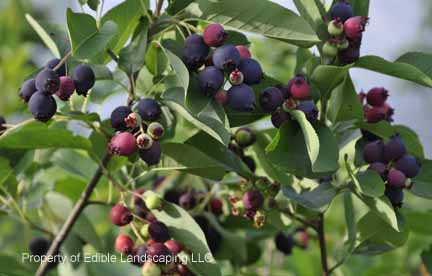 Regent is a hardy juneberry bush from South Dakota. The very productive bush has sweet blueberry like fruits up to 1/2" in diameter. The good red fall color, profuse white spring flowers, followed by bunches of fruit make this trouble-free plant an all season ornamental. The plant only reaches 4'-6' tall with the same spread. Great for easy picking. The fruits ripen the first week of June. Many of our clients just stand around the bush and enjoy. Plant a row of this native plant for effect or serious picking. Also called saskatoon and serviceberry in different parts of the country. Zones 4-8.
Regent is a hardy juneberry bush from South Dakota. The very productive bush has sweet blueberry like fruits up to 1/2" in diameter. The good red fall color, profuse white spring flowers, followed by bunches of fruit make this trouble-free plant an all season ornamental. The plant only reaches 4'-6' tall with the same spread. Great for easy picking. The fruits ripen the first week of June. Many of our clients just stand around the bush and enjoy. Plant a row of this native plant for effect or serious picking. Also called saskatoon and serviceberry in different parts of the country. Zones 4-8.
View detailed information Sorry, we are currently out of this item, please check back!
|
| Autumn Brilliance Juneberry - Amelanchier grandifolia |
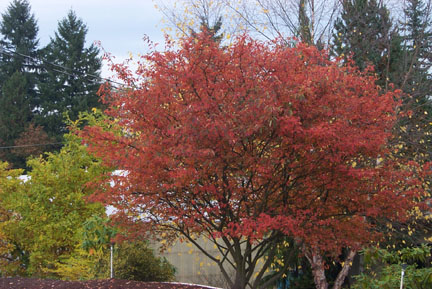 Autumn Brilliance Juneberry is an easy to grow native that adapts to a wide range of soils and climatic zones. Fruits are good size about one half inch in diameter and sweet and pleasant picked fresh. Also called serviceberry, Autumn Brilliance blooms a mass of clustered white flowers very early in spring and bears clusters of blueberry like fruits in June. Then, in the fall, the small tree turns vivid red. There is usually more than enough fruit for putting up for later use. Zones 3-8 Space 15' circle
Autumn Brilliance Juneberry is an easy to grow native that adapts to a wide range of soils and climatic zones. Fruits are good size about one half inch in diameter and sweet and pleasant picked fresh. Also called serviceberry, Autumn Brilliance blooms a mass of clustered white flowers very early in spring and bears clusters of blueberry like fruits in June. Then, in the fall, the small tree turns vivid red. There is usually more than enough fruit for putting up for later use. Zones 3-8 Space 15' circle
View detailed information
|
| Phil's Sweet Pomegranate - Prunica granatum |
|---|
 This variety is much sweeter than the store bought "Wonderful" variety. Medium to large fruit, skin slightly pink; seeds have a high sugar content with slight acid overtones. Seeds are soft and hardly noticeable. Shrub is productive but has suffered winter damage at the nursery. Soft seeded varieties are not as hardy as hard seeded varieties. Fruits are ripe towards the end of September here. Flowers are orange-red with a long bloom period.. Space 8'-10' circle. Hardy to 6 degrees F. when planted in a protected spot. Plant out of the wind in zone 7, perhaps near a building on the south or east side. Self fertile. Zones 7-10
This variety is much sweeter than the store bought "Wonderful" variety. Medium to large fruit, skin slightly pink; seeds have a high sugar content with slight acid overtones. Seeds are soft and hardly noticeable. Shrub is productive but has suffered winter damage at the nursery. Soft seeded varieties are not as hardy as hard seeded varieties. Fruits are ripe towards the end of September here. Flowers are orange-red with a long bloom period.. Space 8'-10' circle. Hardy to 6 degrees F. when planted in a protected spot. Plant out of the wind in zone 7, perhaps near a building on the south or east side. Self fertile. Zones 7-10
View detailed information Please contact our office to see about availability. 434.361.9134
|
| Russian Pomegranate Salavatski - Punica granatum |
 Dr. Chris Inhulsen, Montezuma, Ga., tested Russian pomegranates and found they survived winters where the popular "Wonderful" variety killed to the ground. The plants were reported to take -6 degrees F once, and at Montezuma, GA., 8 degrees F. Salavatski was his first choice for hardy, dependable, high quality fruit. The fruits as large as the store-bought "Wonderful" variety, and are orange-red in skin and red arils. Like "Wonderful" it is a hard seeded variety. According to Dr. Levin, the originator of the variety, the hard seeded varieties can withstand colder temperatures by a few degrees than the soft seeded varieties. We can thank Dr. Levin for the many pomegranate varieties.He has given us a new fruit for our area that is beautiful and easy to grow. At our nursery in Virginia, Salavatski has fruited yearly without winter damage to the plant. Space 8' to 10' circle. It's best to plant out of the winter winds. More protection and less in the open helps especially with younger plants. Self fertile, Salavatski has ripened in Lancaster, PA(Zone 6) planted on the south side of a home. Zones 7-10.
Dr. Chris Inhulsen, Montezuma, Ga., tested Russian pomegranates and found they survived winters where the popular "Wonderful" variety killed to the ground. The plants were reported to take -6 degrees F once, and at Montezuma, GA., 8 degrees F. Salavatski was his first choice for hardy, dependable, high quality fruit. The fruits as large as the store-bought "Wonderful" variety, and are orange-red in skin and red arils. Like "Wonderful" it is a hard seeded variety. According to Dr. Levin, the originator of the variety, the hard seeded varieties can withstand colder temperatures by a few degrees than the soft seeded varieties. We can thank Dr. Levin for the many pomegranate varieties.He has given us a new fruit for our area that is beautiful and easy to grow. At our nursery in Virginia, Salavatski has fruited yearly without winter damage to the plant. Space 8' to 10' circle. It's best to plant out of the winter winds. More protection and less in the open helps especially with younger plants. Self fertile, Salavatski has ripened in Lancaster, PA(Zone 6) planted on the south side of a home. Zones 7-10.
View detailed information
|
| Crimson Sky Pomegranate - Punica granatum |
 Nikitskii Ranii Pomegranate is called Crimson Sky in the US. Also called R19 when planted at the original University of Georgia test plot of Dr. Levin's hardiest varieties from Turkmanistan. Ranii in Russian means early. Crimson Sky ripens its fruits early in October. They are consistently bright red with a very appealing taste, sweet and tart. Very hardy like Salavatski. Self fertile. Space 10' circle Zone 7-8 For trial in zone 6
Nikitskii Ranii Pomegranate is called Crimson Sky in the US. Also called R19 when planted at the original University of Georgia test plot of Dr. Levin's hardiest varieties from Turkmanistan. Ranii in Russian means early. Crimson Sky ripens its fruits early in October. They are consistently bright red with a very appealing taste, sweet and tart. Very hardy like Salavatski. Self fertile. Space 10' circle Zone 7-8 For trial in zone 6
View detailed information
|
| Parfianka Russian Pomegranate - Punica granatum |
 Originally imported from Dr. Gregory Levin at the Garrigala agricultural station in Turkmenistan. Parfianka is a favored selection from a collection of over 1000 Pomegranate varieties. The fruit is quite large and highly colored in beautiful bright red. The arils are large and bright red with a very small, soft, edible seed. The fruit is of the highest quality.100 to 200 chill hours. Self fruitful. Space 10' circle. Zone 7B - 9.
Originally imported from Dr. Gregory Levin at the Garrigala agricultural station in Turkmenistan. Parfianka is a favored selection from a collection of over 1000 Pomegranate varieties. The fruit is quite large and highly colored in beautiful bright red. The arils are large and bright red with a very small, soft, edible seed. The fruit is of the highest quality.100 to 200 chill hours. Self fruitful. Space 10' circle. Zone 7B - 9.View detailed information
|
| Makedonia Red Pomegranate - Punica granatum |
|
Hardy pomegranate from Southern Europe near Greece. First grown in the US in Bethlehem, PA. Makedonia was sent to us several years ago. It has proven winter hardy here for the last several winters. Plant is bushy and compact. Zones 6-9 Space 6' circle
View detailed information
|
| Bala Mursal Russian Pomegranate - Punica |
 Bala Mursal is considered one of the best varieties for juicing, having 70 percent juice and 12 to 20 percent sugars. Skin color of fruit is deep red as is the juice. Fruits can keep for 3-4 months. Can produce up to 90 lbs. of fruit per bush. Commercially grown in Azerbaijan. It has succeeded in Georgia since the 70's. Also called Cranberry and R25 in the US. In Georgia trials along with Nikitski Ranni, had the highest fruit yield and post harvest attributes than all others tested. Reported as hardy as Salavatski. According to Michael Hothchkiss, past curator at the Georgia experimental planting, Bala is medium to large fruit, speckled pink/red rind. Seeds "pop" when you chew them. Good fresh eating with jam like flavor, but probably best for juice due to harder seed. Self fertile. Height up to 10 feet. Zones 7-9 Space 10' circles.
Bala Mursal is considered one of the best varieties for juicing, having 70 percent juice and 12 to 20 percent sugars. Skin color of fruit is deep red as is the juice. Fruits can keep for 3-4 months. Can produce up to 90 lbs. of fruit per bush. Commercially grown in Azerbaijan. It has succeeded in Georgia since the 70's. Also called Cranberry and R25 in the US. In Georgia trials along with Nikitski Ranni, had the highest fruit yield and post harvest attributes than all others tested. Reported as hardy as Salavatski. According to Michael Hothchkiss, past curator at the Georgia experimental planting, Bala is medium to large fruit, speckled pink/red rind. Seeds "pop" when you chew them. Good fresh eating with jam like flavor, but probably best for juice due to harder seed. Self fertile. Height up to 10 feet. Zones 7-9 Space 10' circles.
View detailed information
|
| R-35 Surh-anor Russian Pomegranate - Punica |
 Surh Anor is hardy and resists late winter cold and slow to break bud. Resistant to high humidity problems on the fruit. Vigorous bush, has preformed as well as Salavatski in Alma, Georgia. Part of the original test plot of Dr. Levin's best selections {R-35) from Turkmanistan at the USDA Byron Plant Station.A pink variety, very high quality large fruit. Consistently productive with clear to red speckled arils with a high sugar content. Zone 7-9 Space 12' circle
Surh Anor is hardy and resists late winter cold and slow to break bud. Resistant to high humidity problems on the fruit. Vigorous bush, has preformed as well as Salavatski in Alma, Georgia. Part of the original test plot of Dr. Levin's best selections {R-35) from Turkmanistan at the USDA Byron Plant Station.A pink variety, very high quality large fruit. Consistently productive with clear to red speckled arils with a high sugar content. Zone 7-9 Space 12' circle
View detailed information Please contact our office to see about availability. 434.361.9134
|
| Favorite Lyubimy Pomegranate - Punica granatum |
 Favorite is the Russian pomegranate variety Lyubimy which translates to Favorite. A promising selection even in protected areas of Zone 6. Medium size tree, space 8-10' circle. Self fertile. Zone 7-9
Favorite is the Russian pomegranate variety Lyubimy which translates to Favorite. A promising selection even in protected areas of Zone 6. Medium size tree, space 8-10' circle. Self fertile. Zone 7-9
View detailed information
|
Due to import restrictions we are unable to ship Quince to CA...
| Toyo Nishiki Flowering Quince - Cydonia oblonga |
|---|
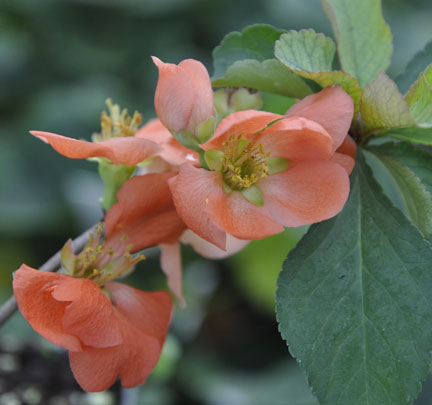 Toyo Nishiki Flowering Quince is a compact, ornamental shrub that's much more disease resistant than "fruiting quince". It thrives in the landscape. With large pinkish white blooms turning to larger than average fruits used for jellies and jams, especially mixed jams because the fruits contain a lot of pectin. The flowers bloom early with forsythia. Toyo-Nashiki is noted for bearing flowers of different colors (pinks, reds and whites) on the same branches. Interesting color variations also may occur on the same flower. Fruits mature in fall. Space 6' circle. Plants are 4-6' tall with about the same width. Zones 5-8
Toyo Nishiki Flowering Quince is a compact, ornamental shrub that's much more disease resistant than "fruiting quince". It thrives in the landscape. With large pinkish white blooms turning to larger than average fruits used for jellies and jams, especially mixed jams because the fruits contain a lot of pectin. The flowers bloom early with forsythia. Toyo-Nashiki is noted for bearing flowers of different colors (pinks, reds and whites) on the same branches. Interesting color variations also may occur on the same flower. Fruits mature in fall. Space 6' circle. Plants are 4-6' tall with about the same width. Zones 5-8
View detailed information Sorry, we are currently out of this item, please check back!
|
Due to import restrictions we are unable to ship Apples to CA...
| William's Pride Apple - Malus spp |
|---|
 Early maturing attractive, dark red apple with excellent tart fruit quality and immunity to apple scab. Extremely resistant to cedar apple rust and fire blight. For an out-of-hand apple this is the best for so early in the season. It blooms over a long span and produces annually. Zones 4-8.
Early maturing attractive, dark red apple with excellent tart fruit quality and immunity to apple scab. Extremely resistant to cedar apple rust and fire blight. For an out-of-hand apple this is the best for so early in the season. It blooms over a long span and produces annually. Zones 4-8.
View detailed information
|
| Arkansas Black Apple - Malus spp |
 Arkansas Black is a permaculture tree with good for you, deep red, winter keeping apples. Tree very disease resistant. Self fertile. Fruits are picked late in our area and mature their best flavor after a few months storage in the fridge. Arkansas Black Apple is chosen as a wildlife tree since the tree is disease resistant and the fruits hang well into the late fall. Standard tree spacing 20' circle, dwarf spacing 10' circle. Zones 5-8.
Arkansas Black is a permaculture tree with good for you, deep red, winter keeping apples. Tree very disease resistant. Self fertile. Fruits are picked late in our area and mature their best flavor after a few months storage in the fridge. Arkansas Black Apple is chosen as a wildlife tree since the tree is disease resistant and the fruits hang well into the late fall. Standard tree spacing 20' circle, dwarf spacing 10' circle. Zones 5-8.
View detailed information
|
| Pristine Apple - Malus spp |
 Even earlier than William's Pride. Pristine has good disease resistant to cedar apple rust and apple scab, but can get spur blight in wet springs. The bright yellow fruit dependably ripens here yearly. Excellent for fresh eating for such an early apple. A good keeper for an early apple. Texture is not hard like a winter apple, but crisp and zesty. A good substitute for Lodi apple, being good for apple sauce like Lodi but much better quality for eating out of hand. Space 10' circles for dwarf trees and 15' for semi-dwarf. Space 25' for standard. Zones 5-7.
Even earlier than William's Pride. Pristine has good disease resistant to cedar apple rust and apple scab, but can get spur blight in wet springs. The bright yellow fruit dependably ripens here yearly. Excellent for fresh eating for such an early apple. A good keeper for an early apple. Texture is not hard like a winter apple, but crisp and zesty. A good substitute for Lodi apple, being good for apple sauce like Lodi but much better quality for eating out of hand. Space 10' circles for dwarf trees and 15' for semi-dwarf. Space 25' for standard. Zones 5-7.
View detailed information
|
| Enterprise Apple - Malus spp |
 Enterprise is a very rich, spicy, super disease-resistant apple. Mellows in storage. Deep maroon color. Ripens in late September here and is delicious off the tree. Similar in taste to Fuji but much better disease resistance. Space standard size trees 20' circles and dwarf trees 10' circle. Zones 5-7.
Enterprise is a very rich, spicy, super disease-resistant apple. Mellows in storage. Deep maroon color. Ripens in late September here and is delicious off the tree. Similar in taste to Fuji but much better disease resistance. Space standard size trees 20' circles and dwarf trees 10' circle. Zones 5-7.
View detailed information
|
| Centennial Apple - Malus spp |
 Centennial is a low-spreading tree of about 12'. One of the sweeter more delicious ornamental apples for eating out-of-hand. Very hardy. Introduced from Excelsior, MN. Pretty early bloom and tree shape. Apples have a hint of crab apple flavor. Ripens here in August. Delicious cheese compliment. Zones 3-7.
Centennial is a low-spreading tree of about 12'. One of the sweeter more delicious ornamental apples for eating out-of-hand. Very hardy. Introduced from Excelsior, MN. Pretty early bloom and tree shape. Apples have a hint of crab apple flavor. Ripens here in August. Delicious cheese compliment. Zones 3-7.
View detailed information Please contact our office to see about availability. 434.361.9134
|
| Arkansas Black Spur Apple - Malus spp |
 Arkansas Black Spur is a more compact form of Arkansas Black apple. In spur growth the buds of the branches are closer together. The result is more flowering and leafing in a shorter distance. Since the branching is not as long, the tree is smaller, but very well rooted and anchored to the ground,since it's grafted on a seedling root. Fruits are large and very dark red. Keeps for months in storage. Non-browning in fruit salads. A very good tree for hot summer areas and needs 500-600 hours of winter temps below 45 degrees F. Height 10' and same width. Space 12' circle. Zone 5-8
Arkansas Black Spur is a more compact form of Arkansas Black apple. In spur growth the buds of the branches are closer together. The result is more flowering and leafing in a shorter distance. Since the branching is not as long, the tree is smaller, but very well rooted and anchored to the ground,since it's grafted on a seedling root. Fruits are large and very dark red. Keeps for months in storage. Non-browning in fruit salads. A very good tree for hot summer areas and needs 500-600 hours of winter temps below 45 degrees F. Height 10' and same width. Space 12' circle. Zone 5-8
View detailed information Please contact our office to see about availability. 434.361.9134
|
| Stayman Winesap Apple - Malus spp |
 Stayman Winesap trees can flourish without care. Examples of older trees in our area that are uncared for still produce usable fruit. Usually they go into alternate bearing and produce heavy crops every other year when not cared for. Trees are resistant like Arkansas Black Apple. The fruit can be very large. They ripen early fall and can soften quickly at room temperature, but will keep in the refrigerator for about 6 weeks. Flavor is tart-mild with a crisp texture, and very good eating. Excellent taste for juicing and cider blends. It is a favorite roadside market apple in Virginia. Developed in 1866 from Leavenworth KS. Stayman does not pollinate other apples, so it's a good trio tree, with 2 different varieties planted near by. Zone 5-8 800 chill hours required.
Stayman Winesap trees can flourish without care. Examples of older trees in our area that are uncared for still produce usable fruit. Usually they go into alternate bearing and produce heavy crops every other year when not cared for. Trees are resistant like Arkansas Black Apple. The fruit can be very large. They ripen early fall and can soften quickly at room temperature, but will keep in the refrigerator for about 6 weeks. Flavor is tart-mild with a crisp texture, and very good eating. Excellent taste for juicing and cider blends. It is a favorite roadside market apple in Virginia. Developed in 1866 from Leavenworth KS. Stayman does not pollinate other apples, so it's a good trio tree, with 2 different varieties planted near by. Zone 5-8 800 chill hours required.
View detailed information Please contact our office to see about availability. 434.361.9134
|
| Liberty Apple - Malus spp |
 Shiny, deep-red,(lighter the further south Liberty is grown) crisp apple that is scab immune and resistant to mildew, cedar apple rust and fire blight. Late summer ripening. Keeps well. One of the most disease resistant apples ever developed. Has a McIntosh aroma with a crisp, juicy flavor essence. Very productive, so keep about 3" between each fruit. Self fertile. Space dwarf, semi-dwarf and standard in circles of 10', 15', 20' respectively. Zones 4-7.
Shiny, deep-red,(lighter the further south Liberty is grown) crisp apple that is scab immune and resistant to mildew, cedar apple rust and fire blight. Late summer ripening. Keeps well. One of the most disease resistant apples ever developed. Has a McIntosh aroma with a crisp, juicy flavor essence. Very productive, so keep about 3" between each fruit. Self fertile. Space dwarf, semi-dwarf and standard in circles of 10', 15', 20' respectively. Zones 4-7.
View detailed information
|
| Seedless Che - Cudrania tricuspidata |
|---|
 Exclusively from Edible Landscaping our Seedless Che is a small rounded fall-fruiting ornamental tree. In the deep South Che ripens in mid-July, and in Virginia it ripens late September through October. Grafted on Osage orange to prevent suckering, these are superior trees. Bears splendid crop of lovely red fruit clusters over the entire tree. A center of attention at ripening time. Fully ripe fruits are juicy, sweet, very pleasant and fig-like in taste. Birds don't bother the fruits. Completely seedless and self fertile, does not need a male pollinator. Makes great "fig" preserves. Space 14' circle. Zones 6-9. May be hardy in the north, but no info is available on how well the fruit ripens. May have juvenile thorns on young plants.
Exclusively from Edible Landscaping our Seedless Che is a small rounded fall-fruiting ornamental tree. In the deep South Che ripens in mid-July, and in Virginia it ripens late September through October. Grafted on Osage orange to prevent suckering, these are superior trees. Bears splendid crop of lovely red fruit clusters over the entire tree. A center of attention at ripening time. Fully ripe fruits are juicy, sweet, very pleasant and fig-like in taste. Birds don't bother the fruits. Completely seedless and self fertile, does not need a male pollinator. Makes great "fig" preserves. Space 14' circle. Zones 6-9. May be hardy in the north, but no info is available on how well the fruit ripens. May have juvenile thorns on young plants.
View detailed information
|
Due to import restrictions we are unable to ship Cherries, Sour to CA,Europe,Canada,...
| Northstar Dwarf Sour Cherry - Prunus cerasus |
|---|
 Northstar is a sour Morello type cherry that's very tasty right off the tree. Fruits are large and the stone small and easily removed. Tree is a genetic dwarf, grows less than 10' tall. Self fertile, excellent for home gardens. Zones 5-8.
Northstar is a sour Morello type cherry that's very tasty right off the tree. Fruits are large and the stone small and easily removed. Tree is a genetic dwarf, grows less than 10' tall. Self fertile, excellent for home gardens. Zones 5-8.
View detailed information Please contact our office to see about availability. 434.361.9134
|
| Montmorency Sour Cherry - Prunus cerasus |
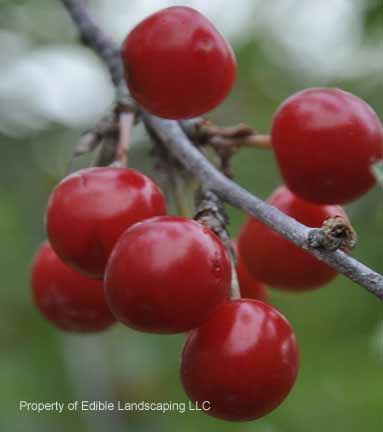 Montmorency pie cherry is the most widely known sour cherry planted throughout North America. The fruit is bright red with a clear juicy flesh. Trees are self fertile, winter hardy and very productive. Space 10-12 feet, height 10 feet. Zones 4-7
Montmorency pie cherry is the most widely known sour cherry planted throughout North America. The fruit is bright red with a clear juicy flesh. Trees are self fertile, winter hardy and very productive. Space 10-12 feet, height 10 feet. Zones 4-7
View detailed information Sorry, we are currently out of this item, please check back!
|
Due to import restrictions we are unable to ship Cherries, Sweet to CA, Europe...
| Rainier Sweet Cherry - Prunus avium |
|---|
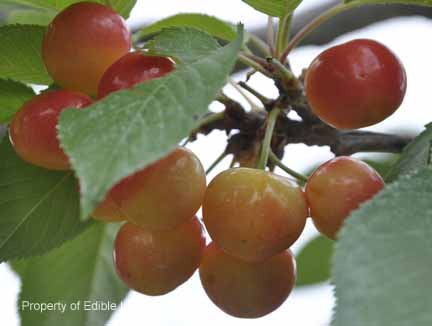 An outstanding, new, light colored yellow cherry with red blush. Flesh is very firm and finely textured with good quality and flavor. The yellow color outsmarts the birds as they go for the red cherries. Rainier has a distinct flavor superior to most varieties. Bears early, is bud hardy and resistant to cracking. Needs a pollinator, Sam or Stella are good. Space dwarf trees @ 10' circle. Space semi-dwarf trees 15' circle and standard cherry at a 20' circle. Zone 5-7
An outstanding, new, light colored yellow cherry with red blush. Flesh is very firm and finely textured with good quality and flavor. The yellow color outsmarts the birds as they go for the red cherries. Rainier has a distinct flavor superior to most varieties. Bears early, is bud hardy and resistant to cracking. Needs a pollinator, Sam or Stella are good. Space dwarf trees @ 10' circle. Space semi-dwarf trees 15' circle and standard cherry at a 20' circle. Zone 5-7
View detailed information Please contact our office to see about availability. 434.361.9134
|
| Sam Sweet Cherry - Prunus avium |
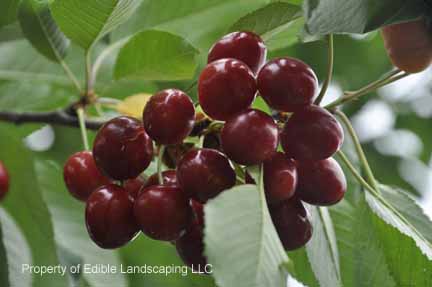 Sam is a black sweet cherry ripening early. Very crack resistant in wet weather. A favorite at the nursery. Good pollinator for Ranier. Canker resistant, which is very important for eastern conditions. More adapted than Bing sweet cherry to eastern conditions. Space dwarf at 10' circle, semi dwarf 15' circle and standards at 25' circles. Zones 5-7.
Sam is a black sweet cherry ripening early. Very crack resistant in wet weather. A favorite at the nursery. Good pollinator for Ranier. Canker resistant, which is very important for eastern conditions. More adapted than Bing sweet cherry to eastern conditions. Space dwarf at 10' circle, semi dwarf 15' circle and standards at 25' circles. Zones 5-7.
View detailed information Please contact our office to see about availability. 434.361.9134
|
| White Gold Sweet Cherry - Prunus avium |
 White Gold Cherry is self fertile. Its parents were Emperor Francis and the self fertile, red cherry, Stella. It is cold hardy in both mid-winter and spring frost situations. It is highly tolerant to cherry leaf spot and resistant to bacterial canker situations. White Gold yields heavily and resists cracking in rainy weather. A very good pollinator for other sweet cherries. Space 10' circle for dwarf on Krymst 5 or Giesla 5 rootstock 15' space for semi dwarf and 25' space on standard. Zone 4b-7.
White Gold Cherry is self fertile. Its parents were Emperor Francis and the self fertile, red cherry, Stella. It is cold hardy in both mid-winter and spring frost situations. It is highly tolerant to cherry leaf spot and resistant to bacterial canker situations. White Gold yields heavily and resists cracking in rainy weather. A very good pollinator for other sweet cherries. Space 10' circle for dwarf on Krymst 5 or Giesla 5 rootstock 15' space for semi dwarf and 25' space on standard. Zone 4b-7.View detailed information Please contact our office to see about availability. 434.361.9134
|
| Sweetheart Self Fertile Cherry - Prunus avium |
 Sweetheart is a self-fertile cherry resulting from a Van cross and introduced by the Agriculture Canada Research Station at Summerland, British Columbia. Trees are productive and fruit is medium to large in size, very firm, and has good flavor. Sweetheart cherries are a late season cherry, known for their extra-long hang time and prized for their bright red outer skin and heart-like shape. The inner flesh of the Sweetheart cherry is very juicy with a firm texture. This cherry, as the name suggests, offers a sugary sweet flavor with a well balanced tart finish. The Sweetheart cherry offers a late prolonged harvest, a heavy crop, and crisp crack resistant fruit. It is a self-fertile cherry tree that produces a healthy crop even as a standalone tree.The Sweetheart cherry was awarded a Royal Horticultural Society Award of Garden Merit in 2014.Space standard trees 25', semi-dwarf 20' and dwarf 10-15'. Zones 5-7
Sweetheart is a self-fertile cherry resulting from a Van cross and introduced by the Agriculture Canada Research Station at Summerland, British Columbia. Trees are productive and fruit is medium to large in size, very firm, and has good flavor. Sweetheart cherries are a late season cherry, known for their extra-long hang time and prized for their bright red outer skin and heart-like shape. The inner flesh of the Sweetheart cherry is very juicy with a firm texture. This cherry, as the name suggests, offers a sugary sweet flavor with a well balanced tart finish. The Sweetheart cherry offers a late prolonged harvest, a heavy crop, and crisp crack resistant fruit. It is a self-fertile cherry tree that produces a healthy crop even as a standalone tree.The Sweetheart cherry was awarded a Royal Horticultural Society Award of Garden Merit in 2014.Space standard trees 25', semi-dwarf 20' and dwarf 10-15'. Zones 5-7View detailed information
|
| Cornus Kousa Chinese Dogwood - Cornus kousa |
|---|
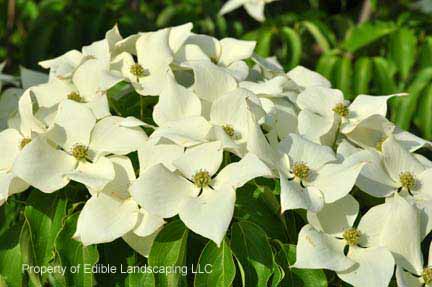 This species from China and Japan is much like our native dogwood, but the floral bracts are pointed and produce several weeks later in the season. Tree develops interesting bark as it grows and the showy fruits are edible. Leaves have good fall color. Kousa has few pest problems. It is highly resistant to dogwood borer and dogwood anthracnose that has been plaguing flowering dogwoods in recent years. Zones 6-8.
This species from China and Japan is much like our native dogwood, but the floral bracts are pointed and produce several weeks later in the season. Tree develops interesting bark as it grows and the showy fruits are edible. Leaves have good fall color. Kousa has few pest problems. It is highly resistant to dogwood borer and dogwood anthracnose that has been plaguing flowering dogwoods in recent years. Zones 6-8.
View detailed information
|
| Lang Jujube - Zizyphus jujuba |
|---|
 Lang has a large bell shaped fruit, ripening one month later than Li. Fruits are good fresh right from the tree. Tree is pretty with olive shaped glistening leaves. Flowers are small, yellow and scented. They can sweeten the air around the tree especially at twilight. The smell is reminiscent of grape soda. Blooming in June here, the flowers are never damaged by late spring frosts. Jujube is native to China and adapts very well in the US. Space 15'. Height averages 15 to 20' Zones 6-9.
Lang has a large bell shaped fruit, ripening one month later than Li. Fruits are good fresh right from the tree. Tree is pretty with olive shaped glistening leaves. Flowers are small, yellow and scented. They can sweeten the air around the tree especially at twilight. The smell is reminiscent of grape soda. Blooming in June here, the flowers are never damaged by late spring frosts. Jujube is native to China and adapts very well in the US. Space 15'. Height averages 15 to 20' Zones 6-9.
View detailed information Please contact our office to see about availability. 434.361.9134
|
| Contorted Jujube 'So' - Zizyphus jujuba |
 This jujube is a small tree with angled zig zagged branches. The fruits are round, sweet and crisp, holding their ripe fruit longer on the tree than most varieties. Fruits ripen first in our collection. An excellent specimen tree.There is a lot of value for the homeowner from this tree because it's easy to grow, the fruits are good fresh and it does not take up a lot of space. A fine choice for public places too! Brought from China in 1914 by the famous plant explorer Frank Meyer. Space 10'. Zones 6-9.
This jujube is a small tree with angled zig zagged branches. The fruits are round, sweet and crisp, holding their ripe fruit longer on the tree than most varieties. Fruits ripen first in our collection. An excellent specimen tree.There is a lot of value for the homeowner from this tree because it's easy to grow, the fruits are good fresh and it does not take up a lot of space. A fine choice for public places too! Brought from China in 1914 by the famous plant explorer Frank Meyer. Space 10'. Zones 6-9.
View detailed information Sorry, we are currently out of this item, please check back!
|
| G-A 866 - Zizipus jujuba |
 GA 866 has shiny reddish-brown, date like fruit with a sweet apple flavor. Fruit is noteworthy for its remarkably high sugar content. When candied and dried they resemble dates. Also, can be made into a delicious ice cream. The fruit is one and a half to two inches long, elongated and plump. Ripens close to Lang.Needs hot summer for fruit to ripen, especially good in desert areas.Attractive shiny leaves and rugged with picturesque bark. An outstanding selection from Chico, CA research program. Ripens mid to late September.Mature height is 15-20 feet with a spread of 15-20 feet. Cold hardy to Zone 5. Zone 5-9.
GA 866 has shiny reddish-brown, date like fruit with a sweet apple flavor. Fruit is noteworthy for its remarkably high sugar content. When candied and dried they resemble dates. Also, can be made into a delicious ice cream. The fruit is one and a half to two inches long, elongated and plump. Ripens close to Lang.Needs hot summer for fruit to ripen, especially good in desert areas.Attractive shiny leaves and rugged with picturesque bark. An outstanding selection from Chico, CA research program. Ripens mid to late September.Mature height is 15-20 feet with a spread of 15-20 feet. Cold hardy to Zone 5. Zone 5-9.
View detailed information
|
| Honey Jar Jujube - Zizyphus jujuba |
|
Honey Jar has a small, sweet but spicy fruit with a thin skin. Fruits are excellent fresh right from the tree. It is the earliest ripening of the Jujubes. Well adapted to hot or tropical climates, but also very cold hardy. Zones 5-10.
View detailed information Please contact our office to see about availability. 434.361.9134
|
| Breda Giant Medlar - Mespilus germanica |
|---|
 Breda Giant's fruits resemble very, very large bronze rose hips. A relative of the pear, medlars are sometimes referred to as northern loquat because of their long green leaves with a leathery appearance. Breda Giant is self fertile, late blooming with showy white flowers and the tree is long lived and dwarf. Fruits are harvested firm, when leaves start falling in late fall. In warmer areas they can blet and ripen on the tree. Fruits can be stored to blet in clean shavings, boxed in a cool basement or porch. The flesh turns soft and has an applesauce cinnamon like flavor. Also called nespola in Italy. Fruits are bug free but can get quince or cedar apple rust. Space 8' circle. Height averages 8' tall and 5' wide. Zone 5-9
Breda Giant's fruits resemble very, very large bronze rose hips. A relative of the pear, medlars are sometimes referred to as northern loquat because of their long green leaves with a leathery appearance. Breda Giant is self fertile, late blooming with showy white flowers and the tree is long lived and dwarf. Fruits are harvested firm, when leaves start falling in late fall. In warmer areas they can blet and ripen on the tree. Fruits can be stored to blet in clean shavings, boxed in a cool basement or porch. The flesh turns soft and has an applesauce cinnamon like flavor. Also called nespola in Italy. Fruits are bug free but can get quince or cedar apple rust. Space 8' circle. Height averages 8' tall and 5' wide. Zone 5-9
View detailed information Please contact our office to see about availability. 434.361.9134
|
| Shangri La Mulberry - Morus alba |
|---|
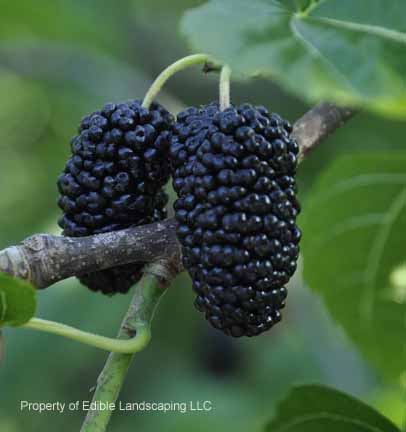 Large, black fruit with huge heart-shaped leaves. From Naples, FL, yet hardy here in VA too! Fruits earlier than all other varieties. Small tree up to 20'. Delicious plump berries above average size. Space 15' circle. Zones 7-9. " Shangri La is a wonderful tree, I have to buy more for friends.......
Large, black fruit with huge heart-shaped leaves. From Naples, FL, yet hardy here in VA too! Fruits earlier than all other varieties. Small tree up to 20'. Delicious plump berries above average size. Space 15' circle. Zones 7-9. " Shangri La is a wonderful tree, I have to buy more for friends....... C M Washington DC. View detailed information
|
| Dwarf Weeping Mulberry - Morus alba |
 Our weeping mulberry is a black fruiting weeper. Mature tree size 12' tall and wide. Get one for the kids, they make great playhouses! Or, how about a summer outdoor shower stall? Fruits are not as large as our other black mulberries, but are very good. Stake young plants for the first few years. Space 10'-12' circle. Zones 3-9.
Our weeping mulberry is a black fruiting weeper. Mature tree size 12' tall and wide. Get one for the kids, they make great playhouses! Or, how about a summer outdoor shower stall? Fruits are not as large as our other black mulberries, but are very good. Stake young plants for the first few years. Space 10'-12' circle. Zones 3-9.
View detailed information Please contact our office to see about availability. 434.361.9134
|
| Beautiful Day Mulberry - Morus alba |
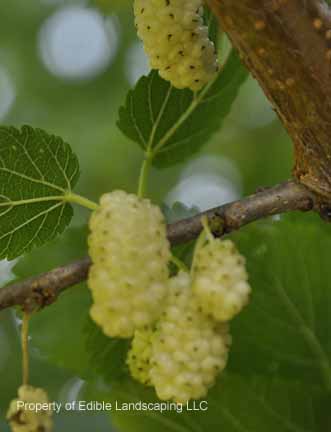 Beautiful Day mulberry is a very sweet pure white fruit. Great for drying and eating fresh. Original tree growing in College Park MD. Naturalized but not native to the US. White mulberry does not produce pollen. Mature height 25' - 30'. Space 25' circle. Zone 6-8
Beautiful Day mulberry is a very sweet pure white fruit. Great for drying and eating fresh. Original tree growing in College Park MD. Naturalized but not native to the US. White mulberry does not produce pollen. Mature height 25' - 30'. Space 25' circle. Zone 6-8
View detailed information Sorry, we are currently out of this item, please check back!
|
| Pakistan Mulberry - Morus Macrura |
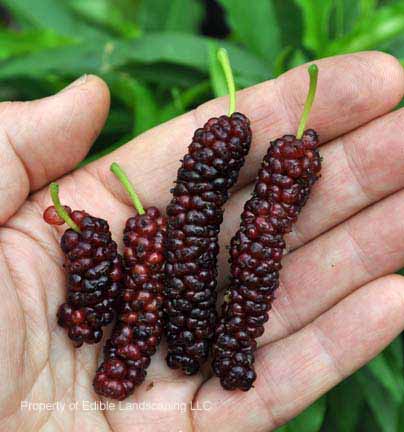 Pakistan's long red to black fruits of very large size and are the largest Mulberry fruits we've seen. Up to 5" long, usually around 3", the fruits picked in the ruby red stage are sweet and can be sold to local Markets. Pakistan is not adaptable to all regions of zones 7-9. They evolved in an area of mild winters. Our winters can have fluctuating swings in temperatures causing Pakistan's buds to swell, making them susceptible to die back. The tree can lose branches and suffer winter injury. There are places in the US where the plant grows well and the tree is vigorous and productive. Coastal areas of Zone 8, California, and Oregon are choice places for Pakistan. Because of their nature we do not guarantee them against winter kill. Pakistan is upright tree shaped and can be pruned after fruiting to maintain a manageable size. Zone 7-10 Space 15-20' circle
Pakistan's long red to black fruits of very large size and are the largest Mulberry fruits we've seen. Up to 5" long, usually around 3", the fruits picked in the ruby red stage are sweet and can be sold to local Markets. Pakistan is not adaptable to all regions of zones 7-9. They evolved in an area of mild winters. Our winters can have fluctuating swings in temperatures causing Pakistan's buds to swell, making them susceptible to die back. The tree can lose branches and suffer winter injury. There are places in the US where the plant grows well and the tree is vigorous and productive. Coastal areas of Zone 8, California, and Oregon are choice places for Pakistan. Because of their nature we do not guarantee them against winter kill. Pakistan is upright tree shaped and can be pruned after fruiting to maintain a manageable size. Zone 7-10 Space 15-20' circle
View detailed information
|
| Arbequina Olive - Olive europa |
|---|
 Arbequina olive is a self pollinating, compact variety, ripening black. It is an early ripening Spanish variety. Makes quality olives and oil.Will fruit in a pot and is very decorative. Zone 8-10. Olives do not perform consistently in the southern US, probably due to the high humidity, however, reports from Savannah, GA and Charleston, SC and other areas of zone 8 for Arbequina are positive.
Arbequina olive is a self pollinating, compact variety, ripening black. It is an early ripening Spanish variety. Makes quality olives and oil.Will fruit in a pot and is very decorative. Zone 8-10. Olives do not perform consistently in the southern US, probably due to the high humidity, however, reports from Savannah, GA and Charleston, SC and other areas of zone 8 for Arbequina are positive.
View detailed information Please contact our office to see about availability. 434.361.9134
|
| Select Pawpaw - Asimina triloba |
|---|
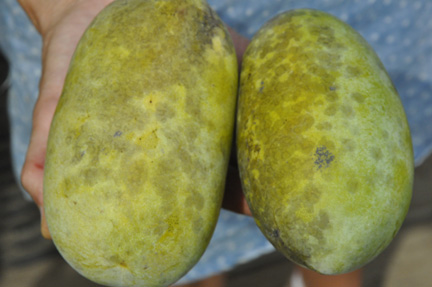 Seedlings come close to being true to type to named varieties. Select Pawpaw seedlings should have large fruit size and fine flavor, carrying on the fine genetic pool from the superior varieties the seeds were obtained from. Native. Zones 5-8. Two select pawpaw will cross pollinate. Plant 6' apart for hedge like appearance or 10'-14' circle to stand alone.
Seedlings come close to being true to type to named varieties. Select Pawpaw seedlings should have large fruit size and fine flavor, carrying on the fine genetic pool from the superior varieties the seeds were obtained from. Native. Zones 5-8. Two select pawpaw will cross pollinate. Plant 6' apart for hedge like appearance or 10'-14' circle to stand alone.
View detailed information
|
| Mango Pawpaw - Asimina triloba |
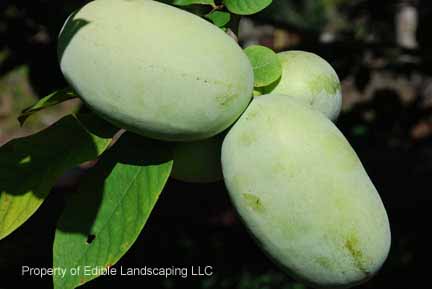 Mango Pawpaw was obtained from a collector in Tifton, Georgia. Mango pawpaw are large, native, early ripening and very delicious fruit with yellow flesh reminiscent of a mango. The texture being very smooth. Space as close as 6' or 14' circles for each tree. Pollination works best when trees are close to one another. For pollination choose a different variety of pawpaw if you order a grafted plant. Select pawpaw or native pawpaw are seedlings. Seedlings will cross pollinate each other. For instance, two seedling Mango pawpaw will pollinate each other, but two grafted Mango pawpaw will not. Zones 5 -8
Mango Pawpaw was obtained from a collector in Tifton, Georgia. Mango pawpaw are large, native, early ripening and very delicious fruit with yellow flesh reminiscent of a mango. The texture being very smooth. Space as close as 6' or 14' circles for each tree. Pollination works best when trees are close to one another. For pollination choose a different variety of pawpaw if you order a grafted plant. Select pawpaw or native pawpaw are seedlings. Seedlings will cross pollinate each other. For instance, two seedling Mango pawpaw will pollinate each other, but two grafted Mango pawpaw will not. Zones 5 -8
View detailed information Please contact our office to see about availability. 434.361.9134
|
| Shenandoah (tm) Pawpaw - Asimina triloba |
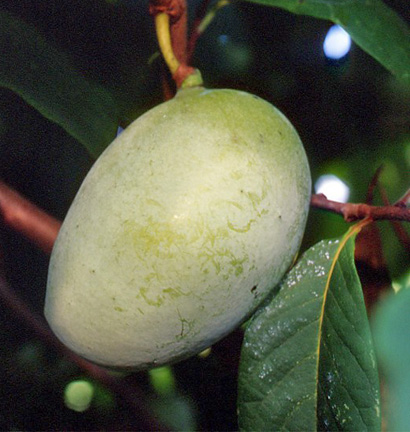 According to Neil Peterson the Shenandoah ™ has been the clear favorite of pawpaw customers at the DuPont Circle farmers market in Washington, DC. Even doubters and scoffers have been converted to pawpaw lovers by this variety! It is a real taste treat -- smooth, custard texture, with just the right balance of fragrance, sweet fruity flavor and agreeable aftertaste. This tree originated as a seedling of Overleese and it is superior to its parent. Large fruit with few seeds (6% by weight). Texture is firmer than wild pawpaws. Fruit is often borne in single-fruited clusters. Good yields. Shenandoah responds well to pruning. Fruits ripens early to mid season to late. Zones 5-8 Space 12' circle A Peterson Pawpaw.
According to Neil Peterson the Shenandoah ™ has been the clear favorite of pawpaw customers at the DuPont Circle farmers market in Washington, DC. Even doubters and scoffers have been converted to pawpaw lovers by this variety! It is a real taste treat -- smooth, custard texture, with just the right balance of fragrance, sweet fruity flavor and agreeable aftertaste. This tree originated as a seedling of Overleese and it is superior to its parent. Large fruit with few seeds (6% by weight). Texture is firmer than wild pawpaws. Fruit is often borne in single-fruited clusters. Good yields. Shenandoah responds well to pruning. Fruits ripens early to mid season to late. Zones 5-8 Space 12' circle A Peterson Pawpaw.View detailed information
|
| Susquehanna (R) Pawpaw - Asimina triloba |
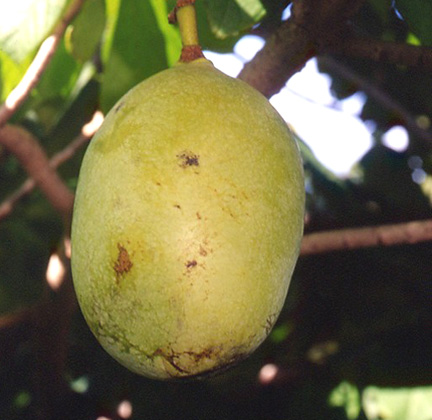 Susquehanna ® is the largest and latest ripening of Neal Peterson's fabulous introductions. Neal's life's work has improved the pawpaw to a new level. Fruits are large, sometimes over a pound. Flesh is plentiful, seeds are few. They are richly flavored and delicious. Plant Patient #15900 was awarded this fine variety. Space 14' circle Zone 5-8
Susquehanna ® is the largest and latest ripening of Neal Peterson's fabulous introductions. Neal's life's work has improved the pawpaw to a new level. Fruits are large, sometimes over a pound. Flesh is plentiful, seeds are few. They are richly flavored and delicious. Plant Patient #15900 was awarded this fine variety. Space 14' circle Zone 5-8 Neal Peterson says,"Susquehanna is without a doubt my personal favorite, if I had to choose one." Outstanding for combining very large size with rich pawpaw flavor, great sweetness, exceptional fleshiness, and firm buttery texture, this particular variety makes an especially beautiful ornamental tree in the home landscape. This tree originated as a seedling from the collection of the Blandy Experimental Farm. It has large fruit, sometimes weighing over a pound. With a firm texture similar to avocado and a thickish skin, Susquehanna is less fragile than most. It has the fewest seeds of any variety (3% by weight). Moderate to good yields. Responds well to pruning. Key Features of the Susquehanna pawpaw: Very fleshy - only 3% seed Very sweet, rich flavor Firm, buttery texture Fruit size very large Moderate yields Responds well to pruning Trademarked by Peterson Pawpaws. View detailed information Sorry, we are currently out of this item, please check back!
|
| Sunflower Pawpaw - Asimina triloba |
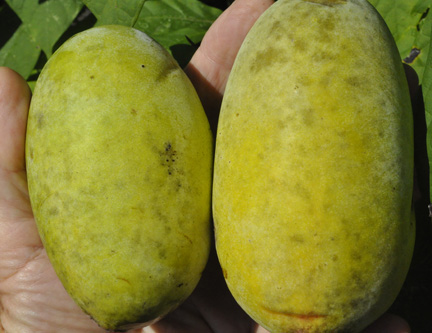 Sunflower was found in the wild in Kansas by Milo Gibson in 1970. Sunflower is one of the largest fruited and most productive varieties there are and it is the latest ripening variety. Sunflower still fruits when all others are gone for the season so it is particularly nice for extending the season. Zones 5-8 Space 12' circle
Sunflower was found in the wild in Kansas by Milo Gibson in 1970. Sunflower is one of the largest fruited and most productive varieties there are and it is the latest ripening variety. Sunflower still fruits when all others are gone for the season so it is particularly nice for extending the season. Zones 5-8 Space 12' circle
View detailed information Sorry, we are currently out of this item, please check back!
|
| Rappahannock (R) Pawpaw - Asimina triloba |
 Rappahannock ® is a superior tree for picking fruit from. The fruit is easier to spot among the foliage, because of the horizontal habit of the leaves, and because its fruits typically color up nicely when ripe. These are large, beautiful, well-shaped and symmetrical fruits, whether borne singly or in clusters. The flavor is superior as well, very sweet and refreshing. This tree originated as a seedling from a tree in the Blandy Experimental Farm collection. Rappahannock has large fruit with a firm flesh and few seeds (6% by weight). Very vigorous with good yields. Ripens early.
Rappahannock ® is a superior tree for picking fruit from. The fruit is easier to spot among the foliage, because of the horizontal habit of the leaves, and because its fruits typically color up nicely when ripe. These are large, beautiful, well-shaped and symmetrical fruits, whether borne singly or in clusters. The flavor is superior as well, very sweet and refreshing. This tree originated as a seedling from a tree in the Blandy Experimental Farm collection. Rappahannock has large fruit with a firm flesh and few seeds (6% by weight). Very vigorous with good yields. Ripens early.Key Features of the Rappahannock pawpaw: Firm flesh Good yields Fleshy - only 3% seed Sweet refreshing flavor More regular & uniform shape Earlier harvest (some color break plus horizontally held leaves) Trademarked by Peterson Pawpaws. View detailed information Please contact our office to see about availability. 434.361.9134
|
| Allegheny (R) Pawpaw - Asimina triloba |
 Allegheny ® pawpaw has medium fleshiness, early ripening with an 8 Percent seed ratio by weight. Flavor sweet, rich, a hint of citrus. Texture medium firm, smooth. Flesh color yellow. Fruit size typically less than 8 oz. Very productive to the point that fruit size suffers. Trees will require fruit thinning to keep fruit size over 8 oz.(Growers are thinning fruits 2 per hand on all varieties for maximum size.) This has been a continual favorite of those who taste it. Customer pressure has persuaded Neal Peterson to introduce this one, even though it is smaller and seedier than he normally accepts. Ripens early. Zone 5-8 Space 12' circle
Allegheny ® pawpaw has medium fleshiness, early ripening with an 8 Percent seed ratio by weight. Flavor sweet, rich, a hint of citrus. Texture medium firm, smooth. Flesh color yellow. Fruit size typically less than 8 oz. Very productive to the point that fruit size suffers. Trees will require fruit thinning to keep fruit size over 8 oz.(Growers are thinning fruits 2 per hand on all varieties for maximum size.) This has been a continual favorite of those who taste it. Customer pressure has persuaded Neal Peterson to introduce this one, even though it is smaller and seedier than he normally accepts. Ripens early. Zone 5-8 Space 12' circleAllegheny Pawpaw is trademarked by Peterson Pawpaws. View detailed information Please contact our office to see about availability. 434.361.9134
|
| Wabash (R) Pawpaw - Asimina triloba |
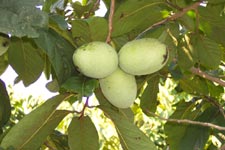 Wabash ® is very fleshy. Percent seed ~ 6% by weight. Flavor sweet and rich. Texture medium firm, creamy, smooth. Flesh color yellow to orangish. Fruit size typically 8-12 oz. Good productivity. The overall fruit quality and quantity on this variety is excellent. A favorite of those who have tasted it at the KSU orchard. Dr. Pomper of KSU also insisted I release this one. Ripens mid season to late. Zone 5-8 Space 12' circle
Wabash ® is very fleshy. Percent seed ~ 6% by weight. Flavor sweet and rich. Texture medium firm, creamy, smooth. Flesh color yellow to orangish. Fruit size typically 8-12 oz. Good productivity. The overall fruit quality and quantity on this variety is excellent. A favorite of those who have tasted it at the KSU orchard. Dr. Pomper of KSU also insisted I release this one. Ripens mid season to late. Zone 5-8 Space 12' circleTrademarked by Peterson Pawpaws. View detailed information
|
| Potomac (R) Pawpaw - Asimoni triloba |
 A key Feature of the Potomac ® pawpaw is it is extremely fleshy.The seed Percentage by weight is 4 percent. The flavor is sweet and rich and the texture is firm, melting, and smooth. Flesh color is medium yellow and fruit size is large, typically 12+ oz. The tree is moderately productive with a strong apical dominance and is less spreading than most. The overall fruit quality on this variety is impressive. Trademarked by Peterson Pawpaws. Ripens late. Space 10' circle Zone 5-8
A key Feature of the Potomac ® pawpaw is it is extremely fleshy.The seed Percentage by weight is 4 percent. The flavor is sweet and rich and the texture is firm, melting, and smooth. Flesh color is medium yellow and fruit size is large, typically 12+ oz. The tree is moderately productive with a strong apical dominance and is less spreading than most. The overall fruit quality on this variety is impressive. Trademarked by Peterson Pawpaws. Ripens late. Space 10' circle Zone 5-8
View detailed information Sorry, we are currently out of this item, please check back!
|
| NC-1 Pawpaw - Asimoni triloba |
 NC-1 was introduced by Doug Campbell, a nurseryman and fruit enthusiast from Niagra on the Lake, Ontario, Canada in 1976.Proven winter hardy and productive in that area. One of the earliest to ripen its fruit with few seeds and large fruit and thin skin. NC-1 pawpaw is the most ornamental of the named varieties, with dense, large foliage in a pyramidal form. Ripens September 15th in Ontario and early September in Kentucky. Space 10' circles Zone 5-8
NC-1 was introduced by Doug Campbell, a nurseryman and fruit enthusiast from Niagra on the Lake, Ontario, Canada in 1976.Proven winter hardy and productive in that area. One of the earliest to ripen its fruit with few seeds and large fruit and thin skin. NC-1 pawpaw is the most ornamental of the named varieties, with dense, large foliage in a pyramidal form. Ripens September 15th in Ontario and early September in Kentucky. Space 10' circles Zone 5-8
View detailed information
|
| KSU Atwood Pawpaw - Asimina triloba |
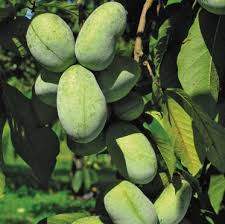 In 2009 KSU Atwood became the first cultivar to be released from Kentucky State University's breeding program. It is large, round and mango flavored. Described as excellent tasting, with very little leaf spot. Fruit has greenish blue skin, yellow to orange flesh with few seeds. Medium size fruit.
In 2009 KSU Atwood became the first cultivar to be released from Kentucky State University's breeding program. It is large, round and mango flavored. Described as excellent tasting, with very little leaf spot. Fruit has greenish blue skin, yellow to orange flesh with few seeds. Medium size fruit.
View detailed information
|
| Overleese Pawpaw - Asimina triloba |
 Overleese was selected in the wild by W. B. Ward in Rushville, Indiana, in 1950 and is a perennial favorite among back yard growers. Oval to round and few seeds with excellent flavor. Overleese is a parent of many other improved cultivars including Peterson's Shenandoah. Exceptional quality, medium to large fruit and early ripening. Medium productivity and a very good seed to flesh ratio. Fruit keeps well. Ripens early September in Kentucky and 1st week of October in Michigan. Fruit size large; averaging over 170 g/fruit and 55 fruit per tree at KSU. Large size fruit averaging over 170g/fruit and about 55 fruit per tree. Overleese won "Best Fruit" at the Ohio Pawpaw Festival in 2011.
Overleese was selected in the wild by W. B. Ward in Rushville, Indiana, in 1950 and is a perennial favorite among back yard growers. Oval to round and few seeds with excellent flavor. Overleese is a parent of many other improved cultivars including Peterson's Shenandoah. Exceptional quality, medium to large fruit and early ripening. Medium productivity and a very good seed to flesh ratio. Fruit keeps well. Ripens early September in Kentucky and 1st week of October in Michigan. Fruit size large; averaging over 170 g/fruit and 55 fruit per tree at KSU. Large size fruit averaging over 170g/fruit and about 55 fruit per tree. Overleese won "Best Fruit" at the Ohio Pawpaw Festival in 2011.
View detailed information
|
| Tallahatchie (R) Pawpaw - Asimina Triloba |
 Tallahatchie ® has a pleasant aroma and sweet mellow flavor with floral notes and a very smooth texture. Ripens mid-season to late. In Maryland mid-to late September. Fruit averages 240 gm, (9 oz). What makes Tallahatchie distinctive is its exquisite flavor. It has very few seeds,the ratio is less than Shenandoah. Tallahatchie tends to bear large clusters,impressive to see,though it may require thinning. You must include this variety when making pawpaw ice cream! Trademarked by Peterson Pawpaws. Zone 5-8
Tallahatchie ® has a pleasant aroma and sweet mellow flavor with floral notes and a very smooth texture. Ripens mid-season to late. In Maryland mid-to late September. Fruit averages 240 gm, (9 oz). What makes Tallahatchie distinctive is its exquisite flavor. It has very few seeds,the ratio is less than Shenandoah. Tallahatchie tends to bear large clusters,impressive to see,though it may require thinning. You must include this variety when making pawpaw ice cream! Trademarked by Peterson Pawpaws. Zone 5-8
View detailed information Sorry, we are currently out of this item, please check back!
|
Due to import restrictions we are unable to ship Peaches to CA, WA, Europe...
| Flory Patio Peach - Prunus persica |
|---|
 Flory is a genetic dwarf green-leafed peach, Flory is a self-fertile white peach with showy double pink flowers. Very disease-resistant and dependable. The freestone fruit ripens late, 1st week in September. Seeds from fruits are true to type. Good fresh. Up to 5' tall Space 8' circle Zones 5-8.
Flory is a genetic dwarf green-leafed peach, Flory is a self-fertile white peach with showy double pink flowers. Very disease-resistant and dependable. The freestone fruit ripens late, 1st week in September. Seeds from fruits are true to type. Good fresh. Up to 5' tall Space 8' circle Zones 5-8.
View detailed information Sorry, we are currently out of this item, please check back!
|
| Bonfire Patio Peach - Prunus persica |
 Bonfire is a compact dwarf purple-leaf peach. White-fleshed fruit streaked with red ripens late. (@ 1st week September at the nursery) Fruits are cling stone with firm fruit used for canning, pickling, and pies. Can be eaten fresh but rubbery. Fruit turns red when cooked and makes an attractive pie. A stunning landscape specimen with showy, pink double flowers. Can be grown in a patio pot. Self fertile. Space 6' circle Zones 5-9. (PP #8509)
Bonfire is a compact dwarf purple-leaf peach. White-fleshed fruit streaked with red ripens late. (@ 1st week September at the nursery) Fruits are cling stone with firm fruit used for canning, pickling, and pies. Can be eaten fresh but rubbery. Fruit turns red when cooked and makes an attractive pie. A stunning landscape specimen with showy, pink double flowers. Can be grown in a patio pot. Self fertile. Space 6' circle Zones 5-9. (PP #8509)
View detailed information Please contact our office to see about availability. 434.361.9134
|
| Red Haven Peach - Prunus persica |
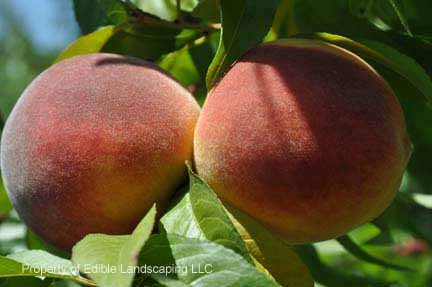 Excellent in all peach respects, Red Haven is a standard for an early orange flesh peach. Blooms are least susceptible to late frost injury. Fruits resists brown rot and bacterial spot. Still needs attention to pruning, insect and disease control. Self fertile Space 10' to 14' circle. Zones 4-9.
Excellent in all peach respects, Red Haven is a standard for an early orange flesh peach. Blooms are least susceptible to late frost injury. Fruits resists brown rot and bacterial spot. Still needs attention to pruning, insect and disease control. Self fertile Space 10' to 14' circle. Zones 4-9.
View detailed information
|
| Erli Red Free Peach - Prunus persica |
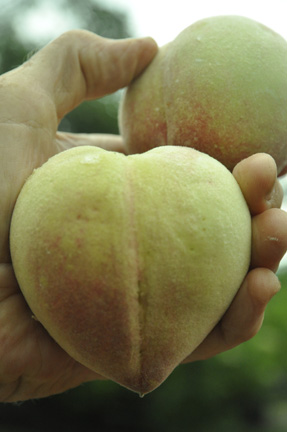 Very early, disease-resistant white peach. Two weeks earlier than Red Haven. Late frost tolerance and brown rot resistant.Very good flavor. Self fertile. Space 12' to 14' circle Zones 5-8.
Very early, disease-resistant white peach. Two weeks earlier than Red Haven. Late frost tolerance and brown rot resistant.Very good flavor. Self fertile. Space 12' to 14' circle Zones 5-8.
View detailed information Please contact our office to see about availability. 434.361.9134
|
| Belle of Georgia - Prunus persica |
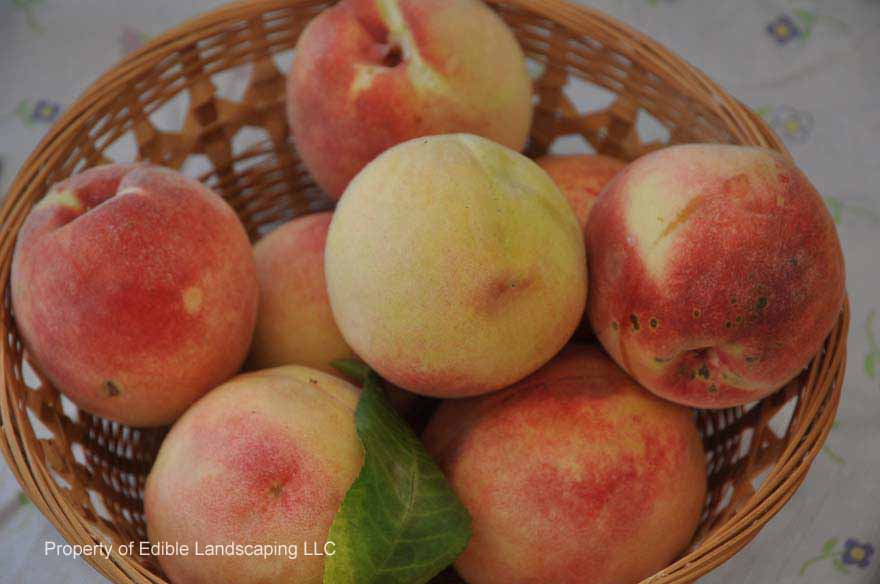 Belle of Georgia peach has been grown for centuries from the north to the south. Very disease resistant and long-lived. Very bud hardy. White-fleshed fruit drops when ripe. Ripens 4 weeks after Red Haven. Usually needs a short course for care, as all peaches do. 800 chill hours. Self fertile. Space 14' circle. Zones 5-8.
Belle of Georgia peach has been grown for centuries from the north to the south. Very disease resistant and long-lived. Very bud hardy. White-fleshed fruit drops when ripe. Ripens 4 weeks after Red Haven. Usually needs a short course for care, as all peaches do. 800 chill hours. Self fertile. Space 14' circle. Zones 5-8.
View detailed information
|
| Indian Blood Cling Peach - Prunus persica |
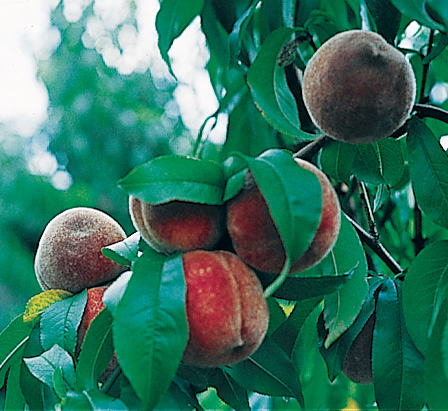 Pretty pink flowering disease resistant peach. Resists brown rot as much as patio peach and resists bug damage more than most varieties. The fruit can be very large and was stored and canned in the colonial times. Red striped though out the fruit with red around the seed. Firm flesh and pleasantly tart flavored. 800 chill hours needed. Self fertile Space 12'-14' circle. Zone 6-9.
Pretty pink flowering disease resistant peach. Resists brown rot as much as patio peach and resists bug damage more than most varieties. The fruit can be very large and was stored and canned in the colonial times. Red striped though out the fruit with red around the seed. Firm flesh and pleasantly tart flavored. 800 chill hours needed. Self fertile Space 12'-14' circle. Zone 6-9.
View detailed information Please contact our office to see about availability. 434.361.9134
|
| Indian Blood Free Peach - Prunus persica |
 The all-time highest rated peach at Dave Wilson Nursery fruit tastings. Large freestone, firm crimson and cream colored flesh. Tart until fully ripe, then highly aromatic with a rich, distinctive flavor. Highly resistant to peach leaf curl. Another peach needed to pollenize. Chill requirement 700 hours below 45 degrees F. Ripens late, end of August to early September. Zones 5-9 Space 14' circle
The all-time highest rated peach at Dave Wilson Nursery fruit tastings. Large freestone, firm crimson and cream colored flesh. Tart until fully ripe, then highly aromatic with a rich, distinctive flavor. Highly resistant to peach leaf curl. Another peach needed to pollenize. Chill requirement 700 hours below 45 degrees F. Ripens late, end of August to early September. Zones 5-9 Space 14' circle
View detailed information Please contact our office to see about availability. 434.361.9134
|
Due to import restrictions we are unable to ship Pears, Asian to CA, Europe...
| Korean Giant Asian Pear - Pyrus pyrifolia |
|---|
 Korean Giant pear is also known as Olympic. A very large and late ripening, dark brown russet fruit of very good quality. Sweet, firm and juicy, it has an excellent storage and shelf life, keeping in a refrigerator all winter. Ripens in September. This productive tree is very disease resistant. Needs a pollinator, Shinko is a good choice. Mature height 12'-15'. Zones 4-9.
Korean Giant pear is also known as Olympic. A very large and late ripening, dark brown russet fruit of very good quality. Sweet, firm and juicy, it has an excellent storage and shelf life, keeping in a refrigerator all winter. Ripens in September. This productive tree is very disease resistant. Needs a pollinator, Shinko is a good choice. Mature height 12'-15'. Zones 4-9.
View detailed information
|
| Daisui Li Asian Pear - Pyrus pyrifolia |
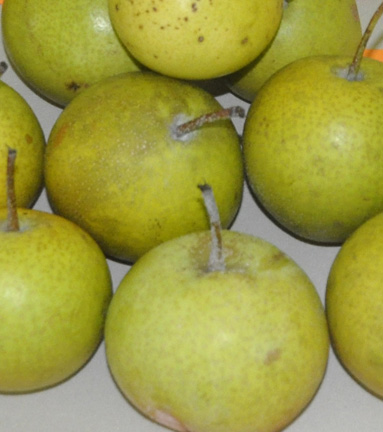 Daisui Li is a high yielding Asian pear bearing very large(up to a pound) to medium size fruit ripening after Bartlett and Shinko.Flesh is white, crispy, and juicy. Can be stored for 6 months at 32 degrees F. Makes an excellent dried pear. Introduced by Ben T. Iwakin of the University of California in 1985. Spreading in shape with ornamental value. Fire blight resistant. A cross between Japanese pear Kikusui and Chinese pear Tse Li. Space 10' circle on semi dwarfing rootstock and 15' circle on standard rootstock. Zones 4-8
Daisui Li is a high yielding Asian pear bearing very large(up to a pound) to medium size fruit ripening after Bartlett and Shinko.Flesh is white, crispy, and juicy. Can be stored for 6 months at 32 degrees F. Makes an excellent dried pear. Introduced by Ben T. Iwakin of the University of California in 1985. Spreading in shape with ornamental value. Fire blight resistant. A cross between Japanese pear Kikusui and Chinese pear Tse Li. Space 10' circle on semi dwarfing rootstock and 15' circle on standard rootstock. Zones 4-8
View detailed information
|
| Shin Li Asian Pear - Pyrus pyrifolia |
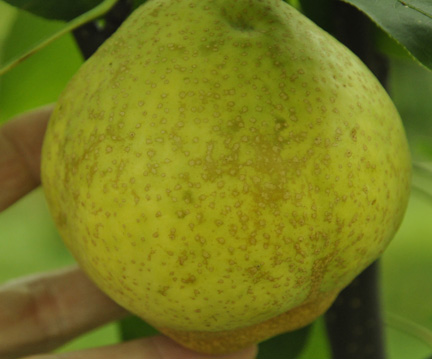 Shin Li is a very large to large fruit with a full-bodied pear shape (pyriform). Firm, white crisp juicy flesh and a sweet, yet tart flavor. The skin is light to yellowish-green. Tree is upright, with slightly spreading growth and resistant to fire blight. Storage life can be 5 to 6 months. Developed at UC Davis and is a cross between a Chinese pear variety and a Japanese pear variety. We have a favorable report on this variety from A J Bullard of Mount Olive NC. Korean Giant and Shin LI are his best fire blight resistant pears. Space 10' circle for semi dwarf and 15' for standard tree size. Zones 4-8
Shin Li is a very large to large fruit with a full-bodied pear shape (pyriform). Firm, white crisp juicy flesh and a sweet, yet tart flavor. The skin is light to yellowish-green. Tree is upright, with slightly spreading growth and resistant to fire blight. Storage life can be 5 to 6 months. Developed at UC Davis and is a cross between a Chinese pear variety and a Japanese pear variety. We have a favorable report on this variety from A J Bullard of Mount Olive NC. Korean Giant and Shin LI are his best fire blight resistant pears. Space 10' circle for semi dwarf and 15' for standard tree size. Zones 4-8
View detailed information
|
Due to import restrictions we are unable to ship Pears, European to CA, Europe...
| Magness Pear - Pyrus communis X |
|---|
 Easy to care for and disease-resistant. Bears sweet perfumed fruit picked around August 26th in VA. Its buttery melting flavor rivals any pear. Has a similar flavor to Comice. Comice is very susceptible to fire blight. I love those Comices to pieces but would not grow one, as it would surely die from fire blight in our area of Virginia. Magness grows well in areas such as MS and LA and is hardy in MI.It is Very fire blight resistant. Space dwarf 8'- 10'circle or standard 15-20'circle. Can be pollinated by European or the Asian varieties, but will NOT pollinate others. Zones 5-9.
Easy to care for and disease-resistant. Bears sweet perfumed fruit picked around August 26th in VA. Its buttery melting flavor rivals any pear. Has a similar flavor to Comice. Comice is very susceptible to fire blight. I love those Comices to pieces but would not grow one, as it would surely die from fire blight in our area of Virginia. Magness grows well in areas such as MS and LA and is hardy in MI.It is Very fire blight resistant. Space dwarf 8'- 10'circle or standard 15-20'circle. Can be pollinated by European or the Asian varieties, but will NOT pollinate others. Zones 5-9.
View detailed information Please contact our office to see about availability. 434.361.9134
|
| Potomac Pear - Pyrus communis |
 Introduced in 1993 from the Kearneysville, WV USDA station, this high quality pear ripens in mid-September. Fruit is sweet and buttery and extremely juicy. Tree is vigorous and fairly precocious. Pollinates with other European pears and is fire blight resistant. A Moonglow-Anjou cross, it is one of the highest quality fireblight resistant varieties available. Dwarf trees are 8'-14'tall and standards are 15'-30'tall. Space 6' to 10' circles for dwarf and 14' circles for standards. Zone 5-9.
Introduced in 1993 from the Kearneysville, WV USDA station, this high quality pear ripens in mid-September. Fruit is sweet and buttery and extremely juicy. Tree is vigorous and fairly precocious. Pollinates with other European pears and is fire blight resistant. A Moonglow-Anjou cross, it is one of the highest quality fireblight resistant varieties available. Dwarf trees are 8'-14'tall and standards are 15'-30'tall. Space 6' to 10' circles for dwarf and 14' circles for standards. Zone 5-9.
View detailed information
|
| Blakes Pride European Pear - Pyrus communis |
 A mid-season European pear with an attractive yellow color and excellent aromatic flavor. Blake's Pride has a high degree of resistance to fire blight. Grow this variety instead of Barlett for that reason. Ripening season is the same time as Bartlett and picked a few weeks earlier than Magness or Potomac, usually August 12th at our nursery. Pollinates with other European types. Dwarf trees space 8' to 10' circle. Space dwarf on OHxF 333 10' to 12' and standard size 15'. Zone 5 - 8
A mid-season European pear with an attractive yellow color and excellent aromatic flavor. Blake's Pride has a high degree of resistance to fire blight. Grow this variety instead of Barlett for that reason. Ripening season is the same time as Bartlett and picked a few weeks earlier than Magness or Potomac, usually August 12th at our nursery. Pollinates with other European types. Dwarf trees space 8' to 10' circle. Space dwarf on OHxF 333 10' to 12' and standard size 15'. Zone 5 - 8
View detailed information
|
| Shenandoah Pear - Pyrus communis L. |
 Shenandoah is a new, large and luscious European type pear, more blight resistance than Bartlett. Flavor similar to Bartlett with a spicy aromatic sweetness. Tree is a consistent bearer and fruits are larger than Bartlett and can store for up to five months. Ripens late about 6 weeks after Bartlett, @ September 25th at the nursery. Zones 5-7
Shenandoah is a new, large and luscious European type pear, more blight resistance than Bartlett. Flavor similar to Bartlett with a spicy aromatic sweetness. Tree is a consistent bearer and fruits are larger than Bartlett and can store for up to five months. Ripens late about 6 weeks after Bartlett, @ September 25th at the nursery. Zones 5-7
View detailed information Please contact our office to see about availability. 434.361.9134
|
| Honeysweet Pear - Pyrus communis X |
 Honeysweet was introduced from Purdue University because of its superior attributes for flavor, appearance, and disease resistance. This is a very high quality "Seckel or sugar-pear" type, which is larger in size than Seckel, and one of the few pears that are self pollinating. Tree is similar to Seckel (a natural dwarf). Ripens late August here, with good storage ability. If you have room for only one pear tree, this is it. More fire blight resistant than Seckel and fruit is larger. Resists leaf spot problems and has the fireblight resistance similar to Keiffer pear. Introduced by Jules Janick from Perdue in 1977. Space @ 10-12' circle Zone 5 - 8.
Honeysweet was introduced from Purdue University because of its superior attributes for flavor, appearance, and disease resistance. This is a very high quality "Seckel or sugar-pear" type, which is larger in size than Seckel, and one of the few pears that are self pollinating. Tree is similar to Seckel (a natural dwarf). Ripens late August here, with good storage ability. If you have room for only one pear tree, this is it. More fire blight resistant than Seckel and fruit is larger. Resists leaf spot problems and has the fireblight resistance similar to Keiffer pear. Introduced by Jules Janick from Perdue in 1977. Space @ 10-12' circle Zone 5 - 8.
View detailed information
|
| Warren Pear - pyrus communus x |
 Warren Pear was named after T O Warren from Hattiesburg, MS. Thought to be a seedling selection from the breeding work of USDA's fruit breeder Dr. Magness, Beltsville,MD. Fruits are buttery and smooth with no grit towards the center of the fruit. T O, a fruit explorer, found the tree at a pear test plot near his home and popularized the variety. Warren pear comes from the same seed stock as Magness pear and is very similar in appearance and disease resistance. However, it is self fertile and pollinates other pears. Chilling requirement 600 hours. Zone 5-9 semi dwarf tree space @ 10' circles.
Warren Pear was named after T O Warren from Hattiesburg, MS. Thought to be a seedling selection from the breeding work of USDA's fruit breeder Dr. Magness, Beltsville,MD. Fruits are buttery and smooth with no grit towards the center of the fruit. T O, a fruit explorer, found the tree at a pear test plot near his home and popularized the variety. Warren pear comes from the same seed stock as Magness pear and is very similar in appearance and disease resistance. However, it is self fertile and pollinates other pears. Chilling requirement 600 hours. Zone 5-9 semi dwarf tree space @ 10' circles.
View detailed information
|
| Perdue Pear - Pyrus species |
 The Perdue Pear is a large pear with a smooth, slightly-blotched skin that is greenish to greenish/yellow in color. The flesh is white, juicy, sweet, and very flavorful, with a noticeable lack of grit cells.The Perdue Pear Tree is a large tree that is very hardy and sturdy. The limbs grow on a wide angle from the trunk, and usually do not require support. Zones 6-8 Space@ 20'circle. Description provided by Mr. Perdue, where the original tree is growing in Louisiana. planted. Also:- Bears fruit annually.
The Perdue Pear is a large pear with a smooth, slightly-blotched skin that is greenish to greenish/yellow in color. The flesh is white, juicy, sweet, and very flavorful, with a noticeable lack of grit cells.The Perdue Pear Tree is a large tree that is very hardy and sturdy. The limbs grow on a wide angle from the trunk, and usually do not require support. Zones 6-8 Space@ 20'circle. Description provided by Mr. Perdue, where the original tree is growing in Louisiana. planted. Also:- Bears fruit annually.- Fire Blight has never been observed. - Believed to be a self-pollinator (being tested to confirm). - Minimal chill hours required (200+). - Fruit matures in early August(continues to ripen/soften after being picked). - If you are from the South,this is an "Eating Pear", not a "Canning Pear"... View detailed information
|
| Harrow Sweet Pear - Pyrus communis |
|
Harrow Sweet is a juicy, sweet medium sized pear with a red blush. Harrow Sweet is a late season pear ripening around mid September and stores well after harvest. Fruit size and appearance are much like Bartlett. Harrow Sweet is fire blight resistant. A pollinator is needed for fruiting. Zone 4-8
View detailed information
|
| Harrow Delight Pear - Pyrus communis |
|
Harrow Delight is an early harvest blush red sweet pear end of July to early August here in zone 7 Virginia. Harrow Delight is a heavy producer with delicious medium to large smooth texture fruit. Similar to Bartlett but extremely fire blight resistant. Not self fertile, needs a pollinator. Zone 5-7
View detailed information
|
Due to import restrictions we are unable to ship Persimmon, American to CA...
| Ruby American Persimmon Native - D virginiana |
|---|
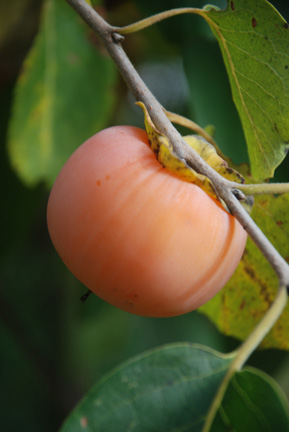 Ruby has a very large fruit for an American persimmon. Ripening here from August to November with most of it's fruit ripening later than Weber, Yates and Meader. Late enough that Yates and Weber are done. Leaves resist spotting in the fall. The prettiest ornamental persimmon in our orchard. Self-fertile. Space 14' circle. Zones 5-8.
Ruby has a very large fruit for an American persimmon. Ripening here from August to November with most of it's fruit ripening later than Weber, Yates and Meader. Late enough that Yates and Weber are done. Leaves resist spotting in the fall. The prettiest ornamental persimmon in our orchard. Self-fertile. Space 14' circle. Zones 5-8.
View detailed information
|
| Meader American Persimmon - Diospyrus virginiana |
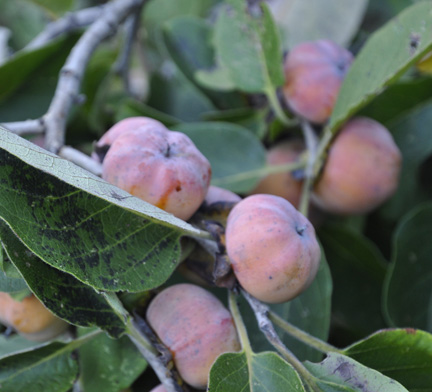 Very early ripening September through November at the nursery. Extremely cold-hardy, originally from Rochester, New Hampshire. Self-fertile, some fruits seedless, native American variety. Pumpkin- orange colored fruits are 1 1/2" to 2" in diameter. Originally from NH. Space 10' - 12' circle Zones 4-8.
Very early ripening September through November at the nursery. Extremely cold-hardy, originally from Rochester, New Hampshire. Self-fertile, some fruits seedless, native American variety. Pumpkin- orange colored fruits are 1 1/2" to 2" in diameter. Originally from NH. Space 10' - 12' circle Zones 4-8.
View detailed information
|
| Yates American Persimmon - Diospyrus virginiana |
 Yates have very large fruits for a native persimmon, 2 1/2" in diameter. Ripening late August- September. Very productive. Self fertile. Discovered by Ed Yates of Cincinnati, OH. Yates won first place at the Mitchell Persimmon Festival in 1983. Height 20' Space 15' circle Zones 5-8.
Yates have very large fruits for a native persimmon, 2 1/2" in diameter. Ripening late August- September. Very productive. Self fertile. Discovered by Ed Yates of Cincinnati, OH. Yates won first place at the Mitchell Persimmon Festival in 1983. Height 20' Space 15' circle Zones 5-8.
View detailed information Sorry, we are currently out of this item, please check back!
|
| Rosseyanka Persimmon - D. virginiana x kaki |
 Rosseyanka is a truly amazing marriage between Asian and American Persimmons. Combining traits of both parents. More of the American parent is evident in leaf and tree form. Fruit tastes like a blend of soft Asian persimmon and ripe native persimmon. Fruits are seedless! The candy like orange fruit has a rich flavor enjoyed into the winter. Good orange leaf color in the fall. Fruit size is larger than native persimmon. Must be soft to eat. Fruits will "wrinkle" when ripe. Height 15'-25'. Space 15' circle Zones 5-8.
Rosseyanka is a truly amazing marriage between Asian and American Persimmons. Combining traits of both parents. More of the American parent is evident in leaf and tree form. Fruit tastes like a blend of soft Asian persimmon and ripe native persimmon. Fruits are seedless! The candy like orange fruit has a rich flavor enjoyed into the winter. Good orange leaf color in the fall. Fruit size is larger than native persimmon. Must be soft to eat. Fruits will "wrinkle" when ripe. Height 15'-25'. Space 15' circle Zones 5-8.
View detailed information Please contact our office to see about availability. 434.361.9134
|
| Weber American Persimmon - Diospyrus virginiana |
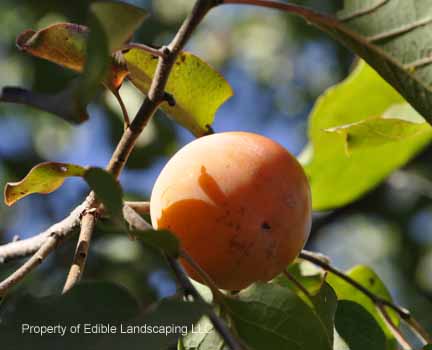 Weber came to us from Alabama. It is an early ripening Native persimmon with an enjoyable flavor and deep orange, almost red flesh. The fruits are larger than most native persimmons and ripens well before frost. Space 15' circle Zone 6-8 perhaps Zone 5
Weber came to us from Alabama. It is an early ripening Native persimmon with an enjoyable flavor and deep orange, almost red flesh. The fruits are larger than most native persimmons and ripens well before frost. Space 15' circle Zone 6-8 perhaps Zone 5
View detailed information
|
| Prok American Persimmon - Diospyros virginiana |
 Large fruiting, mild flavor, ripening very early, before fall frost at the nursery. Will drop when ready to eat. Could be the best native persimmon for the early season for sale or home use. A great choice for Zone 5 since it ripens it's fruits before it gets too cold. Space 20' circle. Zones 5-8
Large fruiting, mild flavor, ripening very early, before fall frost at the nursery. Will drop when ready to eat. Could be the best native persimmon for the early season for sale or home use. A great choice for Zone 5 since it ripens it's fruits before it gets too cold. Space 20' circle. Zones 5-8
View detailed information Sorry, we are currently out of this item, please check back!
|
Due to import restrictions we are unable to ship Persimmon, Asian to CA...
| Hachiya Asian Persimmon - Diospyros kaki |
|---|
 Hachiya is a large, top shaped fruit, up to 4" long. The fruits skin is glossy, deep orange red, and beautiful as it matures. Soft when ripe, rich and sweet and usually seedless. Ripens in the fall mid-October through November. A vigorous tree, upright and spreading up to 12 feet tall, easy to care for. This is the soft type persimmon grown in California, sold in markets and super markets across the US in the fall. In Japan it is sold as a dried fruit delicacy. Red fall leaf color. Space 12' circle Zones 7-10.
Hachiya is a large, top shaped fruit, up to 4" long. The fruits skin is glossy, deep orange red, and beautiful as it matures. Soft when ripe, rich and sweet and usually seedless. Ripens in the fall mid-October through November. A vigorous tree, upright and spreading up to 12 feet tall, easy to care for. This is the soft type persimmon grown in California, sold in markets and super markets across the US in the fall. In Japan it is sold as a dried fruit delicacy. Red fall leaf color. Space 12' circle Zones 7-10.
View detailed information
|
| Maekawa Jiro Asian Persimmon - Diospyros kaki |
 Maekawa Jiro is a small tree and grows to 12' high. Very cold-hardy. Ripe when it turns orange, Jiro can be eaten while its flesh is still firm, like an apple. Ripens early, a week or so earlier than Ichi.Fruits are large and usually seedless. A handsome yard tree. Self fertile, usually seedless. Space 12' circle. Zones 6-10.
Maekawa Jiro is a small tree and grows to 12' high. Very cold-hardy. Ripe when it turns orange, Jiro can be eaten while its flesh is still firm, like an apple. Ripens early, a week or so earlier than Ichi.Fruits are large and usually seedless. A handsome yard tree. Self fertile, usually seedless. Space 12' circle. Zones 6-10.
View detailed information Please contact our office to see about availability. 434.361.9134
|
| Ichi Ki Kei Jiro Asian Persimmon - Diospyrus kaki |
 Ichi bears large fruit, usually eaten while still firm like an apple. The tree is small, annually productive and cold hardy. Plants are self-fertile with seedless early ripening fruit. Tree shape is round and spreading, very ornamental with fruit throughout the tree. Good dwarf specimen anywhere in the yard or near the house. Has orange in leaves as far as its fall color and will hold fruits after leaves drop. Height around 8'. Space 10' circle Zones 6-8.
Ichi bears large fruit, usually eaten while still firm like an apple. The tree is small, annually productive and cold hardy. Plants are self-fertile with seedless early ripening fruit. Tree shape is round and spreading, very ornamental with fruit throughout the tree. Good dwarf specimen anywhere in the yard or near the house. Has orange in leaves as far as its fall color and will hold fruits after leaves drop. Height around 8'. Space 10' circle Zones 6-8.
View detailed information Please contact our office to see about availability. 434.361.9134
|
| Sheng Oriental Persimmon - Diospyrus kaki |
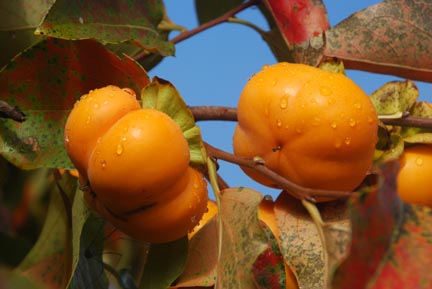 A tree of upright, irregular branches. It has exceptionally large, glossy green leaves with moderate fall coloration. Its 3-4" orange fruit is one of the largest of fine quality. Flattened square-shaped with 4 lobes, it's sweet and ready to eat when soft. Dwarf size tree. Zones 6-9.
A tree of upright, irregular branches. It has exceptionally large, glossy green leaves with moderate fall coloration. Its 3-4" orange fruit is one of the largest of fine quality. Flattened square-shaped with 4 lobes, it's sweet and ready to eat when soft. Dwarf size tree. Zones 6-9.
View detailed information
|
| Saijo Asian Persimmon さいじょ - Diospyros kaki |
 Saijo is an orange, conic-shaped fruit. The skin of the fruit has no cracks. The fruit is usually seedless and the tree has an annual bearing tendency. Ripe when soft with an elegant flavor, Saijo matures its fruit in November at the nursery. Vigorous, upright and spreading, the 15' to 20' tree.Fruits are usually seedless. It is popular in Japan to dry the fruits under the eaves of roofs. Its name is synonymous with "Mr. Elegant" or "the very best one". Space 12' circle. Zones 6-9.
Saijo is an orange, conic-shaped fruit. The skin of the fruit has no cracks. The fruit is usually seedless and the tree has an annual bearing tendency. Ripe when soft with an elegant flavor, Saijo matures its fruit in November at the nursery. Vigorous, upright and spreading, the 15' to 20' tree.Fruits are usually seedless. It is popular in Japan to dry the fruits under the eaves of roofs. Its name is synonymous with "Mr. Elegant" or "the very best one". Space 12' circle. Zones 6-9.
View detailed information Please contact our office to see about availability. 434.361.9134
|
| Great Wall Asian Persimmon - Diospyrus kaki |
 Upright, round-headed tree with excellent red fall foliage. Fruit is medium size, squarish, and slightly flattened. Trees are very productive and hardy and long lived. Fruit is of high quality, has good texture and flavor. Sweet when soft. Can be planted alone and ripens in mid-autumn. Original tree from China, introduced by former plant introduction head, and author of Tree Crops, J. Russell Smith. Height 15' Space 12' circle Zones 6-9.
Upright, round-headed tree with excellent red fall foliage. Fruit is medium size, squarish, and slightly flattened. Trees are very productive and hardy and long lived. Fruit is of high quality, has good texture and flavor. Sweet when soft. Can be planted alone and ripens in mid-autumn. Original tree from China, introduced by former plant introduction head, and author of Tree Crops, J. Russell Smith. Height 15' Space 12' circle Zones 6-9. View detailed information Please contact our office to see about availability. 434.361.9134
|
| Hira Tanenashi Asian Persimmon ひら たねなし - Diospyrus kaki |
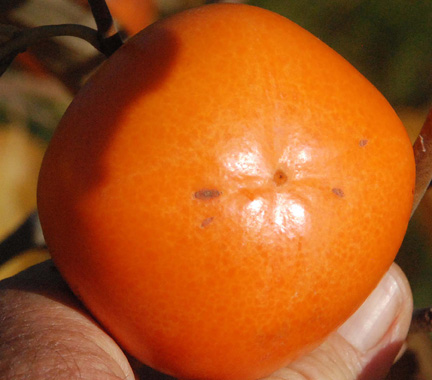 When fully dormant has stood -40 degrees F Siberian cold in northern Japan, but because of the East Coast's fluctuating springtime temperatures and late frosts, I do not recommend Hira where there are -10 degree F winters. Orange fruit, medium size, excellent quality, appealing appearance. Sweet when flesh is soft. High annual bearing, early ripening. Height around 15'. Space 12' circle. Leaves have excellent red fall color. Mostly seedless fruit. Does well in our mid Atlantic area and south to mid Florida. Zones 6-9.
When fully dormant has stood -40 degrees F Siberian cold in northern Japan, but because of the East Coast's fluctuating springtime temperatures and late frosts, I do not recommend Hira where there are -10 degree F winters. Orange fruit, medium size, excellent quality, appealing appearance. Sweet when flesh is soft. High annual bearing, early ripening. Height around 15'. Space 12' circle. Leaves have excellent red fall color. Mostly seedless fruit. Does well in our mid Atlantic area and south to mid Florida. Zones 6-9.
View detailed information
|
| Miss Kim Asian Persimmon 미쓰 김 - Diospyrus kaki |
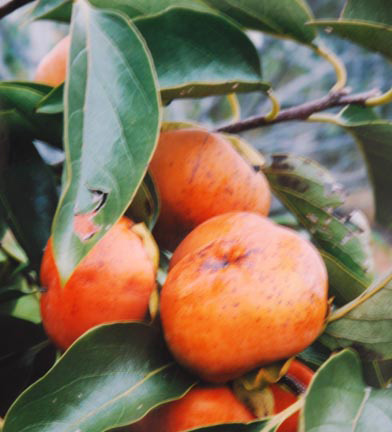 Hardy, vigorous tree. Dwarf and early ripening,from Korea. Enjoy when fruit is soft. Ripens early October and continues ripening on the tree into winter. Miss Kim has excellent flavor, red fall leaf color and fruit usually seedless. Space 10' circle Zones 6-9.
Hardy, vigorous tree. Dwarf and early ripening,from Korea. Enjoy when fruit is soft. Ripens early October and continues ripening on the tree into winter. Miss Kim has excellent flavor, red fall leaf color and fruit usually seedless. Space 10' circle Zones 6-9.
View detailed information
|
| Sung Hui Asian Persimmon - Diospyros kaki |
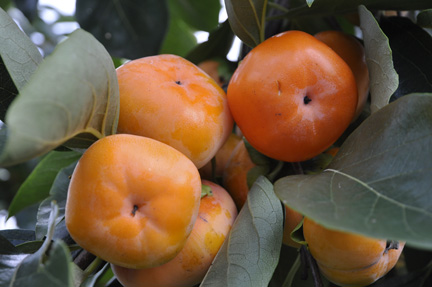 Early, sweet, juicy flavor, orange when ripe. Vigorous dwarf tree. Flat shape, square and lobed. Good fall foliage color. Fruit ripens when soft and is usually seedless. Zones 6-9.
Early, sweet, juicy flavor, orange when ripe. Vigorous dwarf tree. Flat shape, square and lobed. Good fall foliage color. Fruit ripens when soft and is usually seedless. Zones 6-9.
View detailed information
|
| Tecumseh Oriental Persimmon - Diospyrus Kaki |
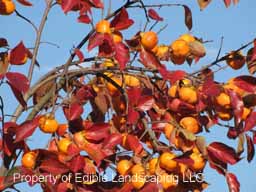 Tecumseh is a small tree type Asian persimmon named and selected by Dr. Jim Shanks, U of MD. Probably a seedling of Great Wall, it is very hardy and produces its soft when ripe fruits late into the winter. Fruits hold on the tree into Jan-Feb. Fruits are good fresh, dried, or frozen. Tree is dependable and long lived and very productive. Space 15' circle Zone 6-8
Tecumseh is a small tree type Asian persimmon named and selected by Dr. Jim Shanks, U of MD. Probably a seedling of Great Wall, it is very hardy and produces its soft when ripe fruits late into the winter. Fruits hold on the tree into Jan-Feb. Fruits are good fresh, dried, or frozen. Tree is dependable and long lived and very productive. Space 15' circle Zone 6-8
View detailed information Please contact our office to see about availability. 434.361.9134
|
| Giombo Persimmon - Diospyros kaki |
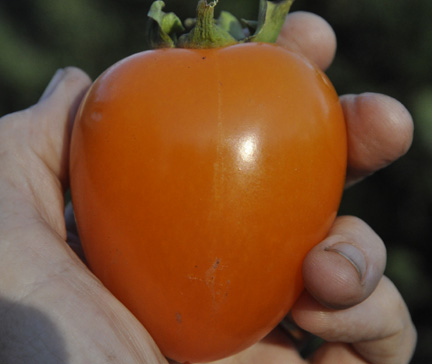 Giombo is a very large, excellent tasting, soft when ripe Asian persimmon. This medium size tree, about 15', can produce softball size fruit. The texture and sweetness is of very high quality. Leaves turn red in the fall. An excellent choice for the deep south and South Texas. Two of our customers from Texas have told us it is their favorite out of several varieties. Usually seedless, Giombo ripens late and the tree is ornamental. Has ripened well at our nursery. Space 12' to 15' circle. Zone 7-9
Giombo is a very large, excellent tasting, soft when ripe Asian persimmon. This medium size tree, about 15', can produce softball size fruit. The texture and sweetness is of very high quality. Leaves turn red in the fall. An excellent choice for the deep south and South Texas. Two of our customers from Texas have told us it is their favorite out of several varieties. Usually seedless, Giombo ripens late and the tree is ornamental. Has ripened well at our nursery. Space 12' to 15' circle. Zone 7-9
View detailed information
|
| Imoto Fuyu Asian Persimmon - Diospyrus kaki |
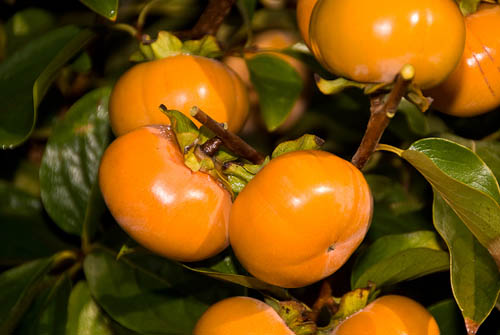 Large, square, flattened fruits turning dark orange when ripe in mid-fall, mid October through November. Ripe when hard. A long season fruit requiring only 200 hours of chilling. Good for warmer climates. Can be eaten like an apple. Usually seedless. Space 10' circle Zones 6b - 9
Large, square, flattened fruits turning dark orange when ripe in mid-fall, mid October through November. Ripe when hard. A long season fruit requiring only 200 hours of chilling. Good for warmer climates. Can be eaten like an apple. Usually seedless. Space 10' circle Zones 6b - 9
View detailed information
|
| Nikitas Gift Persimmon (tm) - Diospyrus virginiana x kaki |
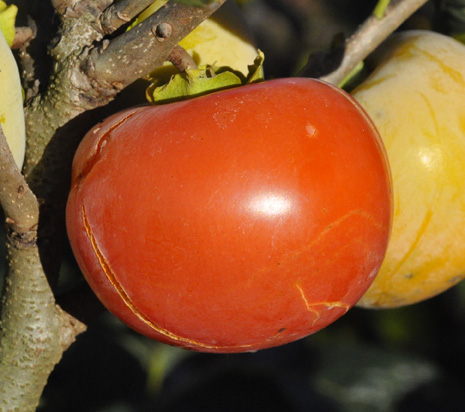 One of the top plant introductions to date, Nikitas Gift is a Russian cross of American persimmon and Asian persimmon. Hardy, small tree at 12' in height. Similar ripening habit as Rosseyanka, fall into winter, but unlike Rosseyanka, Nikita's Gift taste more like Asian persimmon. It is hardier than any of the Asian persimmons we offer. The upright self fertile tree is easy to grow and takes about a 12' circle of space. Fall color is yellow, fruit is red orange and soft when ripe. Zone 5-8
One of the top plant introductions to date, Nikitas Gift is a Russian cross of American persimmon and Asian persimmon. Hardy, small tree at 12' in height. Similar ripening habit as Rosseyanka, fall into winter, but unlike Rosseyanka, Nikita's Gift taste more like Asian persimmon. It is hardier than any of the Asian persimmons we offer. The upright self fertile tree is easy to grow and takes about a 12' circle of space. Fall color is yellow, fruit is red orange and soft when ripe. Zone 5-8
View detailed information
|
| Gil Ya Korean Persimmon 길 아 - Diospyrus kaki |
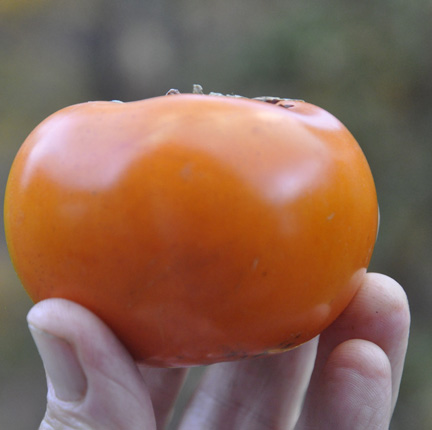 Gil Ya is our earliest ripening Asian persimmon. The small tree is a soft when ripe variety with excellent flavor. Ripens here October to early November. Zones 6-8 Space 12' circle
Gil Ya is our earliest ripening Asian persimmon. The small tree is a soft when ripe variety with excellent flavor. Ripens here October to early November. Zones 6-8 Space 12' circle
View detailed information
|
Due to import restrictions we are unable to ship Plums to CA, WA, Europe...
| Bruce Plum - Prunus salicina X angustifolia |
|---|
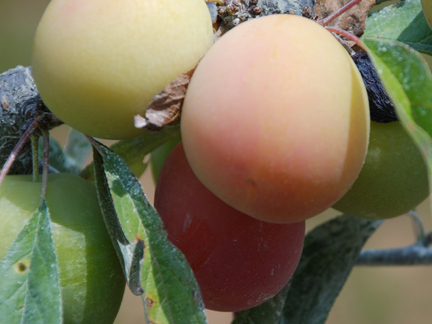 Early fruiting open spreading small tree. A cross between Japanese plum and native Chickasaw.Ripens before Methley. Pollinate with another Japanese plum such as Methley or All Red. Brown rot resistant. Introduce in 1921 by A. L. Bruce of Donelly County, TX. Zone 6-8. Space 8-10' circle
Early fruiting open spreading small tree. A cross between Japanese plum and native Chickasaw.Ripens before Methley. Pollinate with another Japanese plum such as Methley or All Red. Brown rot resistant. Introduce in 1921 by A. L. Bruce of Donelly County, TX. Zone 6-8. Space 8-10' circle
View detailed information Please contact our office to see about availability. 434.361.9134
|
| Stanley Prune Plum - Prunus domestica |
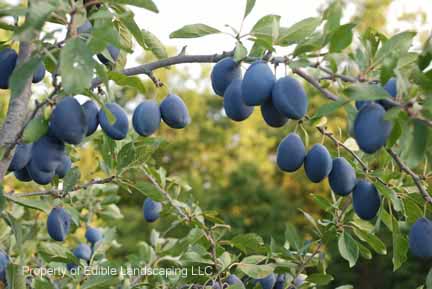 Stanley is a European self-fertile blue plum with golden flesh. A small disease-resistant tree ripening in August. Very sweet eaten fresh. We spray Surround to control plum cuculio larve in fruits in early spring. White flowers bloom later than Japanese plums. Besides being a fresh fruit, Stanley can be prunes too. They have a dryer flesh than Japanese plums and are used for this purpose. Height 8'-12' Space 8' circle Zones 5-7.
Stanley is a European self-fertile blue plum with golden flesh. A small disease-resistant tree ripening in August. Very sweet eaten fresh. We spray Surround to control plum cuculio larve in fruits in early spring. White flowers bloom later than Japanese plums. Besides being a fresh fruit, Stanley can be prunes too. They have a dryer flesh than Japanese plums and are used for this purpose. Height 8'-12' Space 8' circle Zones 5-7.
View detailed information Please contact our office to see about availability. 434.361.9134
|
| Hollywood Purple-Leaf Plum - P.C.Atropurpurea' x P. salicina |
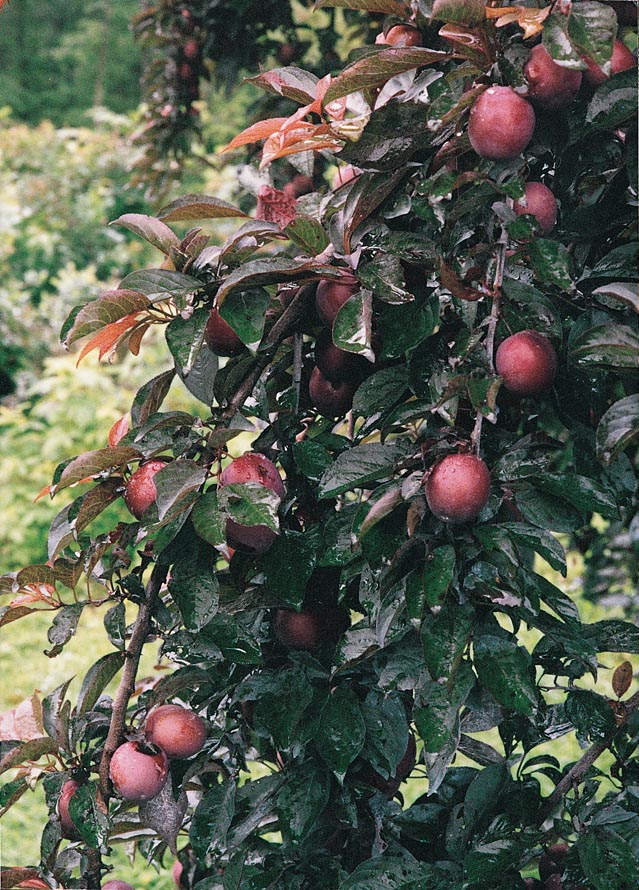 Hollywood fruits abundantly, ripens a month or so later than All Red, usually in August here. Fruit has beautiful purplish-red flesh, firm and juicy texture. One of the prettiest purple-leaf plum trees with a copper colored cast to the purple leaves on a compact tree. Height around 10' to 12'. Pollinate with All Red, Methley, Bruce or Stanley. Plum. Seems to be a cross of Japanese and European plums. Zone 5-9.
Hollywood fruits abundantly, ripens a month or so later than All Red, usually in August here. Fruit has beautiful purplish-red flesh, firm and juicy texture. One of the prettiest purple-leaf plum trees with a copper colored cast to the purple leaves on a compact tree. Height around 10' to 12'. Pollinate with All Red, Methley, Bruce or Stanley. Plum. Seems to be a cross of Japanese and European plums. Zone 5-9.
View detailed information
|
| Methley Plum - Prunus saliciina |
 Methley is a Japanese purple red plum with red flesh that is delicious fresh. Seed adheres to the flesh. Very productive doing better than most plums in warmer climates, even Hawaii. The small tree is disease resistant and a good choice for organic growers. Can produce fruit when planted alone and pollinates other Japanese plums. Space 12' circle. Zones 5-9
Methley is a Japanese purple red plum with red flesh that is delicious fresh. Seed adheres to the flesh. Very productive doing better than most plums in warmer climates, even Hawaii. The small tree is disease resistant and a good choice for organic growers. Can produce fruit when planted alone and pollinates other Japanese plums. Space 12' circle. Zones 5-9
View detailed information Please contact our office to see about availability. 434.361.9134
|
| Beach Plum - Prunus maritima |
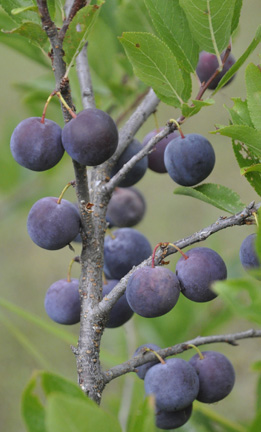 Beach Plums are native to the northeastern US along the coast. Adaptable, we've grown them for years at the nursery. Fruits are tart and many, used in jams and jellies. In the kitchen the fruit is similar to cherries and can be pitted with a cherry pitter. The white profuse flowers bloom later than European, American, and Japanese plums. So, they escape late frosts and are usually not a host for plum cucurlio. They have finished their egg laying cycle by the time the beach plum sets its fruit. They also are free of brown rot fungus on the fruits. Plants are shrubs 6' tall and wide. They require little maintenance and are long lived. Best to plant 2 for pollination. Zones 5-7
Beach Plums are native to the northeastern US along the coast. Adaptable, we've grown them for years at the nursery. Fruits are tart and many, used in jams and jellies. In the kitchen the fruit is similar to cherries and can be pitted with a cherry pitter. The white profuse flowers bloom later than European, American, and Japanese plums. So, they escape late frosts and are usually not a host for plum cucurlio. They have finished their egg laying cycle by the time the beach plum sets its fruit. They also are free of brown rot fungus on the fruits. Plants are shrubs 6' tall and wide. They require little maintenance and are long lived. Best to plant 2 for pollination. Zones 5-7
View detailed information Please contact our office to see about availability. 434.361.9134
|
| President Plum - Prunus domestica |
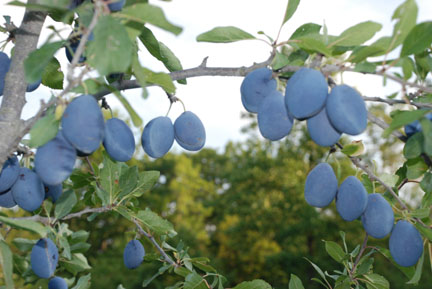 The latest maturing of the European-type plums. President is a large, dark blue freestone plum with attractive orange flesh. Resistant to black-knot disease. Pollinates with Stanley. Will set fruit alone. Space 12' circle Zones 5-9
The latest maturing of the European-type plums. President is a large, dark blue freestone plum with attractive orange flesh. Resistant to black-knot disease. Pollinates with Stanley. Will set fruit alone. Space 12' circle Zones 5-9
View detailed information
|
| American Plum - Prunus americana |
|
Native small tree common to the southeast. Branching from the ground, the colonizing shrub (up to 15') bears red fruits. Self-fertile. Heavenly smell when blooming and very showy white blooms. Susceptible to plum curculio damage. Zones 5-9.
View detailed information
|
Due to import restrictions we are unable to ship Banana to HI,...
| Little Prince Super Dwarf Banana - Musa 'Little Prince' |
|---|
 Little Prince grows only 3-4' tall in containers or outside in frost free areas. Can produce very tasty fruit if grown outside in the warm months. Does well indoors or on a patio. It is a super dwarf selection of of Dwarf Cavandish. Care: good light, water thoroughly but never allow to sit in water. Feed balanced fertilizer that's high in potassium every few months,and protect from frost. We fruit our show plant in a 25 gallon container. This gives the plant plenty of room to produce a bunch of bananas. We let the 1st banana yellow on the plant then cut the stalk with the bananas attached and hang them in a place like a kitchen and pick them as they ripen. I'd like to see more of these beauties planted in office buildings lobbies, malls, Florida rooms, and enclosed pools. zone 9-10
Little Prince grows only 3-4' tall in containers or outside in frost free areas. Can produce very tasty fruit if grown outside in the warm months. Does well indoors or on a patio. It is a super dwarf selection of of Dwarf Cavandish. Care: good light, water thoroughly but never allow to sit in water. Feed balanced fertilizer that's high in potassium every few months,and protect from frost. We fruit our show plant in a 25 gallon container. This gives the plant plenty of room to produce a bunch of bananas. We let the 1st banana yellow on the plant then cut the stalk with the bananas attached and hang them in a place like a kitchen and pick them as they ripen. I'd like to see more of these beauties planted in office buildings lobbies, malls, Florida rooms, and enclosed pools. zone 9-10
View detailed information
|
Due to import restrictions we are unable to ship Cherries, Surinam to CA...
| Surinam Cherry - Eugenia uniflora |
|---|
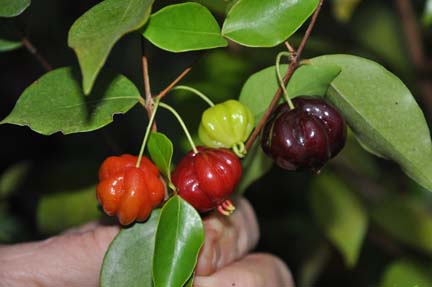 Also called pitanga. An evergreen shrub 10' in height. In spring and again in fall the Surinam cherry bears small, round fruits with eight prominent ribs. These are usually red, but are best enjoyed fresh almost black. Calling the fruit amazing does the fruit justice. They are spicy, juicy and aromatic. Use them for making an excellent jelly also. Grows in zones 9 and 10. Withstands temperatures in the low 20's. Self fruitful. An easy care greenhouse plant and because it's tropical it stays evergreen year round. These are seed grown.
Also called pitanga. An evergreen shrub 10' in height. In spring and again in fall the Surinam cherry bears small, round fruits with eight prominent ribs. These are usually red, but are best enjoyed fresh almost black. Calling the fruit amazing does the fruit justice. They are spicy, juicy and aromatic. Use them for making an excellent jelly also. Grows in zones 9 and 10. Withstands temperatures in the low 20's. Self fruitful. An easy care greenhouse plant and because it's tropical it stays evergreen year round. These are seed grown.View detailed information
|
Due to import restrictions we are unable to ship Citrus to AZ, CA, FL, HI, PR, TX, VI or Europe...
| Meiwa Sweet Kumquat - Fortunella japonica |
|---|
 Beautiful quarter-size, bright orange fruit cover a lush, dense small tree. Ideal for container planting. The best fresh eating kumquat. Usually called the "sweet" kumquat. Zones 8b-10.
Beautiful quarter-size, bright orange fruit cover a lush, dense small tree. Ideal for container planting. The best fresh eating kumquat. Usually called the "sweet" kumquat. Zones 8b-10.
View detailed information Please contact our office to see about availability. 434.361.9134
|
| Improved Meyer Lemon - Citrus limonia |
 Meyer Lemon blooms early, usually fruiting the first year. Hardy to 18 degrees F and ornamental, being slightly sweet with an excellent lemon flavor. The peal is yellow-orange and very juicy. This tree is a lovely container plant and will produce well in a pot. For planting outside in marginal citrus zones like 8b choose Meyer Lemon grafted on trifoliate orange. For pots choose macrophylla or rooted on its own roots.Zones 8b-10.
Meyer Lemon blooms early, usually fruiting the first year. Hardy to 18 degrees F and ornamental, being slightly sweet with an excellent lemon flavor. The peal is yellow-orange and very juicy. This tree is a lovely container plant and will produce well in a pot. For planting outside in marginal citrus zones like 8b choose Meyer Lemon grafted on trifoliate orange. For pots choose macrophylla or rooted on its own roots.Zones 8b-10.
View detailed information Please contact our office to see about availability. 434.361.9134
|
| Kaffir Lime - Cirus hystrix |
 Popular in Thai and Cambodian cooking. The fresh and dried leaves impart a pleasant citrus flavor when added to soups and curries. The fruit rind is candied or dried and used in curry pastes. The fruits are eaten with fish or made into drinks. Zone 9-10.
Popular in Thai and Cambodian cooking. The fresh and dried leaves impart a pleasant citrus flavor when added to soups and curries. The fruit rind is candied or dried and used in curry pastes. The fruits are eaten with fish or made into drinks. Zone 9-10.
View detailed information
|
| Flying Dragon Trifoliate Orange - Citrus trifoliata L. var. monstrosa T. |
 Flying Dragon's thorns are long and curved, plant is small (up to 6'). Extremely ornamental with corkscrew growth habit. A show-stopper at the nursery, especially with it's display of orange fruit in the fall! No insect or disease problems. We make citrus-ade from the juice, adding sweetener and water. Fruits are highly aromatic.The Japanese name for them is "Karatachi". There is even a Japanese folk song named "karatachi". A small jar filled karatachi fruit seeped with honey provides a sweet liquid that makes a great topping for yogurt... or a spoonful in hot water is a delightful tea. Fruits are inferior to lemons, being seedy, resin-like, and not juicy. Not to be eaten whole fresh. Will take below zero temperatures planted in the ground, so it is the hardiest of citrus along with the straight thorn Poncirus. Can be made into a prize-winning bonsai. Not restricted for us to send this citrus(Poncerus) to Texas. Space 7' circle Height 6'. Zones 6-9.
Flying Dragon's thorns are long and curved, plant is small (up to 6'). Extremely ornamental with corkscrew growth habit. A show-stopper at the nursery, especially with it's display of orange fruit in the fall! No insect or disease problems. We make citrus-ade from the juice, adding sweetener and water. Fruits are highly aromatic.The Japanese name for them is "Karatachi". There is even a Japanese folk song named "karatachi". A small jar filled karatachi fruit seeped with honey provides a sweet liquid that makes a great topping for yogurt... or a spoonful in hot water is a delightful tea. Fruits are inferior to lemons, being seedy, resin-like, and not juicy. Not to be eaten whole fresh. Will take below zero temperatures planted in the ground, so it is the hardiest of citrus along with the straight thorn Poncirus. Can be made into a prize-winning bonsai. Not restricted for us to send this citrus(Poncerus) to Texas. Space 7' circle Height 6'. Zones 6-9.
View detailed information
|
| Trifoliate Orange - Poncerus trifoliata |
 The Japanese name for them is "Karatachi". There is even a Japanese folk song named "Karatachi". A small jar filled karatachi fruit seeped with honey provides a sweet liquid that makes a great topping for yogurt... or a spoonful in hot water is a delightful tea.Can be grown outside in Zone 6. Prune lower growth back to encourage canopy. Golf-ball size fruits are best used for drinks and marmalade. The hardiest true citrus, though fruits are inferior to commonly known citrus, being resiny, seedy, and extremely tart. Can withstand below zero temperatures. Commonly used as a rootstock in northern citrus growing regions. Makes a very ornamental hedge which is impenetrable. Not restricted for us to send this citrus(Poncerus) to Texas. Space 7' circle Height 6'. Height 10'. Zones 6-9.
The Japanese name for them is "Karatachi". There is even a Japanese folk song named "Karatachi". A small jar filled karatachi fruit seeped with honey provides a sweet liquid that makes a great topping for yogurt... or a spoonful in hot water is a delightful tea.Can be grown outside in Zone 6. Prune lower growth back to encourage canopy. Golf-ball size fruits are best used for drinks and marmalade. The hardiest true citrus, though fruits are inferior to commonly known citrus, being resiny, seedy, and extremely tart. Can withstand below zero temperatures. Commonly used as a rootstock in northern citrus growing regions. Makes a very ornamental hedge which is impenetrable. Not restricted for us to send this citrus(Poncerus) to Texas. Space 7' circle Height 6'. Height 10'. Zones 6-9.
View detailed information
|
| Changsha Tangerine |
 One of the hardy citrus that can be grown outside in zone 8b. For trial coastal Carolina, Southern GA etc... Mandarin type, seedlings. Fruits are pleasantly sweet for a hardy citrus. They'd be a commercial fruit in the US if not for the seeds. In Devine TX, Changsha produced fruit after 16 degrees F and below freezing for 36 hours. Space 8' to 10' Height 8'
One of the hardy citrus that can be grown outside in zone 8b. For trial coastal Carolina, Southern GA etc... Mandarin type, seedlings. Fruits are pleasantly sweet for a hardy citrus. They'd be a commercial fruit in the US if not for the seeds. In Devine TX, Changsha produced fruit after 16 degrees F and below freezing for 36 hours. Space 8' to 10' Height 8'
View detailed information
|
| Yuzu Hardy Citrus - C. ichangensis x C. reticulata var. austera |
 Yuzu is a naturally occurring hybrid long cultivated in China and Japan for its useful fruits. In their native environment these evergreens often withstand temperatures dipping into the teens or lower. Supposedly, Yuzu, can endure lows approaching 0 degrees F. Some sources say 15 degrees F. Zone 8 - 10.
Yuzu is a naturally occurring hybrid long cultivated in China and Japan for its useful fruits. In their native environment these evergreens often withstand temperatures dipping into the teens or lower. Supposedly, Yuzu, can endure lows approaching 0 degrees F. Some sources say 15 degrees F. Zone 8 - 10.View detailed information
|
| Coffee - Coffee arabica |
|---|
 Coffee is a small tropical bush that makes a lovely container plant resembling gardenia. The white flowers are quite showy but short lived. The fruits mature to a vivid red. Beans are harvested, roasted and ground for coffee. The leaves which contain caffeine and are used as a tea substitute. An indoor plant can produce enough beans for roasting and the berries are edible. The indoor plant doesn't need direct sun and can be situated in the middle of the room. A terracotta pot works best indoors and shade is important outdoors. 3 gallon pot shown in photo. Zones 9-10.
Coffee is a small tropical bush that makes a lovely container plant resembling gardenia. The white flowers are quite showy but short lived. The fruits mature to a vivid red. Beans are harvested, roasted and ground for coffee. The leaves which contain caffeine and are used as a tea substitute. An indoor plant can produce enough beans for roasting and the berries are edible. The indoor plant doesn't need direct sun and can be situated in the middle of the room. A terracotta pot works best indoors and shade is important outdoors. 3 gallon pot shown in photo. Zones 9-10.
View detailed information
|
Due to import restrictions we are unable to ship Jaboticaba to CA...
| Jaboticaba - Myrciana cauliflora |
|---|
 Jaboticaba is an excellent black fruit, tasting like grapes. Everbearing, contorted branching evergreen reminiscent of ornamental fig. Does very well in containers. Jaboticaba is good for bonsai. Outdoor spacing 10'. Self-fertile Zones 9-10.
Jaboticaba is an excellent black fruit, tasting like grapes. Everbearing, contorted branching evergreen reminiscent of ornamental fig. Does very well in containers. Jaboticaba is good for bonsai. Outdoor spacing 10'. Self-fertile Zones 9-10.
View detailed information Please contact our office to see about availability. 434.361.9134
|
| Jersey Knight Male Asparagus - Asparagus officnalis |
|---|
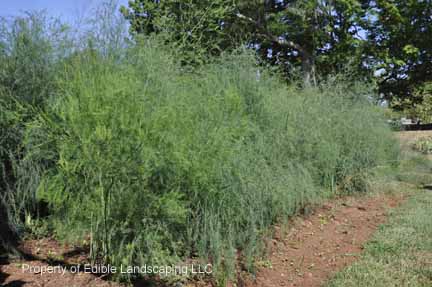 Jersey Knight asparagus have extra large sprouts since no plant energy goes into seed production. Highly productive male plants are disease resistant, and adaptable. Jersey Knight can yield 3 times the sprouts older varieties did. Jersey Knight tolerates heat,clay soil,winter temperatures,and tolerates fusarium,crown rot, and rust. Perennial beds of asparagus lasts for years. Plant site should have good drainage. Space plants 18" apart in 3' wide perennial beds. Usually our 2 inch potted asparagus are harvest-able the following season. Do not go to the trouble of digging ditches for the plants. Just plant them in your prepared bed as any other potted plant. A mulch is good for keeping weeds down. After harvest the four foot tall plants are pretty with their fine fern like appearance. Zones 3-10.
Jersey Knight asparagus have extra large sprouts since no plant energy goes into seed production. Highly productive male plants are disease resistant, and adaptable. Jersey Knight can yield 3 times the sprouts older varieties did. Jersey Knight tolerates heat,clay soil,winter temperatures,and tolerates fusarium,crown rot, and rust. Perennial beds of asparagus lasts for years. Plant site should have good drainage. Space plants 18" apart in 3' wide perennial beds. Usually our 2 inch potted asparagus are harvest-able the following season. Do not go to the trouble of digging ditches for the plants. Just plant them in your prepared bed as any other potted plant. A mulch is good for keeping weeds down. After harvest the four foot tall plants are pretty with their fine fern like appearance. Zones 3-10.
View detailed information
|
| Jerusalem Artichoke (Sunchoke) - Helianthus tuberosus |
|---|
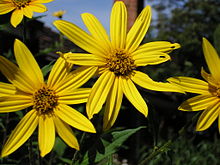 Jerusalem Artichoke, also called Sunchoke, is a tall perennial in the sunflower family, with edible tubers high in vitamins and minerals. Sunchoke is not a traditional artichoke. Long lived plants have annual harvests. Tubers are harvested in fall through winter. Space 3' circle. Sunchoke tubers are sold in 1/2lb.(8oz.) bags ready for planting. Zones 4-9
Jerusalem Artichoke, also called Sunchoke, is a tall perennial in the sunflower family, with edible tubers high in vitamins and minerals. Sunchoke is not a traditional artichoke. Long lived plants have annual harvests. Tubers are harvested in fall through winter. Space 3' circle. Sunchoke tubers are sold in 1/2lb.(8oz.) bags ready for planting. Zones 4-9
View detailed information
|
| Groundnut - Apios Americana |
|---|
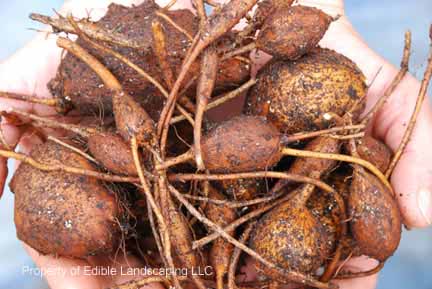 A graceful native tuber producing perennial vine of twining habit, blooming fragrant maroon chocolate flowers. Usually dug up in the winter months, the sweet, starchy tubers are eaten raw, boiled, fried, roasted or otherwise prepared like potatoes. Our plants are a strain from LSU (Blackman) superior cultivars with large tubers. Zone 6-8.
A graceful native tuber producing perennial vine of twining habit, blooming fragrant maroon chocolate flowers. Usually dug up in the winter months, the sweet, starchy tubers are eaten raw, boiled, fried, roasted or otherwise prepared like potatoes. Our plants are a strain from LSU (Blackman) superior cultivars with large tubers. Zone 6-8.
View detailed information
|
| Victoria Rhubarb - Rheum rhaponticum |
|---|
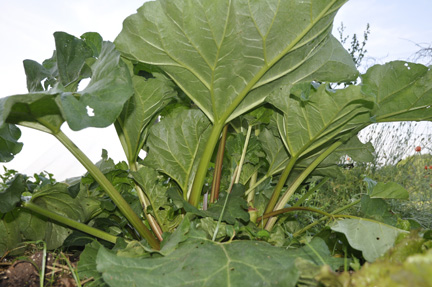 Seed grown Victoria has large green stalks, stained red. Extremely heavy producer. Space 2' - 3' circle. It is a perennial large leaved plant, pretty in its season. Good for borders or vegetable garden beds. In our area try cutting seed stalk before it shoots up in early spring. This will give a larger spring harvest. Zones 3-9.
Seed grown Victoria has large green stalks, stained red. Extremely heavy producer. Space 2' - 3' circle. It is a perennial large leaved plant, pretty in its season. Good for borders or vegetable garden beds. In our area try cutting seed stalk before it shoots up in early spring. This will give a larger spring harvest. Zones 3-9.
View detailed information Sorry, we are currently out of this item, please check back!
|
| Crimson Red Rhubarb - Rheum rhaponticum |
 Considered a sweet rhubarb variety. Crimsom Red is a cloned variety of rhubarb, not from seed. Grows true to type and ensures the size, flavor and color of Crimson Red - the best of 25 varieties in impartial tests. Most rhubarb varieties show their red coloring only at the bottom of the stalks. With pure-bred plants, the color goes all the way up the stalk like ruby chard, and continues into the stalk. Redness may vary from northern to southern growing conditions. Plants are hardy into Canada (ideal for Zones 4-7) Zones 4-9 Space 2-3' circle
Considered a sweet rhubarb variety. Crimsom Red is a cloned variety of rhubarb, not from seed. Grows true to type and ensures the size, flavor and color of Crimson Red - the best of 25 varieties in impartial tests. Most rhubarb varieties show their red coloring only at the bottom of the stalks. With pure-bred plants, the color goes all the way up the stalk like ruby chard, and continues into the stalk. Redness may vary from northern to southern growing conditions. Plants are hardy into Canada (ideal for Zones 4-7) Zones 4-9 Space 2-3' circle
View detailed information Sorry, we are currently out of this item, please check back!
|
Due to import restrictions we are unable to ship Flowers to PR,...
| Passion Flower Vine - Passiflora incarnata |
|---|
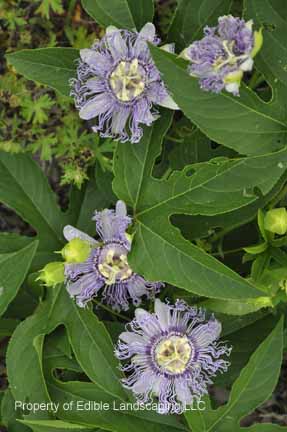 The passion flower is a perennial vine with lacy, twining foliage and large showy flowers. Very hardy, native to eastern U.S. Freezes back to the ground in winter but vigorously grows from the ground annually. Flowers and fruits each season. Flowers are lemon-musk scented. Light green fruits have a tart apricot flavor and can be made into a delicious drink with the unmistakable passion fruit flavor. (re; Hawaiian Punch) Eat whole when they are "fall into your hand" ripe. Leaves can be cooked or eaten raw in salad. Best to plant where it can be contained, because it will come up away from itself. Native Bumble Bee is the best pollinator. Two different seedlings or two different own rooted plants may increase fruit set. Zones 6-8.
The passion flower is a perennial vine with lacy, twining foliage and large showy flowers. Very hardy, native to eastern U.S. Freezes back to the ground in winter but vigorously grows from the ground annually. Flowers and fruits each season. Flowers are lemon-musk scented. Light green fruits have a tart apricot flavor and can be made into a delicious drink with the unmistakable passion fruit flavor. (re; Hawaiian Punch) Eat whole when they are "fall into your hand" ripe. Leaves can be cooked or eaten raw in salad. Best to plant where it can be contained, because it will come up away from itself. Native Bumble Bee is the best pollinator. Two different seedlings or two different own rooted plants may increase fruit set. Zones 6-8.
View detailed information Sorry, we are currently out of this item, please check back!
|
Due to import restrictions we are unable to ship Grapes to CA, Europe, Canada (with import permit only)...
| Concord Grape - Vitus labrusca |
|---|
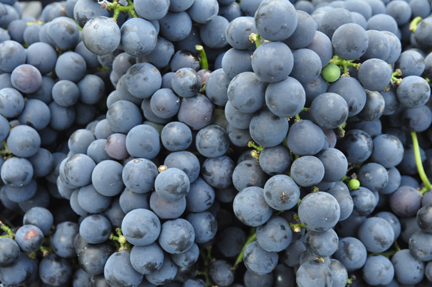 Famous Welch's grape. Concord is disease resistant and easier to grow than most grapes. May need a few sprays to look like store bought, but grapes look fine for home use. Space 8'-10' apart on trellis with 10' between rows. Grape clusters can also be bagged. Zones 5-7a.
Famous Welch's grape. Concord is disease resistant and easier to grow than most grapes. May need a few sprays to look like store bought, but grapes look fine for home use. Space 8'-10' apart on trellis with 10' between rows. Grape clusters can also be bagged. Zones 5-7a.
View detailed information
|
| Norton (Cynthiana) Grape - Vitus aestivalis hybd |
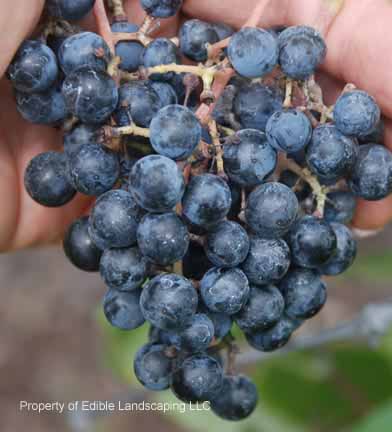 Norton has small to medium clusters which bear firm, round, black berries.A natural hybrid of Vitus labrusca and Vitus aestivalis, grown commercially in Arkansas and Missouri. Called the " Cabernet of the Ozarks" and the "organic wine grape". Norton produces a rich, medium to full bodied red wine with a dry character similar in style to Cabernet Sauvignon, but with more spice. Zones 4-8
Norton has small to medium clusters which bear firm, round, black berries.A natural hybrid of Vitus labrusca and Vitus aestivalis, grown commercially in Arkansas and Missouri. Called the " Cabernet of the Ozarks" and the "organic wine grape". Norton produces a rich, medium to full bodied red wine with a dry character similar in style to Cabernet Sauvignon, but with more spice. Zones 4-8
View detailed information Please contact our office to see about availability. 434.361.9134
|
| Villard Blanc Grape - vitis vinifera x lubrusa |
 Highly disease resistant wine grape. Good fresh eating, attractive ornamental vine. Grows from TX to NJ. One of the easiest grapes to prune since it's almost devoid of tendrils. Clusters up to 5 lbs. Space 8' to 10' on 2 wire trellis. May need sprays for black rot. The grape cluster photo included with this description was "bagged" the entire season before photo was taken. Grapes ripen late September 25th here at the nursery. Zones 7-9.
Highly disease resistant wine grape. Good fresh eating, attractive ornamental vine. Grows from TX to NJ. One of the easiest grapes to prune since it's almost devoid of tendrils. Clusters up to 5 lbs. Space 8' to 10' on 2 wire trellis. May need sprays for black rot. The grape cluster photo included with this description was "bagged" the entire season before photo was taken. Grapes ripen late September 25th here at the nursery. Zones 7-9.View detailed information
|
| Ison's Muscadine Native Grape - Vitus rotundifolia |
 Ison's is an early ripening muscadine grape. Ripens yearly at the nursery with no insect or disease spraying. Large black sweet fruit with tart skin. Very, very disease resistant. Self fertile. Native Space 4'x 8' trellis 6' tall. Zone 7-9.
Ison's is an early ripening muscadine grape. Ripens yearly at the nursery with no insect or disease spraying. Large black sweet fruit with tart skin. Very, very disease resistant. Self fertile. Native Space 4'x 8' trellis 6' tall. Zone 7-9. View detailed information
|
| Mars Seedless Grape - Vitus lubrusca hybrid |
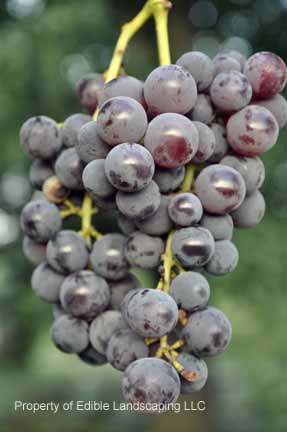 Mars is a blue seedless grape, good in hot summer areas. The most disease resistant seedless.Usually ripens in late July and usually needs to be sprayed for Black Rot. The grapes pictured were not sprayed but bagged. Space 8' apart on a 6' high trellis. Zones 4-8. Flavor similar to Concord and excellent. Texture not slip skin but thin skinned and meaty like vinifera grapes.
Mars is a blue seedless grape, good in hot summer areas. The most disease resistant seedless.Usually ripens in late July and usually needs to be sprayed for Black Rot. The grapes pictured were not sprayed but bagged. Space 8' apart on a 6' high trellis. Zones 4-8. Flavor similar to Concord and excellent. Texture not slip skin but thin skinned and meaty like vinifera grapes.
View detailed information
|
| Carlos Bronze Muscadine Grape - Vitus rotundifolia |
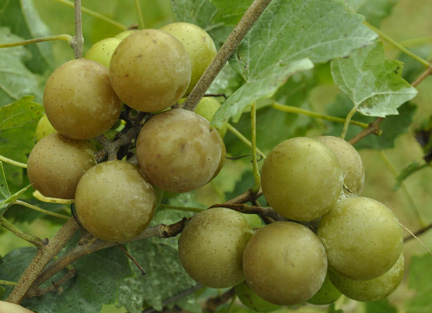 Carlos is a yellow muscadine, sweet and self-fertile with a pleasing flavor. No spraying or bagging of fruit clusters needed. Native. The most widely planted yellow muscadine in North Carolina. Space 4' x 8', trellis 6' tall. Zones 7-9.
Carlos is a yellow muscadine, sweet and self-fertile with a pleasing flavor. No spraying or bagging of fruit clusters needed. Native. The most widely planted yellow muscadine in North Carolina. Space 4' x 8', trellis 6' tall. Zones 7-9.
View detailed information
|
| Sugargate Black Muscadine Native Grape - Vitus rotundifolia |
 Fruit very large; skin dark; flavor excellent, sugar in individual berries up to 21%. Fruit ripens earliest of all our muscadines. Vigorous, productive with large clusters. Recommended by Professor John Clark, University of Arkansas grape breeding program, as a excellent grape for the homeowner. Quite a hit at the Fall Fruit Day. Sugargate is as bud hardy as Mars Seedless grape. Native Space 4' x 8' trellis 6' tall. Plant Sugargate with a perfect flowering muscadine like Carlos, Isons or Delicious cause Sugargate needs a mate. Zone 6-9.
Fruit very large; skin dark; flavor excellent, sugar in individual berries up to 21%. Fruit ripens earliest of all our muscadines. Vigorous, productive with large clusters. Recommended by Professor John Clark, University of Arkansas grape breeding program, as a excellent grape for the homeowner. Quite a hit at the Fall Fruit Day. Sugargate is as bud hardy as Mars Seedless grape. Native Space 4' x 8' trellis 6' tall. Plant Sugargate with a perfect flowering muscadine like Carlos, Isons or Delicious cause Sugargate needs a mate. Zone 6-9.
View detailed information
|
| Kay Gray Grape - Vitus lubrusca hybrid |
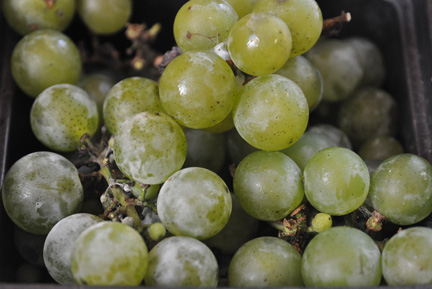 At our nursery they are sweet and very early (August 15) and very delicious. In addition to the good resistance to disease, the vine has withstood negative 42ºF without damage. The vines are vigorous. Vines can be trained to cordons with three bud spurs, or to canes to insure more crop. Liked by organic growers, the clusters are pleasant to eat. Kay Gray is a cross between MN 78 and Golden Muscat. Zone 3 - 7.
At our nursery they are sweet and very early (August 15) and very delicious. In addition to the good resistance to disease, the vine has withstood negative 42ºF without damage. The vines are vigorous. Vines can be trained to cordons with three bud spurs, or to canes to insure more crop. Liked by organic growers, the clusters are pleasant to eat. Kay Gray is a cross between MN 78 and Golden Muscat. Zone 3 - 7.
View detailed information
|
| Roucaneuf French Hybrid Grape (S.V. 12-309) - Vitus vinifera hybrid |
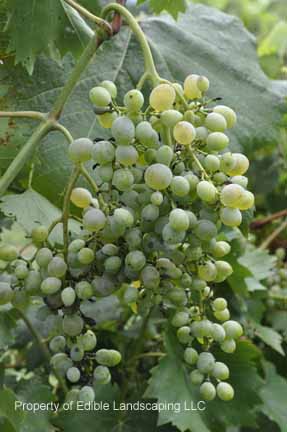 Medium size grapes with large long clusters and shiny Vinifera like leaves. Fruits ripen late. We've grown this grape for many years at the nursery. It is resistant to black rot and will grow further south since it resists Pierce's Disease. It's one of the few grapes that have softer chewable seeds. So, one can benefit from the pycnogenol in the seed white enjoying the fruit. Fruits are oval, white with a pink blush and make a white wine. Space 12' on trellis. Zone 6-8.
Medium size grapes with large long clusters and shiny Vinifera like leaves. Fruits ripen late. We've grown this grape for many years at the nursery. It is resistant to black rot and will grow further south since it resists Pierce's Disease. It's one of the few grapes that have softer chewable seeds. So, one can benefit from the pycnogenol in the seed white enjoying the fruit. Fruits are oval, white with a pink blush and make a white wine. Space 12' on trellis. Zone 6-8.View detailed information
|
| America Grape - Vitus llncecumil x Vitus rupestris |
 T. V. Munson from Dennison TX, devoted much of his life to developing grapes that would grow in his challenging area. By introducing native species into his breeding program, he bread disease resistance into his varieties. One of his grapes, America, we've grown for many years at the nursery. The blue black seeded grape has very acceptable fruit without sprays. Annually prune as Concord (long pruning). Very resistant to black rot. Flavor is very high. America has potential for Port wine or dry wine in warmer regions such as zones 7 & 8.
T. V. Munson from Dennison TX, devoted much of his life to developing grapes that would grow in his challenging area. By introducing native species into his breeding program, he bread disease resistance into his varieties. One of his grapes, America, we've grown for many years at the nursery. The blue black seeded grape has very acceptable fruit without sprays. Annually prune as Concord (long pruning). Very resistant to black rot. Flavor is very high. America has potential for Port wine or dry wine in warmer regions such as zones 7 & 8.View detailed information Please contact our office to see about availability. 434.361.9134
|
| Niagra Grape - Vitus lubrusca |
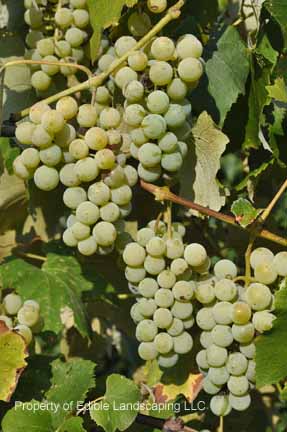 Niagra is a versatile as Concord. Welch's white grape juice is made from the fruits of this vine. Very productive and vigorous and deliciously sweet. Usually needs at least one spray for black rot or bag bunches. Space 8'in row on a 6' height trellis. Zones 3-7
Niagra is a versatile as Concord. Welch's white grape juice is made from the fruits of this vine. Very productive and vigorous and deliciously sweet. Usually needs at least one spray for black rot or bag bunches. Space 8'in row on a 6' height trellis. Zones 3-7
View detailed information
|
| Alden Grape - Vitus lubrusca hybrid |
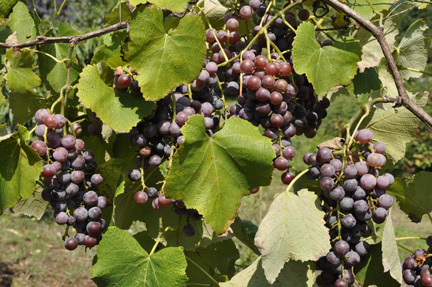 Alden is a deep blue Concord colored grape with California grape characteristics. The fruit's meaty non-slipskin texture is similar to vinifera grapes and the flavor is excellent. Joe Volk from PA (North American Fruit Explorers) felt strongly that Alden should be a part of our offerings. Usually needs spraying for black rot (at least one)or bagging of the clusters. Among the largest size grapes of the American varieties ripening a few weeks before Concord. Primarily used for fresh eating. Pruning is usually close, leaving about half the buds than a pruned Concord. Thin clusters, has a tendency to over bare. Zone 5-7 Space @ 6' apart on 6' tall trellis.
Alden is a deep blue Concord colored grape with California grape characteristics. The fruit's meaty non-slipskin texture is similar to vinifera grapes and the flavor is excellent. Joe Volk from PA (North American Fruit Explorers) felt strongly that Alden should be a part of our offerings. Usually needs spraying for black rot (at least one)or bagging of the clusters. Among the largest size grapes of the American varieties ripening a few weeks before Concord. Primarily used for fresh eating. Pruning is usually close, leaving about half the buds than a pruned Concord. Thin clusters, has a tendency to over bare. Zone 5-7 Space @ 6' apart on 6' tall trellis.
View detailed information
|
| Moored Grape - Vitus lubrusca Linne |
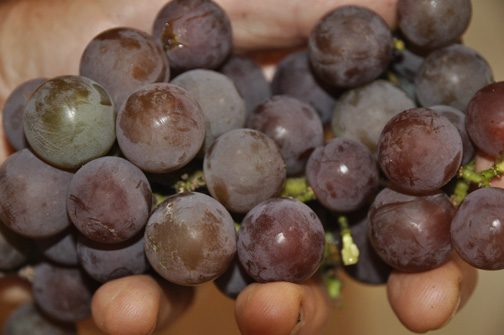 The Moored grape was named and released by Virginia Tech. This is the second grape variety resulting from the grape breeding program initiated by Professor Robert C. Moore, more than sixty years ago. It was named Moored in recognition of the many years of service given by Professor Moore to the program in fruit breeding at VT. Excellent for juice and fresh eating. Grapes are sweet with a muscat flavor. Very delicious, earlier than Concord and red. Space 10 - 12' on 6' wire trellis. Zone 5 - 8.
The Moored grape was named and released by Virginia Tech. This is the second grape variety resulting from the grape breeding program initiated by Professor Robert C. Moore, more than sixty years ago. It was named Moored in recognition of the many years of service given by Professor Moore to the program in fruit breeding at VT. Excellent for juice and fresh eating. Grapes are sweet with a muscat flavor. Very delicious, earlier than Concord and red. Space 10 - 12' on 6' wire trellis. Zone 5 - 8.View detailed information Please contact our office to see about availability. 434.361.9134
|
| Delicious Muscadine Grape - Vitis rotundifolia Michx. |
 Delicious is a new muscadine grape cultivar released by the University of Florida, that is black-fruited, early and even ripening, high-yielding, and disease-resistant. It has excellent taste and texture with an edible thin skin, making it well-suited for fresh fruit consumption. It also has potential for wine production. Self fertile. Space 15' apart on trellis.
Delicious is a new muscadine grape cultivar released by the University of Florida, that is black-fruited, early and even ripening, high-yielding, and disease-resistant. It has excellent taste and texture with an edible thin skin, making it well-suited for fresh fruit consumption. It also has potential for wine production. Self fertile. Space 15' apart on trellis.Bob Paulish, past President of the Florida Grape Grower's Association, suggested the name 'Delicious' based on the impressions of visitors to his vineyard who sampled the fruit. Zone 7 - 9. View detailed information
|
| Southern Home Grape - Vitus rotundifolia x vinifera |
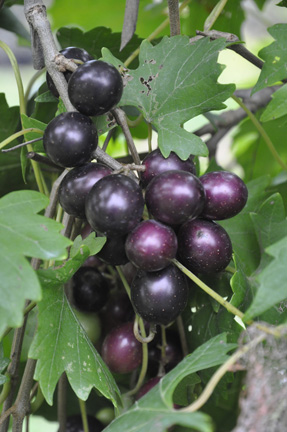 This vine is highly recommended for home plantings because it is self fertile, has good flavor, and the cut leaf pattern of the leaves is very ornamental. Compared to popular muscadine grapes it has some of the same attributes such as vigor, disease resistance and even ripening. Flavor is like muscadine. Harvest period is mid-season to late. Sugargate would be about 1 month earlier. Zone 7 - 9.
This vine is highly recommended for home plantings because it is self fertile, has good flavor, and the cut leaf pattern of the leaves is very ornamental. Compared to popular muscadine grapes it has some of the same attributes such as vigor, disease resistance and even ripening. Flavor is like muscadine. Harvest period is mid-season to late. Sugargate would be about 1 month earlier. Zone 7 - 9.
View detailed information
|
| Lenoir Grape - Vitus aestivalis hybd |
 Lenoir grape is a highly disease resistant heirloom black grape popularized in the 1830's by Nicholas Herbemont of Columbia, SC and Mr Lenoir from Statesburg, SC. Mr. Lenoir found it as a naturally occurring hybrid near the Santee River. The bunches are large, long and loose. Flavor is very good fresh. Our most disease resistant bunch grape variety. Zones 6-8 Space 8' on trellis
Lenoir grape is a highly disease resistant heirloom black grape popularized in the 1830's by Nicholas Herbemont of Columbia, SC and Mr Lenoir from Statesburg, SC. Mr. Lenoir found it as a naturally occurring hybrid near the Santee River. The bunches are large, long and loose. Flavor is very good fresh. Our most disease resistant bunch grape variety. Zones 6-8 Space 8' on trellis
View detailed information
|
Due to import restrictions we are unable to ship Kiwis - Fuzzy to Europe,...
| Elmwood Fuzzy Female Kiwi - Actinidia deliciosa |
|---|
 Elmwood is later ripening than Saanichton but usually ripens at our nursery. We pick the fruit in November. Mature fruits are picked at a 5.6 brix reading in New Zealand. It is a winter food, with a continuous supply of ripening fruit starting in November and continuing through the months of December, January, and February. Other fruits ripening at that time of year are Arkansas Black apple, Russian pomegranate, hard and soft persimmons. All of these fruits go well together for fruit salads and dishes for festive occasions. Very large fruit and large blooms. In 2010 produced 200 lbs. of fruit at the nursery. 2011, 260 lbs. The vine is big and requires spur pruning throughout the growing season. The leaves are showy and large. The best trellis is a T-trellis with a spacing of 15-18 feet between plants. Zones 7-9
Elmwood is later ripening than Saanichton but usually ripens at our nursery. We pick the fruit in November. Mature fruits are picked at a 5.6 brix reading in New Zealand. It is a winter food, with a continuous supply of ripening fruit starting in November and continuing through the months of December, January, and February. Other fruits ripening at that time of year are Arkansas Black apple, Russian pomegranate, hard and soft persimmons. All of these fruits go well together for fruit salads and dishes for festive occasions. Very large fruit and large blooms. In 2010 produced 200 lbs. of fruit at the nursery. 2011, 260 lbs. The vine is big and requires spur pruning throughout the growing season. The leaves are showy and large. The best trellis is a T-trellis with a spacing of 15-18 feet between plants. Zones 7-9
View detailed information
|
| Fuzzy Male Kiwi - Actinidia deliciosa |
 Pollinates Elmwood Fuzzy Kiwi and Saanichton and Vincent females only! Will NOT pollinate "hardy" kiwis. Zones 5-9.
Pollinates Elmwood Fuzzy Kiwi and Saanichton and Vincent females only! Will NOT pollinate "hardy" kiwis. Zones 5-9.
View detailed information
|
| Saanichton Fuzzy Kiwi - Actinidia deliciosa |
 The popular store bought Hayward usually is not adapted to East Coast conditions. Saanichton has proven itself at our nursery and is worthy of trial. An attractive vine, one of the prettiest at our nursery with very large passion flower-like blooms and fruit the size of store bought fruits. Ripens 2 weeks earlier than Elmwood. It takes our fluctuating temperatures unlike most fuzzy kiwis. Comes into bearing early, usually 1 to 2 years. A "fuzzy male" must be grown with Saanichton for fruit set. Space 15' apart. Zone 7-9.
The popular store bought Hayward usually is not adapted to East Coast conditions. Saanichton has proven itself at our nursery and is worthy of trial. An attractive vine, one of the prettiest at our nursery with very large passion flower-like blooms and fruit the size of store bought fruits. Ripens 2 weeks earlier than Elmwood. It takes our fluctuating temperatures unlike most fuzzy kiwis. Comes into bearing early, usually 1 to 2 years. A "fuzzy male" must be grown with Saanichton for fruit set. Space 15' apart. Zone 7-9.
View detailed information
|
| Matua Fuzzy Male Kiwi - Actinidia deliciosa |
 Matua male pollinates Saanichton, Elmwood and Vincent. Produces flowers one to two days earlier than other male varieties. Considered the best male pollinator for female fuzzy varieties because of its heavy flowering ability and its long duration of bloom. Since Matua needs only 100-150 hours of winter chill, it is a good pollinator for low chill female varieties.
Matua male pollinates Saanichton, Elmwood and Vincent. Produces flowers one to two days earlier than other male varieties. Considered the best male pollinator for female fuzzy varieties because of its heavy flowering ability and its long duration of bloom. Since Matua needs only 100-150 hours of winter chill, it is a good pollinator for low chill female varieties.
View detailed information
|
Due to import restrictions we are unable to ship Kiwis - Hardy to Europe,...
| Issai Hardy Female Kiwi - Actinidia arguta |
|---|
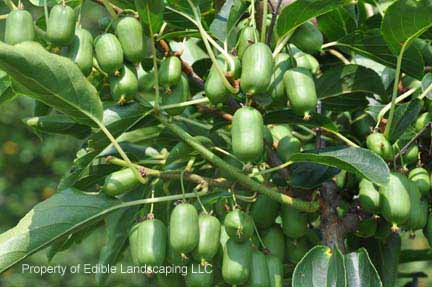 Issai has long fruits about 1.5". Issai will produce one year after planting. Sets fruits without a male, but sets more with one. Not as vigorous as most arguta types, but similar in most respects. Less pruning required because of its early fruiting and spur type growth. May not be the best choice for Gulf states because soil conditions in summer can be too hot and too wet. Plant 8' apart on 6' trellis. Zones 6-9.
Issai has long fruits about 1.5". Issai will produce one year after planting. Sets fruits without a male, but sets more with one. Not as vigorous as most arguta types, but similar in most respects. Less pruning required because of its early fruiting and spur type growth. May not be the best choice for Gulf states because soil conditions in summer can be too hot and too wet. Plant 8' apart on 6' trellis. Zones 6-9.
View detailed information Please contact our office to see about availability. 434.361.9134
|
| Kens Red Hardy Female Kiwi - Actinidia arguta x melanandra |
 Fruits turn red when ripe. Flesh is red, mild and very sweet. Since Ken's Red is a female be sure to order a male to insure fruit set. Low-chill variety. Can be grown successfully in Gulf states, where it ripens at the end of June. One of the largest hardy kiwis. Since it crops heavily, it has a tendency to alternate bear. Heavy bearing one year, little or no bearing the next. Space 10' to 15' apart on 6' tall trellis. Zones 6-9.
Fruits turn red when ripe. Flesh is red, mild and very sweet. Since Ken's Red is a female be sure to order a male to insure fruit set. Low-chill variety. Can be grown successfully in Gulf states, where it ripens at the end of June. One of the largest hardy kiwis. Since it crops heavily, it has a tendency to alternate bear. Heavy bearing one year, little or no bearing the next. Space 10' to 15' apart on 6' tall trellis. Zones 6-9.
View detailed information Please contact our office to see about availability. 434.361.9134
|
| Anna Hardy Female Kiwi (Ananasnaya) - Actinidia arguta |
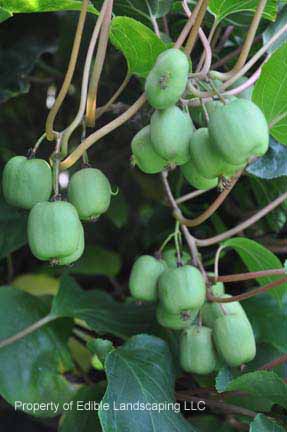 Anna's grape-size fruits hang in bunches on this most vigorous productive vine. Spacing 15' apart. A good beginner kiwi, easy to get growing. Very productive, also called Ananasnaya. The fruits are medium size and of the arguta species. Not the Russian kolomikta species with the similar name. Space on a T trellis @ 15' apart. Ripens later in the season than Dumbarton Oaks female by about 3 weeks. Very ornamental with showy red leaf stems. Needs a mate. Spur prune throughout the growing season for earlier fruiting and greatest productivity and bushy appearance. Zones 5-9.
Anna's grape-size fruits hang in bunches on this most vigorous productive vine. Spacing 15' apart. A good beginner kiwi, easy to get growing. Very productive, also called Ananasnaya. The fruits are medium size and of the arguta species. Not the Russian kolomikta species with the similar name. Space on a T trellis @ 15' apart. Ripens later in the season than Dumbarton Oaks female by about 3 weeks. Very ornamental with showy red leaf stems. Needs a mate. Spur prune throughout the growing season for earlier fruiting and greatest productivity and bushy appearance. Zones 5-9.
View detailed information
|
| Dumbarton Oaks Hardy Female Kiwi - Actindia arguta |
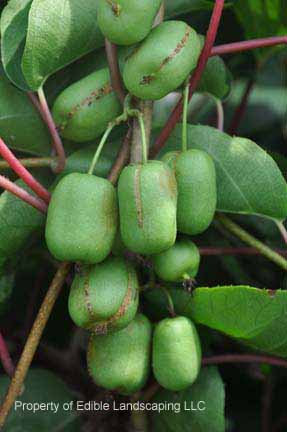 Early maturing, Dumbarton Oaks hardy kiwi ripens three weeks before Anna. One of our favorites! Original vine growing in Georgetown, Washington DC. Only Fifty Five female kiwi ripens earlier at the nursery. Space 15' apart on T trellis. Zones 5-8. (Don't forget to order a male if you don't already have one. See Hardy Male)
Early maturing, Dumbarton Oaks hardy kiwi ripens three weeks before Anna. One of our favorites! Original vine growing in Georgetown, Washington DC. Only Fifty Five female kiwi ripens earlier at the nursery. Space 15' apart on T trellis. Zones 5-8. (Don't forget to order a male if you don't already have one. See Hardy Male)
View detailed information
|
| Fortyniner Hardy Female Kiwi - Actinidia arguta |
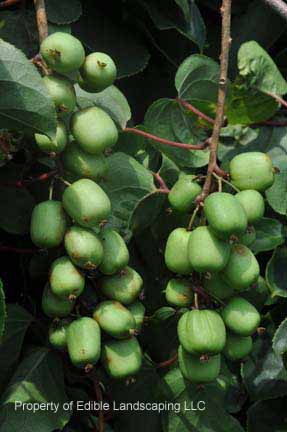 (74-49) Large-shouldered fruit. Very pretty large-leafed vine. Ripens with Geneva and Arbor-eat-um. Very productive and reliable. Zones 5-8. Space 15' apart on a 6' wire trellis.
(74-49) Large-shouldered fruit. Very pretty large-leafed vine. Ripens with Geneva and Arbor-eat-um. Very productive and reliable. Zones 5-8. Space 15' apart on a 6' wire trellis.
View detailed information
|
| Meyer's Cordifolia Hardy Female Kiwi - Actinidia arguta |
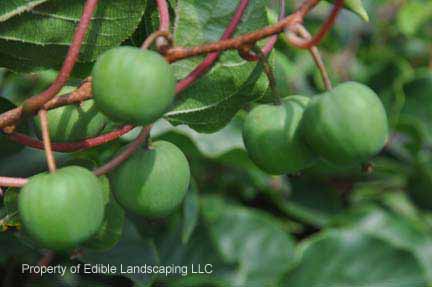 High sweetness, non-bitter skin, round-shouldered fruit. Low-chill variety and very productive, proving to be one of the best flavored. Be sure to order a male kiwi for this plant. Plant 12' apart. Zones 5-9.
High sweetness, non-bitter skin, round-shouldered fruit. Low-chill variety and very productive, proving to be one of the best flavored. Be sure to order a male kiwi for this plant. Plant 12' apart. Zones 5-9.
View detailed information Please contact our office to see about availability. 434.361.9134
|
| Arbor-eat-um NA-7 Hardy Female Kiwi - Actinidia arguta |
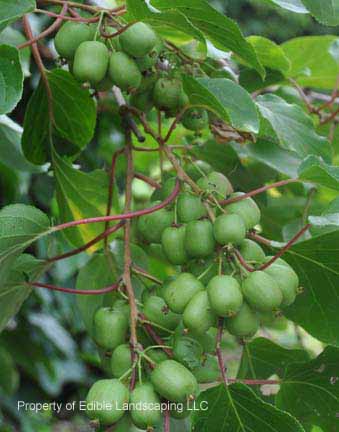 National Arboretum #7 was a female kiwi growing on the R Street fence at the National Arboretum in Washington DC. It is no longer there but fruiting at the nursery. When visitors sample the different kiwis, many fine this one their favorites.
National Arboretum #7 was a female kiwi growing on the R Street fence at the National Arboretum in Washington DC. It is no longer there but fruiting at the nursery. When visitors sample the different kiwis, many fine this one their favorites.
View detailed information
|
| Geneva Hardy Female Kiwi - Actinidia arguta |
 From the Dr. Slate collection found growing near Hedrick Hall at the Cornell Experiment Station in Geneva, New York. Has regularly produced at our nursery since 1990. Fruits are medium size, round, shouldered fruit ripening mid season after Dumbarton Oaks and before Anna. Zone 5-8. This is a female kiwi. Be sure to order a male (listed below) to cross pollinate.
From the Dr. Slate collection found growing near Hedrick Hall at the Cornell Experiment Station in Geneva, New York. Has regularly produced at our nursery since 1990. Fruits are medium size, round, shouldered fruit ripening mid season after Dumbarton Oaks and before Anna. Zone 5-8. This is a female kiwi. Be sure to order a male (listed below) to cross pollinate.
View detailed information
|
| Hardy Meader Male Kiwi - Actinidia arguta |
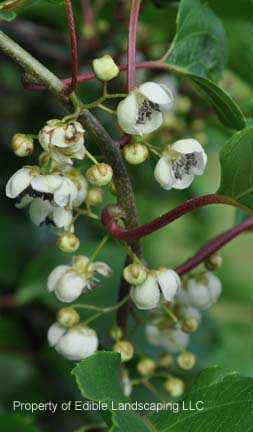 Dr. Meader, plant breeder from NH, had this male growing at his farm in Rochester, NH. Probably from Korea, this adaptable male should be spaced 15 feet on T trellis. Zones 5-8
Dr. Meader, plant breeder from NH, had this male growing at his farm in Rochester, NH. Probably from Korea, this adaptable male should be spaced 15 feet on T trellis. Zones 5-8
View detailed information
|
| MSU Female Kiwi - Actinidia arguta |
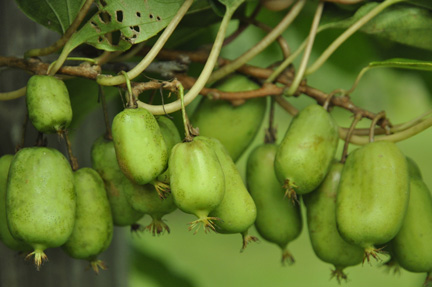 Original plant found growing on the tennis court fence at Michigan State University in the 80's by Dan Sorensen, NAFEX member and amateur fruit enthusiast. Fruits are large, oval, shaped. Also called Jumbo and Michigan. Zones 5 - 8 Spacing 15 ' on T trellis.
Original plant found growing on the tennis court fence at Michigan State University in the 80's by Dan Sorensen, NAFEX member and amateur fruit enthusiast. Fruits are large, oval, shaped. Also called Jumbo and Michigan. Zones 5 - 8 Spacing 15 ' on T trellis.
View detailed information
|
| 74-46 Hardy Male Kiwi - Actinidia arguta |
 Originally selected from a kiwi project at a USDA Chico, CA. Along with 74-32 which blooms a few days earlier, Edible Landscaping acquired its first propagating material from Dr. Milbocker, Diamond Springs Station, Virginia Beach, VA. Both males do an excellent job pollinating our hardy kiwi Actinidia arguta females. One male can pollinate up to 8 female kiwi, and the best ratio is 1 to 5. Space 15' apart on 6' high wire trellis. Zones 5-8
Originally selected from a kiwi project at a USDA Chico, CA. Along with 74-32 which blooms a few days earlier, Edible Landscaping acquired its first propagating material from Dr. Milbocker, Diamond Springs Station, Virginia Beach, VA. Both males do an excellent job pollinating our hardy kiwi Actinidia arguta females. One male can pollinate up to 8 female kiwi, and the best ratio is 1 to 5. Space 15' apart on 6' high wire trellis. Zones 5-8
View detailed information
|
| Fifty five Hardy Female Kiwi - Actinidia arguta |
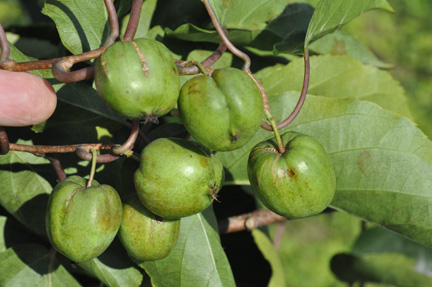 Earliest arguta to ripen in our collection. About 2-3 weeks earlier than Ken's Red or Dumbarton Oaks. Space 15' on 6' tall trellis. Ripens first fruits end of July at the nursery. Zone 5-8
Earliest arguta to ripen in our collection. About 2-3 weeks earlier than Ken's Red or Dumbarton Oaks. Space 15' on 6' tall trellis. Ripens first fruits end of July at the nursery. Zone 5-8
View detailed information Please contact our office to see about availability. 434.361.9134
|
| 74-32 Hardy Male Kiwi - Actinidia arguta |
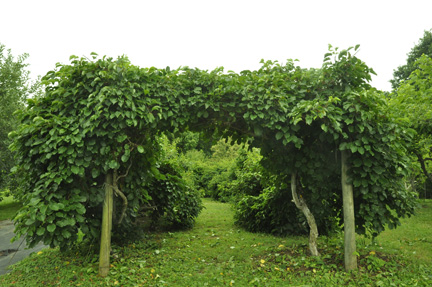 Selection from Chico, CA in 1974. Blooms a few days earlier than 74-46. Pollinates all of our Actinidia arguta varieties. Zone 5-8 Space 15' on 6' trellis
Selection from Chico, CA in 1974. Blooms a few days earlier than 74-46. Pollinates all of our Actinidia arguta varieties. Zone 5-8 Space 15' on 6' trellis
View detailed information Please contact our office to see about availability. 434.361.9134
|
| September Sun Female Kolomikta Kiwi - Actinidia kolomikta |
|---|
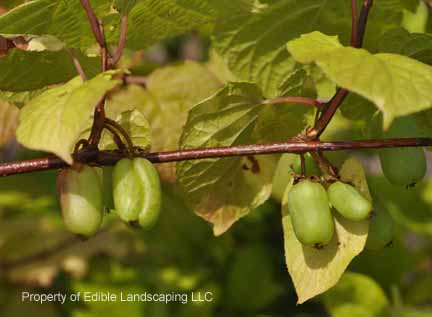 A large fruiting selection of the Russian species Actinidia kolomikta. Called Sentyabraskaya in Russia. Can be planted 6' apart and in partial shade in the Virginia area. Fruit is earlier than A. arguta and smaller. The leaves are maple red in summer and mixed with green. Hardy to -35 degrees F. Zones 4-9 Space trellised 6-10' apart (Zones 7-9 shade). Needs a Russian male!
A large fruiting selection of the Russian species Actinidia kolomikta. Called Sentyabraskaya in Russia. Can be planted 6' apart and in partial shade in the Virginia area. Fruit is earlier than A. arguta and smaller. The leaves are maple red in summer and mixed with green. Hardy to -35 degrees F. Zones 4-9 Space trellised 6-10' apart (Zones 7-9 shade). Needs a Russian male!
View detailed information Sorry, we are currently out of this item, please check back!
|
| Pasha Male Kolomikta Kiwi - Actinidia kolomikta |
|
View detailed information Please contact our office to see about availability. 434.361.9134
|
